
GARLICKY SWISS CHARD & CHICKPEA ENCHILADAS
05/01/20 — Ada Broussard
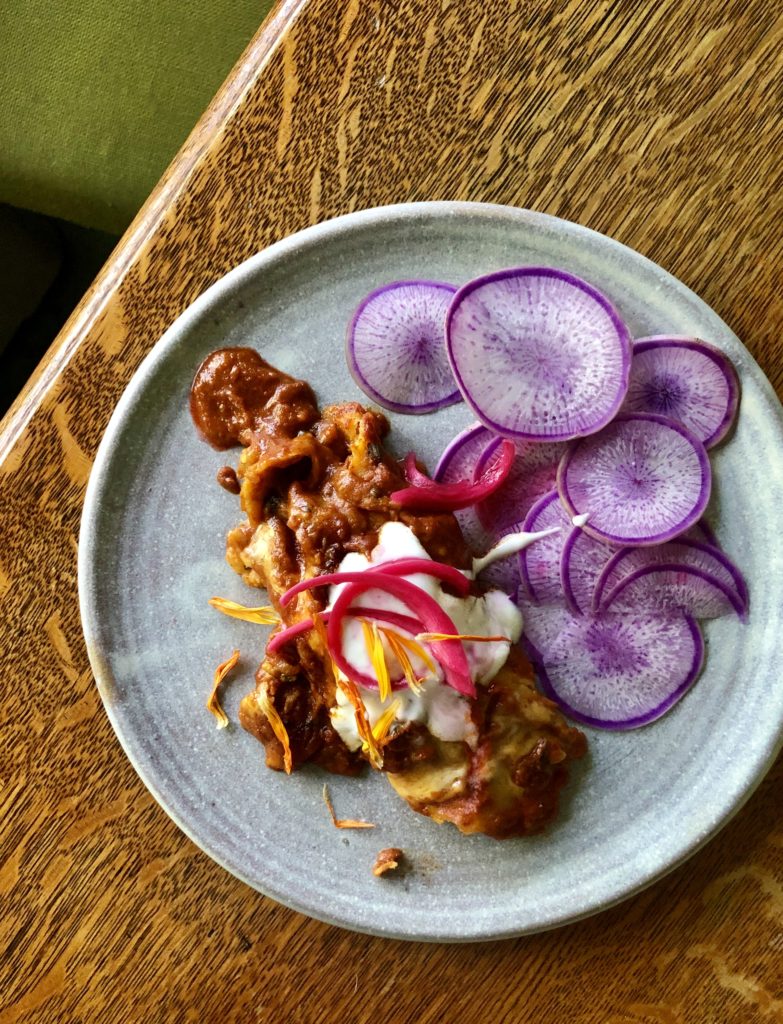
Recipe, photo, and enchilada inspiration by Mackenzie Smith. Checkout her food-centric Instagram account to see more.
Garlicky Swiss Chard & Chickpea Enchiladas
Red chile enchiladas filled with cheese have always been a major part of my diet. For special occasions and often just because, my dad serves up individual plates of NM-style flat stacked enchiladas made with dry or fresh red chiles from Chimayo, a town about 30-minutes north of Santa Fe known for producing super flavorful New Mexico chiles packed with smoky, fruity, spicy notes. When I moved to NYC in 2006, my brother Jake helped me get through my first somewhat lonely/homesick year in the city by cheering me up with our own version of Dad’s enchiladas.Back in 2006, Jake and I had a hard time getting our hands on Chimayo in the city, so we tried several different types of dried chiles from the Mexican deli on our corner. Every time we made red enchilada sauce, we’d try a different type of dried Mexican pepper, or a combination, to see how they’d turn out. Our cabinets were filled with half-opened bags of dried chiles, and we were never disappointed by our red sauce experiments. It’s hard to be mad at a sauce made of spicy red peppers, designed to cover a fried tortilla filled with cheese, with sour cream or yogurt at the ready to cut the heat from a sauce made a little too spicy. (It was never too spicy for Jake.)
I’d give an arm and a leg to have my brother safely out of Brooklyn and cooking enchiladas in my kitchen with me, and I really wish we could have driven out to my parents for Dad’s enchiladas on my birthday last month. But we are staying home and so are they. In an effort to bring some comfort to our own table last week, I made a batch of rolled enchiladas filled with swiss chard and chickpeas that was both nostalgic and nourishing.
It would be an understatement to say that we are all in a place where we could use a comforting meal right now, so I hope you can take some inspiration from my recipe and make your own version of a free-wheelin’ CSA enchilada.
This recipe is far from traditional, designed for riffing on what is available in your CSA and pantry. Frying the tortillas before rolling is not an option (this helps the tortillas from getting soggy when you bake them in sauce and cheese), and neither is a good helping of melty cheese on top, but pretty much everything else here is open for interpretation. The more veggies, the better!
I still prefer my enchilada sauce made with chiles from New Mexico, but after making it my business to try every dried pepper under the sun, I really love the idea that red sauce can be a canvas for appreciating the nuanced flavor and heat profiles from different peppers. These days, I use a variety of dried peppers with different spice levels to create a sensory experience from the sauce’s spice level in contrast to the filling, and I generally omit the traditional garlic/onion/oregano to let the peppers really do the talking because they are already so flavorful (and so is this filling).
The sauce I made last week from dried chiles and chile paste was pretty spicy, so I cooled it down with a few carrots I had roasted earlier in the week. If you don’t have dried red chiles for the sauce (or the time/energy/blender to make it from scratch) premade enchilada sauce works just as well here, and you can doctor it up with what spices and/or roasted vegetables you do have on hand. Not spicy enough? Add some sriracha or your favorite hot sauce to the mix! Have some roasted vegetables you need to consume? Blend them into your sauce.
As for the filling, any leafy green will do. If you use kale or collards, be sure to either omit the stems from the recipe depending on how tough they are, or dice them very small. If you opt for spinach, just fry the chickpeas and stir in the spinach last minute. Roasted vegetables and any type of legume are a nice way to add some heft and additional nutrients to your custom CSA enchiladas.
Makes 10-12 enchiladas
Filling Ingredients
- 2 bunches of swiss chard
- 3 tablespoons olive oil or ghee, separated
- 1/2 teaspoon whole cumin seeds
- 1/2 teaspoon whole coriander seeds (whole spices are not mandatory, but the crunch is fun! Try it!)
- 1 large can chickpeas, well drained
- 1 clove garlic
- 3/4 cup sharp cheddar cheese, shredded
Sauce Ingredients
- 14-15 dried red New Mexico or Guajillo chile, soaked in water for about an hour
- 1/4 cup aleppo pepper (this is optional!)
- 3 tablespoons Doubanjian sauce (this is also very optional! Doubanjiang sauce is a fermented fava bean / chile paste from China. It is funky and spicy and delicious, and very fun in this enchilada sauce)
- 3 medium-sized roasted carrots, cut into pieces (very optional, but a great way to use ‘em up if you need to)
- 4 cups water or stock
- 10 corn tortillas (more or less)
- 1/2 cup vegetable oil or ghee
- 1 cup shredded cheddar cheese
Filling Instructions
Remove the stems from swiss chard. Roughly dice them and cut the leaves into thin ribbons.
In a medium or large skillet, heat one tablespoon of oil until it shimmers, then add cumin and coriander seeds. Cook just until seeds start to sputter and become fragrant, about 30-45 seconds. Stir in chopped swiss chard stems and cook for a minute or so before adding two more tablespoons of oil, then the chickpeas. Cook the chickpeas and chard stems on high for 7-8 minutes until everything in the pan is sort of dry and almost crispy. Add garlic to the chickpea mixture right before you turn off the stove and stir in swiss chard leaves to the pan. Once the leaves have wilted, stir in shredded cheese.
Sauce Instructions
Add the chiles, carrots and oregano and the water to a blender and blend on high until you have a smooth, homogeneous consistency. Pour the blended chiles to a sauce pot and cook over high heat, stirring constantly until bubbles start to form around the edge of the pan. Reduce heat to medium and cook for about 30 minutes, stirring occasionally to prevent any lumps from forming. After 30 minutes, check your sauce: it should leave a thick coat on a clean spoon after a dip into the pan, but still be able to run off the spoon easily. If it’s too thick, add water. If it’s too thin, cook a little longer. Once the sauce is ready, remove from heat.
Assembly
- Preheat oven to 425
- Set up a large plate lined with paper towels to drain tortillas after they fry.
- In a skillet, heat vegetable oil until it bubbles as the edge of the tortilla touches the oil. Cook tortillas on each side until you see a little color and big bubbles start to form in the middle, 10-15 seconds per side.
- Coat a 13x9-inch casserole dish with a ladelful of enchilada sauce.
- One at a time, put a fried tortilla on the prepared casserole dish and add a few spoonfuls of filling before rolling tightly and placing in a row in the dish, seam side down.
- Once all of your enchiladas are rolled, cover them with enchilada sauce and shredded cheese.
- Bake until sauce is bubbly and cheese is melted, 15-20 minutes.
Happy cooking!
 Mackenzie and her brother, in 2009, standing in front of their favorite Mexican deli.
Mackenzie and her brother, in 2009, standing in front of their favorite Mexican deli.
FIRST FRIDAY STAFF PICKS: MAY 2020 EDITION
05/01/20 — Ada Broussard
Brenton:
For the past year or so, I've been working on this boat. And it's finally done! I've taken it out for a picnic dinner every single night this week after work. On Wednesday, we drove it for almost 20 miles - we put in at festival beach near Snake Island, then drove it all the way to the damn (near Red Bud Isle), and then back again. I've been getting a lot of looks because people don't know what to think of this frankenstein boat. It's a sailboat without a mast, and a motor attached, so the hull looks very different from the boats you would normally see on town lake.About a year ago, I bought a 1973 Johnsons outboard motor from Craiglist - it was really cheap because it had quit working. I've always wanted to outfit a motor to be electric, and so that's just what I did with this motor.. I got some help from some friends, too, welding brackets, and doing some machine work. Finally we got it working, and it's actually working better than I expected. Say hello if you see me on town lake! I'm likely to be there every evening!

Ada:
Today! Friday May, 1st, I'm teaching a seasonal meal prep class on Zoom! Tune in at 11am CST to get some meal prep tips and recipe ideas. This is the perfect class and conversation for anyone new to the CSA. To make the most of your time zooming, consider grabbing some veggies and a knife - no reason we can't all chop n' chat together! RSVP to the (free) class and get the zoom link here.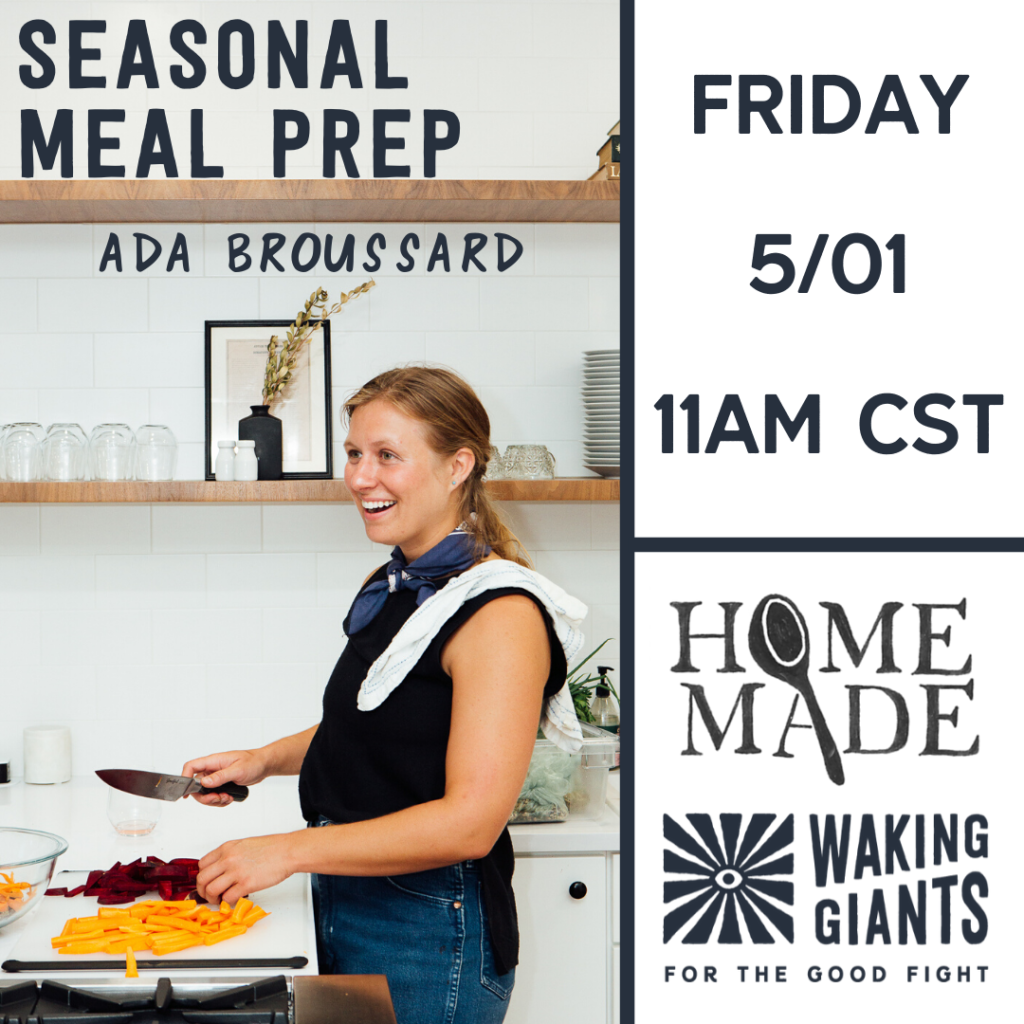
Also, my amazing sister Amelia is a high school art teacher and is co-founder of a nonprofit in New Orleans called Sketch Basin. Only 5 of 30 public high schools in New Orleans offer advanced Visual Art courses, and Sketch Basin has stepped in to help fill the void. They are currently raising money to help with next year's programming and need your help. You can donate to their organization here. Simply write "Sketch Basin" in the comment line.
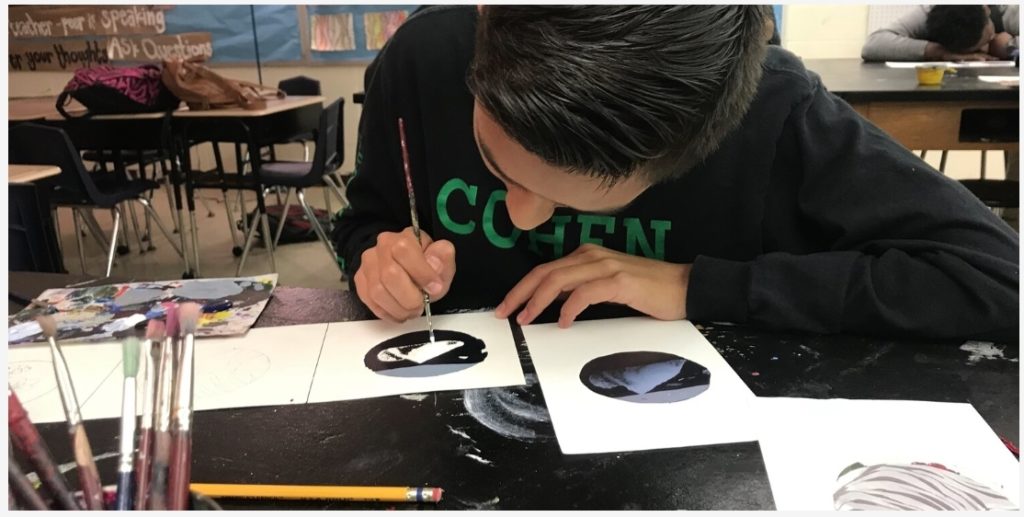 One of Sketch Basin's students. Photo courtesy of Sketch Basin website.
One of Sketch Basin's students. Photo courtesy of Sketch Basin website.
Scott:
I recently interviewed Elizabeth McQueen for my podcast, Austin Art Talk. Elizabeth is the host of This Song podcast on KUTX. She started playing with her band back in 2014, and played at quite a few farm potlucks. The interview isn't out yet, but it's not one to miss. Follow the podcast on Instagram, or just subscribe to Austin Art Talk where ever you listen to the podcasts you love. In the interview, I talk with Elizabeth about many aspects of being an artist. At the end, she answers the main question she always poses to guest on her podcast: what is a transformational song in your life? Elizabeth grooving at a JBG potluck back in 2014. Photo taken by... Scott!
Elizabeth grooving at a JBG potluck back in 2014. Photo taken by... Scott!
Andrew:
I'm hosting a local producers competition "Flippers Unite" to keep us together since we can't play shows at the moment. Sixteen local producers compete in a bracket style tournament. Each matchup features a unique sample and they make a song out of it. The community votes via Instagram on who flipped it better. A cassette tape will be made with everyone's tracks to timestamp this wild time for us and look back on something positive. It will be available on band camp for donations/pay what you want. Learn more at @lofi.kickback.atx or vote on your favorite beat on @atxrapscene .
Faith:
The We Are One film festival is something I definitely want to check out. It's a free YouTube hosted festival running from May 29th to June 7th and will feature movies from some of the top film festivals around the world. It's totally free, no ads, etc. Considering some festival films never make it to theaters, this is a super cool opportunity. Plus, they are collecting donations for the United Nations Foundation.Hector:
The Nebula Conference, one of the most prestigious sci-fi events of the year, has switched gears to happen online from May 29-31. I was planning on physically attending this year but, well, we all know how all is going. This is a great way to interact with great writers and learn about the craft.
A friend from The Philippines shared this podcast episode by Ten Percent Happier and it conveys a lot of things about We're all going through. It delves on loss but in a way where we connect with our emotions, without labeling these in punitive ways. I highly recommend you give it a listen.
Angie:
I turned this [fennel and leek gratin] recipe into a cream sauce this week and it was so dope.Lauren:
I've been making lots of pizza these days! It's both the perfect quarantine activity and a great way to use up CSA veggies. I've been using this dough recipe, which works just fine with all all-purpose flour (although if readers want to get fancy with their flour, Barton Springs Mill is still offering free shipping in Texas!). It does take 3-4 hours to rise, but that works great for my WFH life currently. As far as sauce, it's super easy to turn a can of diced tomatoes into marinara, and as far as toppings, a quick Google search showed me that there are lots of kohlrabi-on-pizza enthusiasts; I used a veggie peeler to shave one small bulb and also added sliced leeks.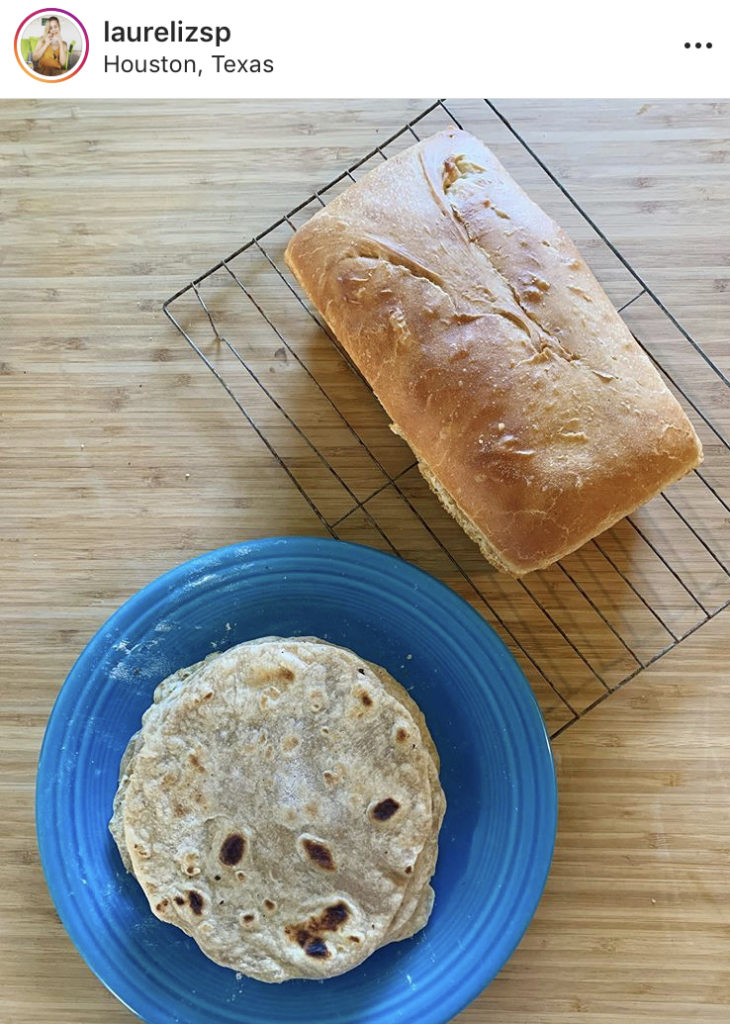 Looks like Lauren is making more than just pizza! Photo courtesy of her Instagram.
Looks like Lauren is making more than just pizza! Photo courtesy of her Instagram.
Heydon:
Some Heydon quarantine self-care: I've been adding goldmine powder to my cold brew every morning as it's supposedly very beneficial for the brain and stress relief. I just finished reading Zafon's Shadow of the Wind... beautifully written magical realism that transported me to Barcelona for some very enthralling mystery solving. I will be diving into his other books next.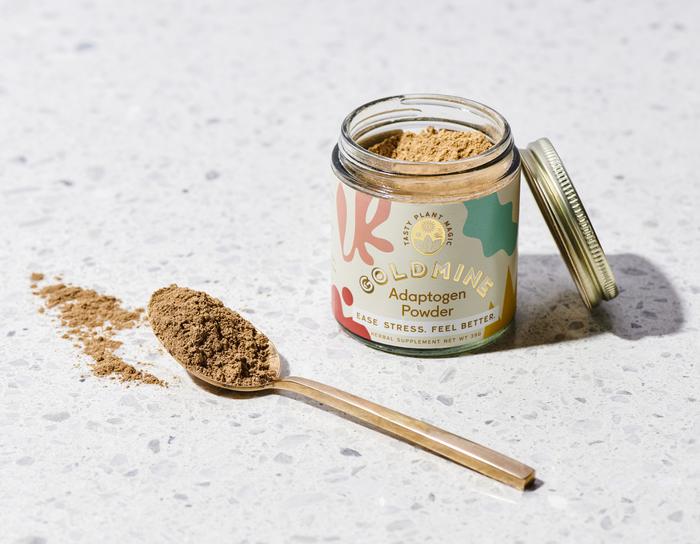 Goldmine Adaptogen Powder. Photo courtesy of Woods Apothecary, where you can order the product.
Goldmine Adaptogen Powder. Photo courtesy of Woods Apothecary, where you can order the product.
BA test kitchen everything right now. This one really made my quarantine partner and I laugh a lot. Brad Leone is just so great. I've also been making TONS of playlists. Sending a virtual hug to everyone in the JBG community!
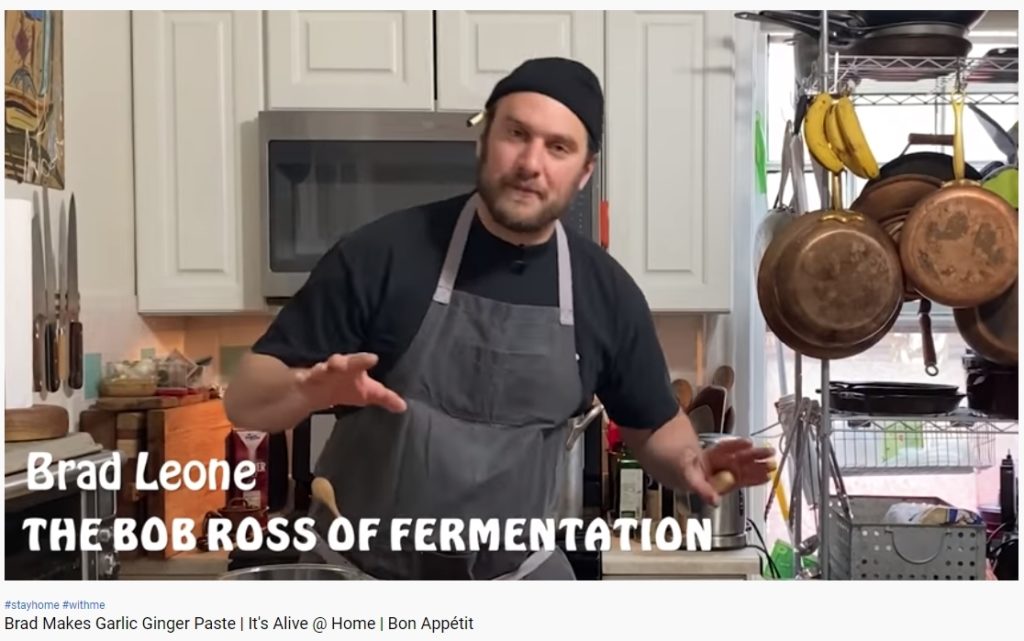 Have you met Brad? He's a great introduction into the BA Test Kitchen videos. Photo taken from Youtube.
Have you met Brad? He's a great introduction into the BA Test Kitchen videos. Photo taken from Youtube.
Oh and my dear friend, Bowman, made this amazing music video for his band.
Shiva:
Normally, I don't have anything to share, but this time I really wanted to thank everyone at JBG who are working hard to provide nutrient rich produce to folks in these times.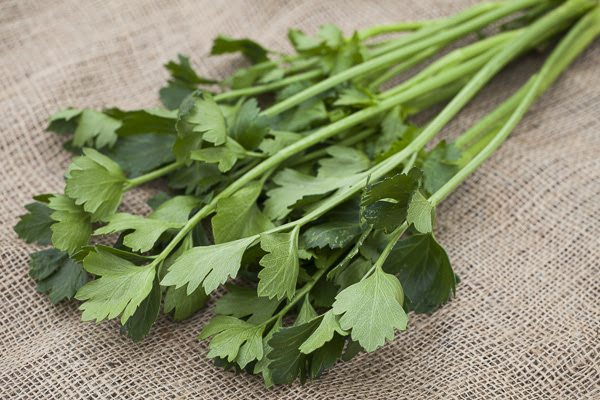
Megan:
Lately I've had a bit more time on my hands, and so have been able to update my online Vintage Shop (Loyal Vintage) with lots of thrifted treasures that I added to the collection, pre-covid. Checkout my Etsy for lots of wonderful new listings!
Charity:
I am currently looking to doing things more in nature and how we used to do things. Such as gardening, making butter from fresh cream, exploring hiking trails, slowing down to really pay attention to what my mind & body are telling me. Nothing like being present and getting creative with the world around us.The Farm:
There has been a lot to love the past month. Sometimes we post something to social media that really takes off. Our Earth Day message this year was one of those posts, and so we thought we'd share the post here. Checkout Farmer Brenton, in the days before the denim tuxedo!
Earth Day Post: Happy Earth Day, everyone. Today, we're thankful for @farmerbrenton who, so many years ago, had a vision for a sustainable and organic farm that grew the juiciest red tomatoes, employed tons of local farmers, and was cared for like his own backyard.
Perhaps it was the years following the grateful dead in a VW bus, or maybe he was just born with two busy green thumbs, but whatever the inspiration, we're just grateful it happened, and grateful for the farm's framework that enables us all to protect a little bit of mother earth, just east of Austin in Garfield, Texas. When you purchase local food: how much of your motivation is environmental? Local food takes significantly less energy (aka fossil fuels) to travel from the farm to your home. Local farms and ranches are smaller in scale when compared to the places producing the majority of your grocery store's produce, and if you're growing on a smaller scale, it means you can more easily (and economically) employ regenerative practices. Aka, you don't need to rely as heavily on chemical and mechanical inputs to run your operation (and can also do cool things like give your employees health insurance and the occasional keg of cold beer). .
If you're looking for a way to lessen your footprint, why not start with what lands on your plate? Not only will your dollars help preserve farmland, protect the environment, and stimulate the local food economy, but your food will also never taste so good. Happy earth day, everyone. Let's continue to take care of her. Onward, and upward.
The other thing that we're really loving this month is our community's creative response to getting food out there. Several of our partners including Yonder Way Farm, Mozart's, and Contigo, have started wonderful pop up markets where they're selling our vegetables, along with a plethora of other tasty goods. Checkout some of the pop up markets below! And checkout the Mother's Day event coming up at Mozart's - free flowers for the mamas!
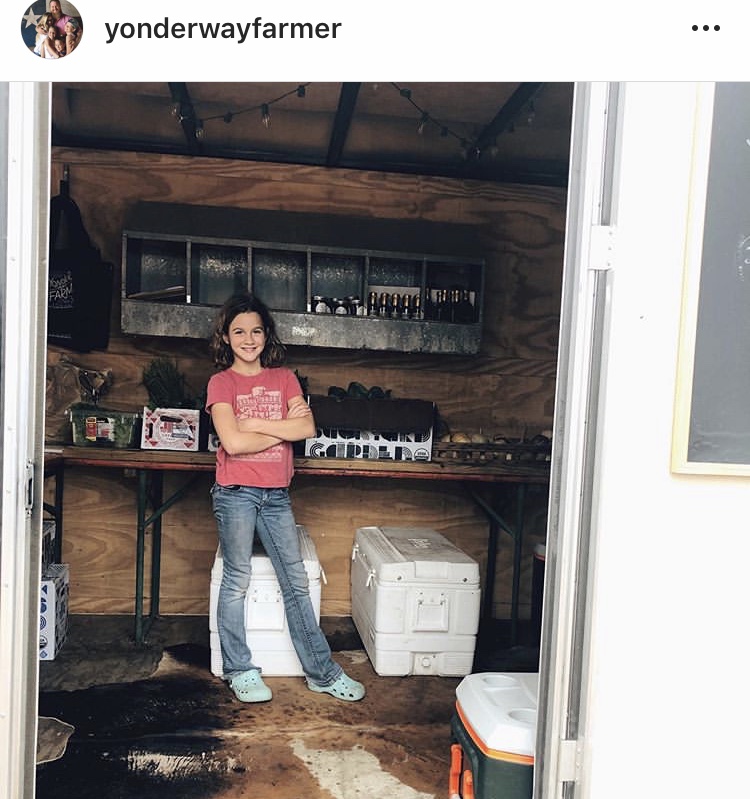 The youngest family member of Yonder Way Farm, Exie Jo, at a Yonder Way pop-up market. Photo courtesy of Yonder Way Farm Instagram.
The youngest family member of Yonder Way Farm, Exie Jo, at a Yonder Way pop-up market. Photo courtesy of Yonder Way Farm Instagram.
 Vegetables, milk, eggs, sauces, prepared foods... One stop shop!
Vegetables, milk, eggs, sauces, prepared foods... One stop shop!

CSA BOX CONTENTS WEEK OF MAY 4TH
05/04/20 — Scott
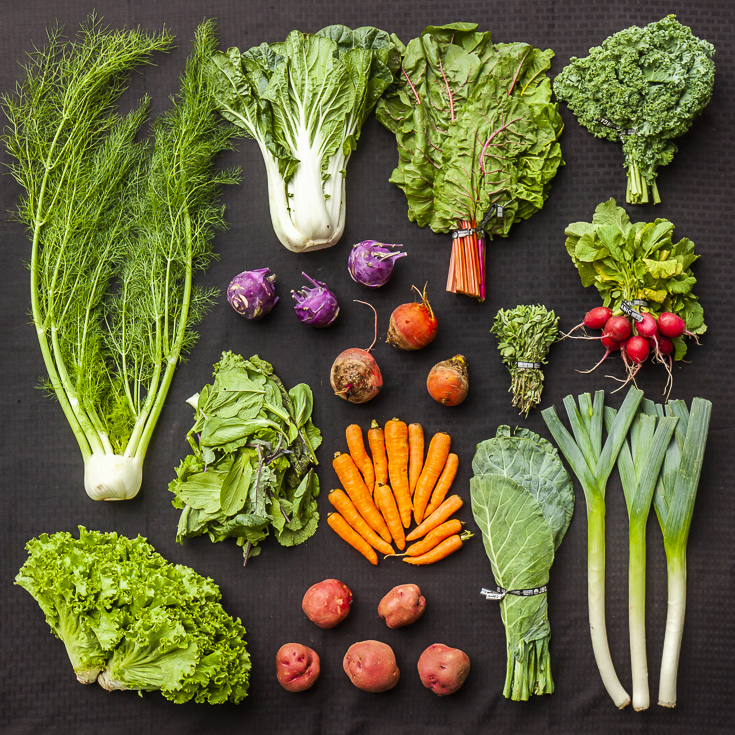 CSA Box Contents Week of May 4th
CSA Box Contents Week of May 4th
Large Box
Beets
Bok Choy
Farmers Choice
Greens, Collards
Greens, Kale, Curly
Herb, Fennel
Leek
Lettuce, Braising Mix
Lettuce, Romaine
Onion, White
Potato
Radish
Squash, Zucchini
Beets
Bok Choy
Farmers Choice
Greens, Collards
Greens, Kale, Curly
Herb, Fennel
Leek
Lettuce, Braising Mix
Lettuce, Romaine
Onion, White
Potato
Radish
Squash, Zucchini
Medium Box
Beets
Carrots
Farmers Choice
Greens, Collards
Greens, Kale, Dino
Herb, Fennel
Kohlrabi, Purple
Leek
Onion, White
Potato
Beets
Carrots
Farmers Choice
Greens, Collards
Greens, Kale, Dino
Herb, Fennel
Kohlrabi, Purple
Leek
Onion, White
Potato
Small Box
Bok Choy
Carrots
Farmers Choice
Greens, Chard, Rainbow
Onion, White
Potato
Radish
Bok Choy
Carrots
Farmers Choice
Greens, Chard, Rainbow
Onion, White
Potato
Radish
Individual Box
Beets
Greens, Chard, Rainbow
Greens, Kale, Curly
Leek
Lettuce, Romaine
Potato
Beets
Greens, Chard, Rainbow
Greens, Kale, Curly
Leek
Lettuce, Romaine
Potato
CSA BOX CONTENTS WEEK OF MAY 4TH
05/05/20 — Scott
 CSA Box Contents Week of May 4th
CSA Box Contents Week of May 4th
Large Box
Beet, Golden
Bok Choy
Carrots
Farmers Choice
Greens, Chard, Rainbow
Herb, Farmers Choice
Herb, Farmers Choice
Leek
Lettuce, Braising Mix
Lettuce, Green Leaf
Potato
Radish
PHOTOS FROM THE FARM: 5.8.2020
05/08/20 — Ada Broussard
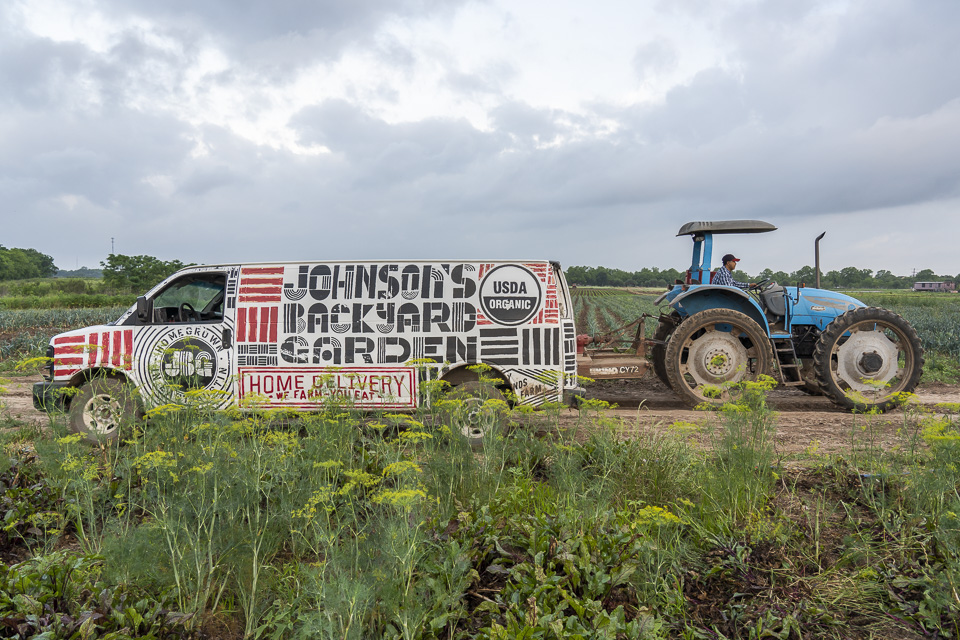 Where does a delivery truck go once it's no longer highway-worthy? To pasture, of course! Photo by Scott David Gordon.
Where does a delivery truck go once it's no longer highway-worthy? To pasture, of course! Photo by Scott David Gordon.
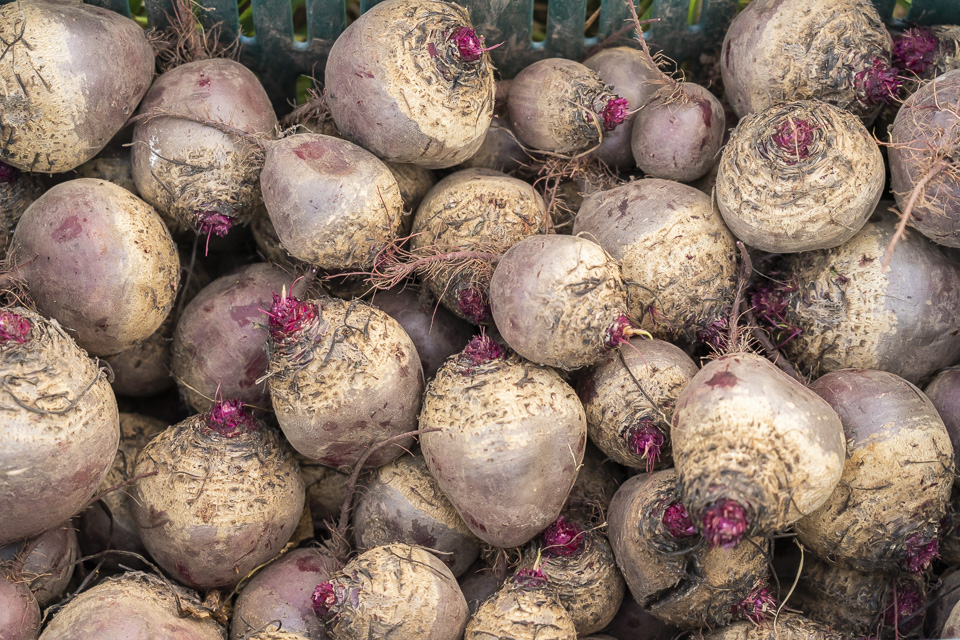 Bulk beets, headed your way! Photo by Scott David Gordon.
Bulk beets, headed your way! Photo by Scott David Gordon.
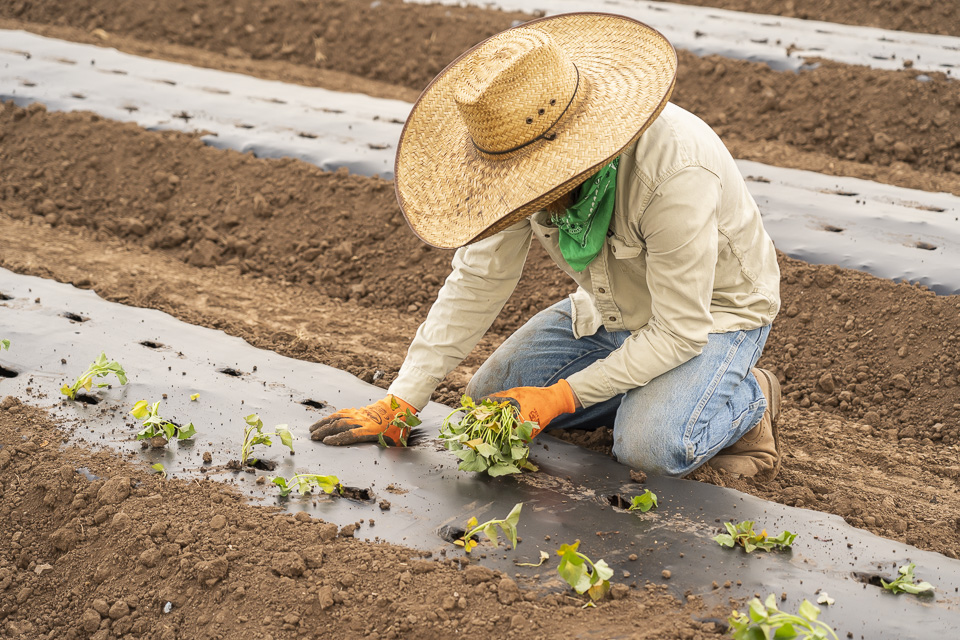 Sweet potato slips, going into the ground! Photo by Scott David Gordon.
Sweet potato slips, going into the ground! Photo by Scott David Gordon.
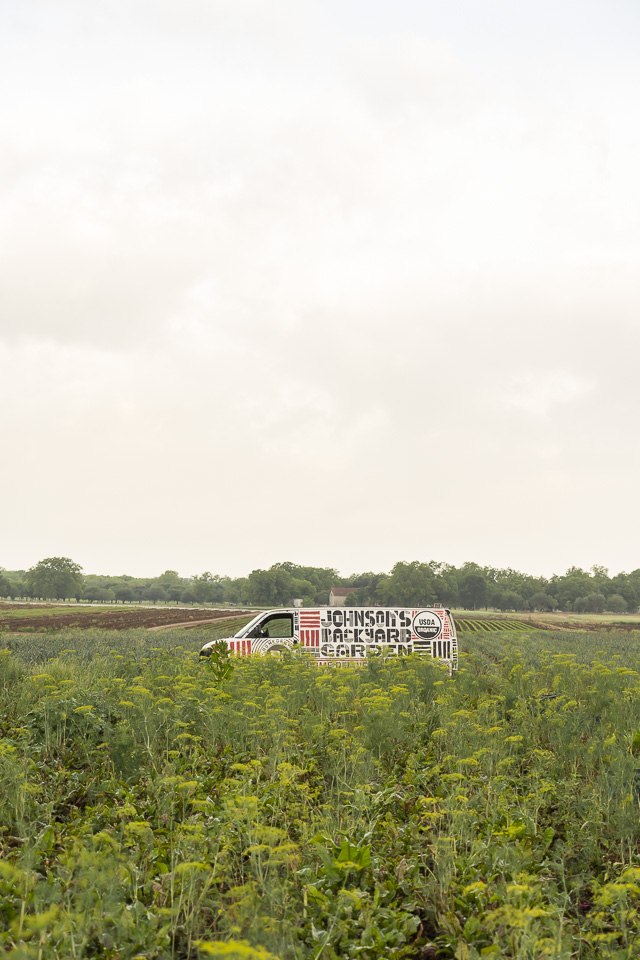 Sweet number 16, resting behind the dill flowers, surrounded by buzzing pollinators, to be sure. Photo by Scott David Gordon.
Sweet number 16, resting behind the dill flowers, surrounded by buzzing pollinators, to be sure. Photo by Scott David Gordon.
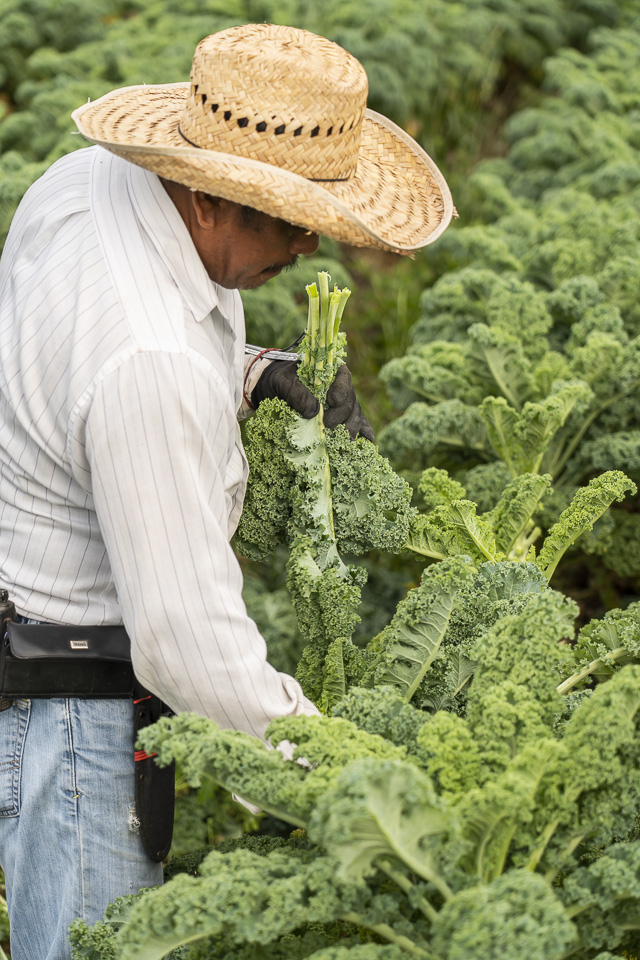 It's suddenly straw-hat season at the farm. Photo by Scott David Gordon.
It's suddenly straw-hat season at the farm. Photo by Scott David Gordon.
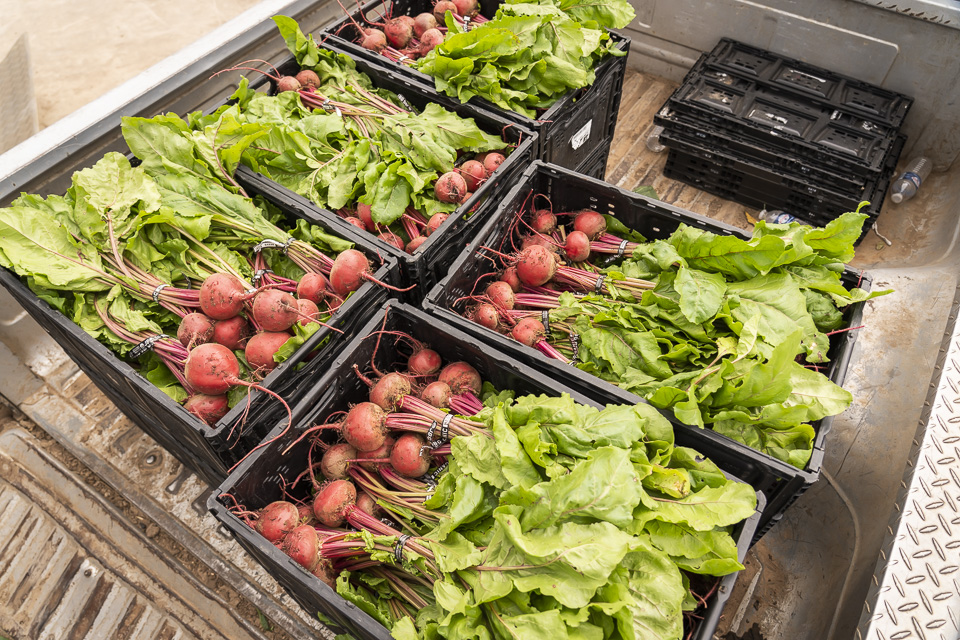 Chioggia beets, with an inside so beautiful it will make you gasp. Photo by Scott David Gordon.
Chioggia beets, with an inside so beautiful it will make you gasp. Photo by Scott David Gordon.
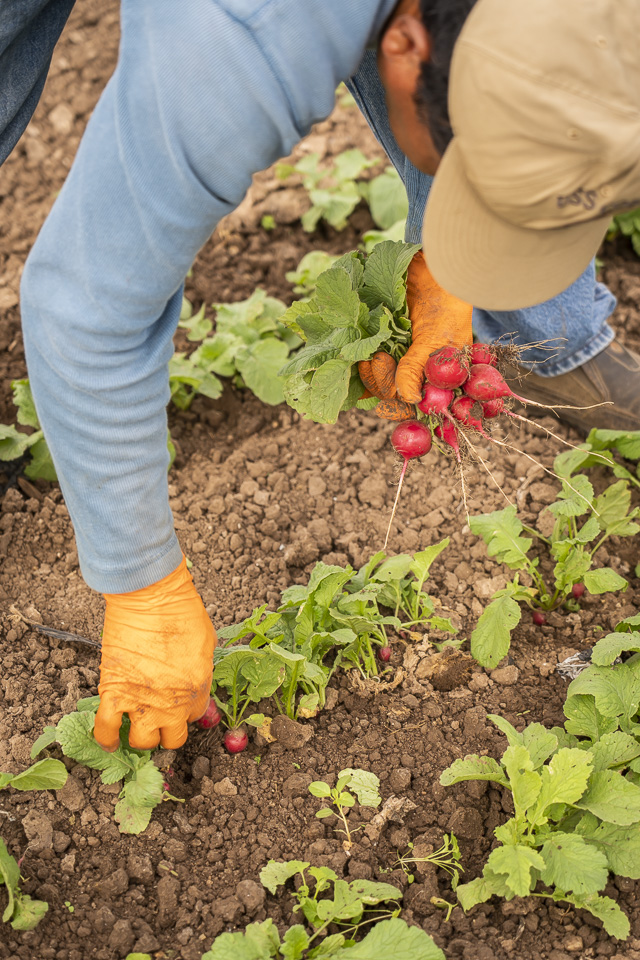 On radish, two radish, three radish, four. Harvested with the most delicate of pinches. Photo by Scott David Gordon.
On radish, two radish, three radish, four. Harvested with the most delicate of pinches. Photo by Scott David Gordon.
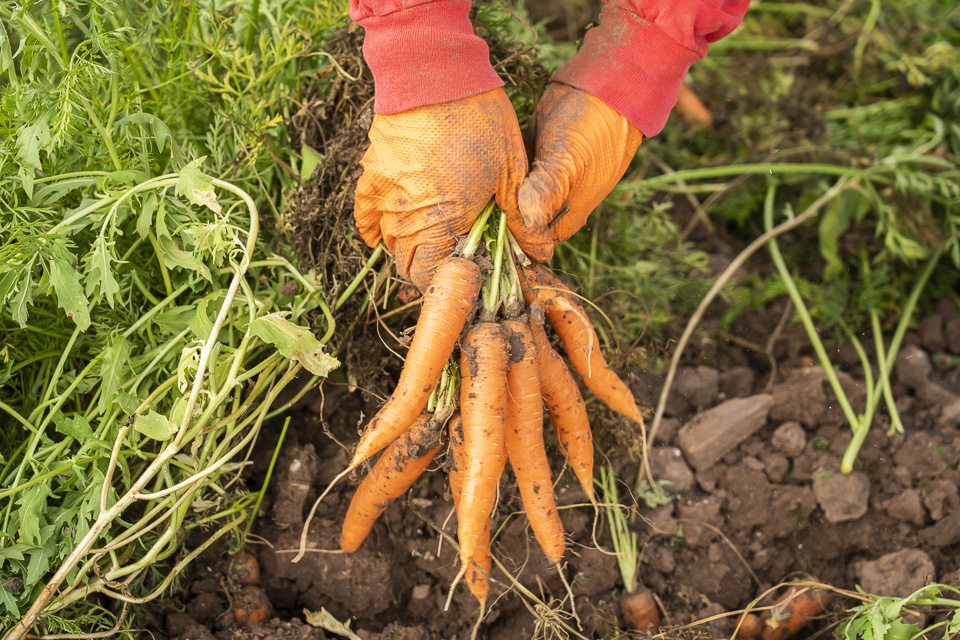 Some carrots are bunched. Photo by Scott David Gordon.
Some carrots are bunched. Photo by Scott David Gordon.
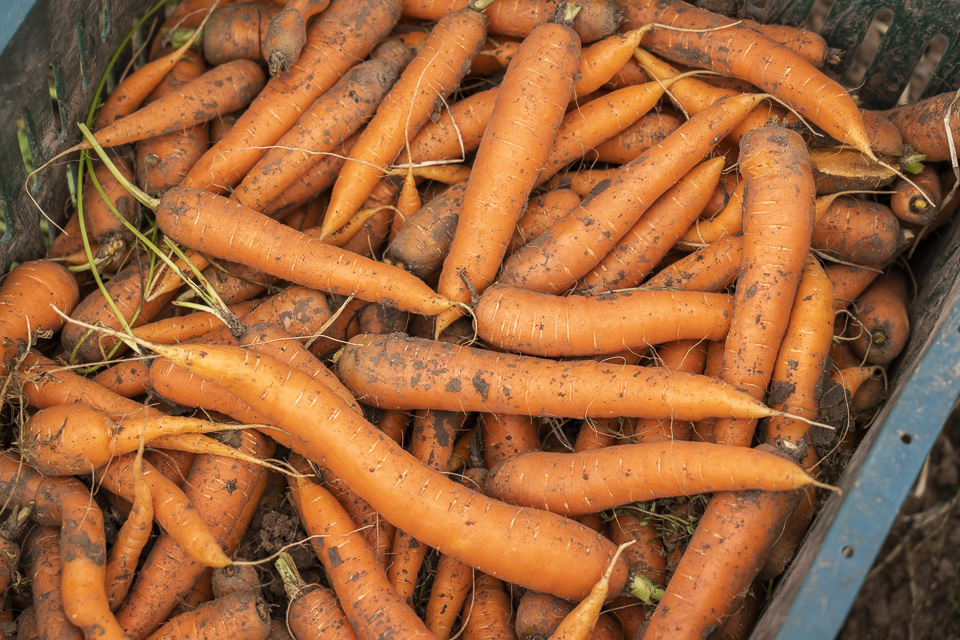 And some carrots are bulk. Photo by Scott David Gordon.
And some carrots are bulk. Photo by Scott David Gordon.
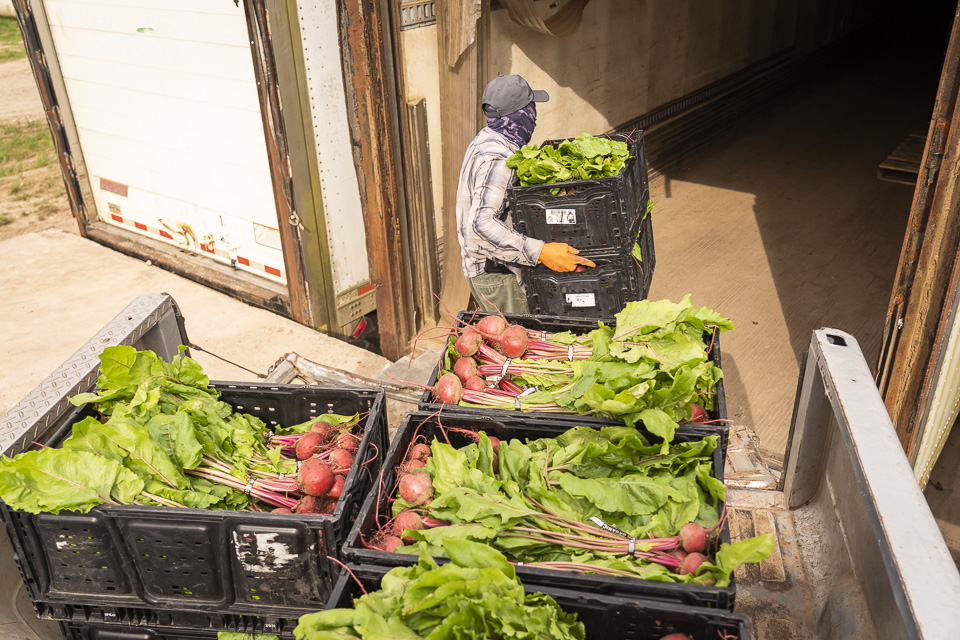 The masked farmer. Photo by Scott David Gordon.
The masked farmer. Photo by Scott David Gordon.
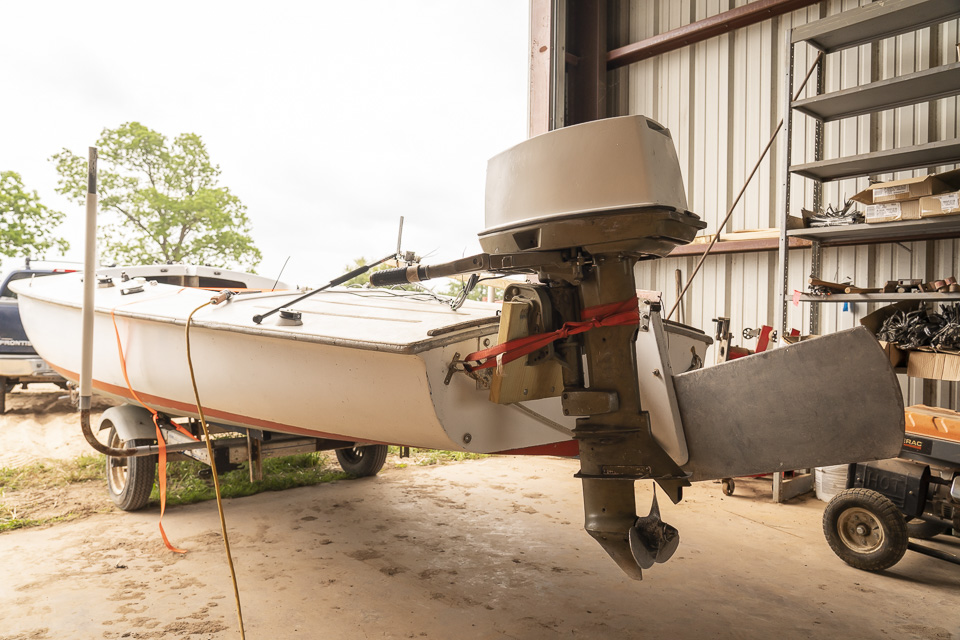 There's a boat in the barn! Who put this boat in there? Photo by Scott David Gordon. Boat shenanigans by Brenton.
There's a boat in the barn! Who put this boat in there? Photo by Scott David Gordon. Boat shenanigans by Brenton.
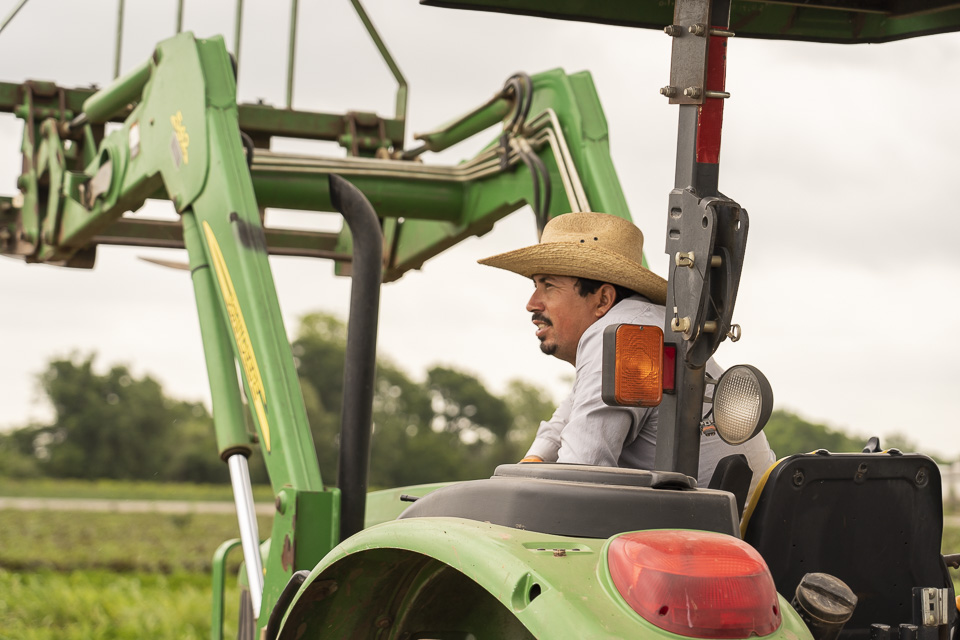 Our harvest crew leader and long-time JBG Manager, Vicente. Photo by Scott David Gordon.
Our harvest crew leader and long-time JBG Manager, Vicente. Photo by Scott David Gordon.
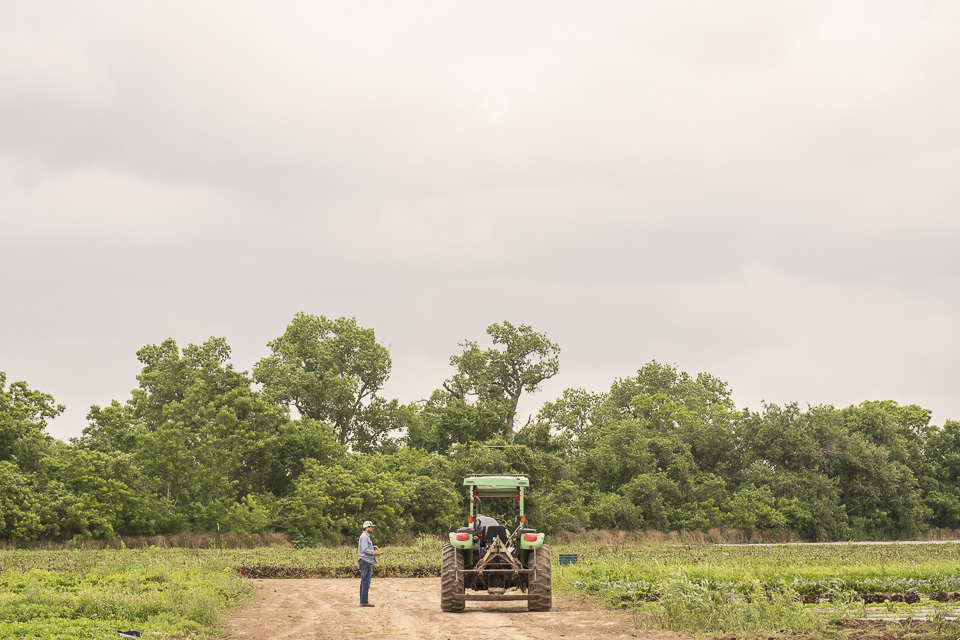 A socially-distant field meeting between Brenton and Vicente. Photo by Scott David Gordon.
A socially-distant field meeting between Brenton and Vicente. Photo by Scott David Gordon.
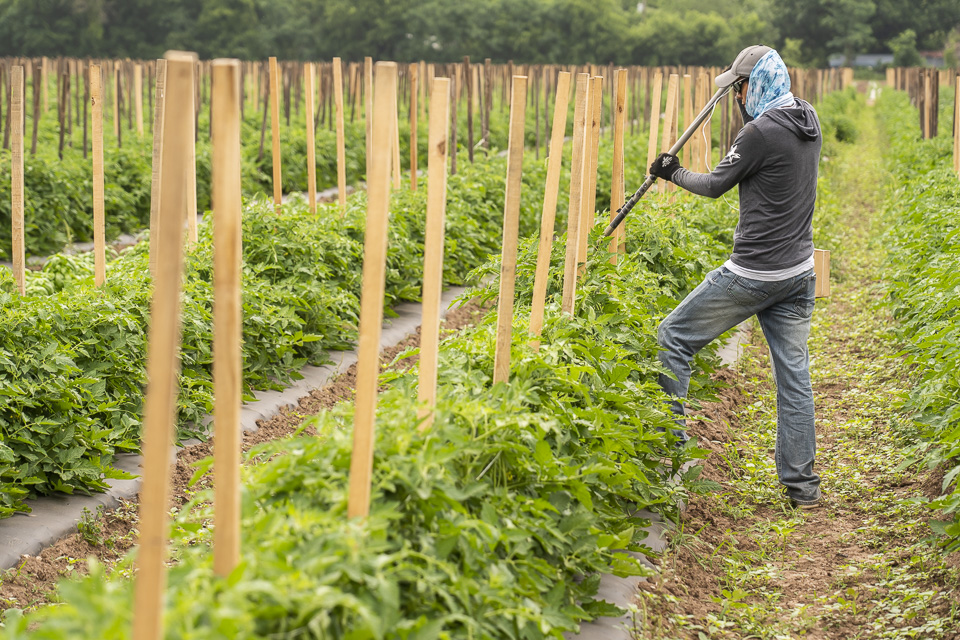 It's official: Our tomato plants are poppin!! Photo by Scott David Gordon.
It's official: Our tomato plants are poppin!! Photo by Scott David Gordon.WHAT IT FEELS LIKE TO BE AN ESSENTIAL WORKER
05/08/20 — Ada Broussard
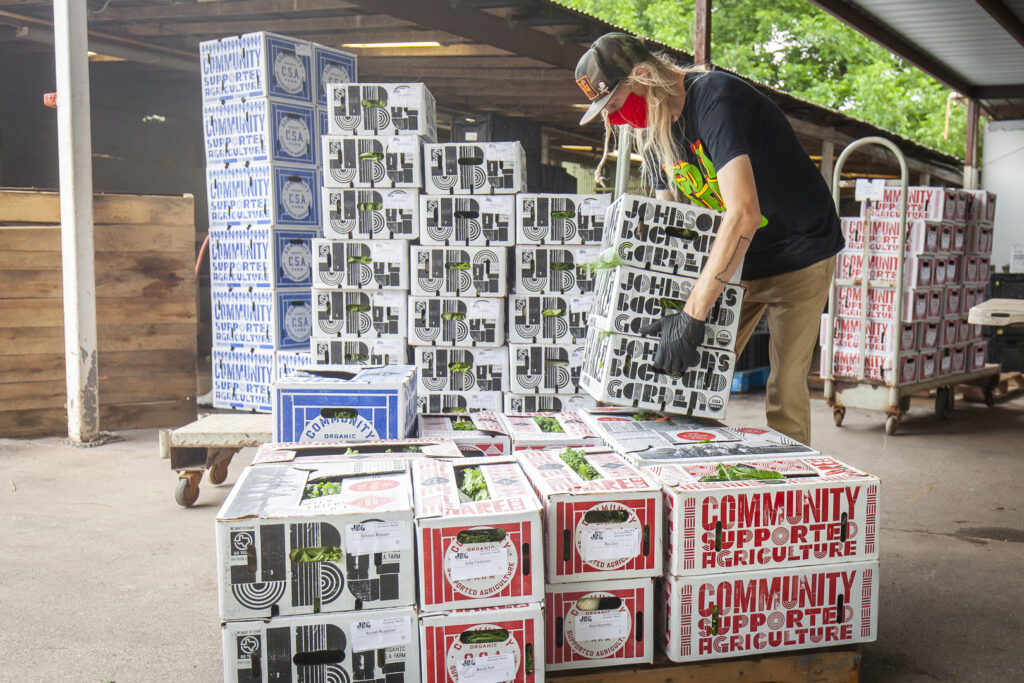
When the whole country was shutting down, telling people to stay home, the staff at JBG was reporting to work, albeit a modified form of work, for the weirdest and arguably busiest Spring in farm history. We are so proud of the immense adaptability, creativity, and commitment to our farm’s mission that all of our employees have shown over the past couple of months. This week we thought we’d check in with some of our staff and just see how this whole pandemic has affected them, and their job as an essential worker.
Dusty: Farmers Market Staff
More than perhaps any other position at the farm, our farmers’ market staff are on the frontlines - interfacing with the public and bringing our vegetables from the fields to your homes. Dusty, a long time JBG employee and market manager, goes to farmers markets every Wednesday, Saturday, and Sunday. Like grocery stores, farmers’ markets and their vendors have shifted hard and fast to ensure the safety of their vendors and customers with increased sanitisation, food safety procedures, and crowd policies.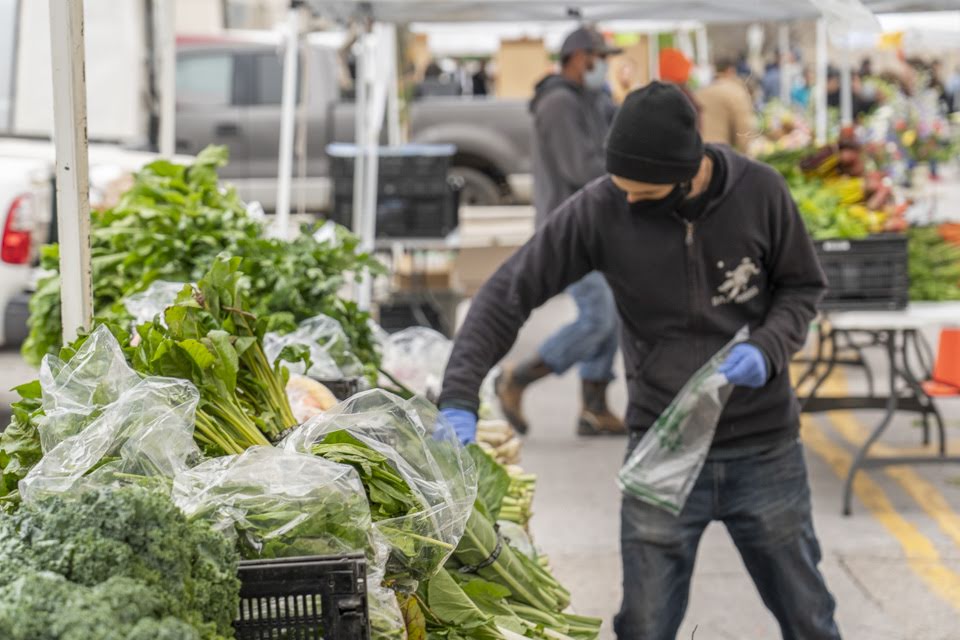
How has it been Dusty? How has it been working markets during this pandemic? I guess everyone is super aware of all of their social interactions. Markets can just feel so exposed, sometimes. We definitely just shoulder a lot of risk. I’m doing three markets a week right now, and sometimes that is nerve racking - just thinking about how many people I’m exposed to.
Sometimes it can be nerve wracking. I’m doing three markets a week right now. When all of the managers get back from market we usually work in pretty close proximity to unload the produce in our coolers. Of course, that had to change, but there is just a lot of anxiety. Outside of work, I’m just home.
I have a lot of mixed emotions. I’m really grateful to have a job. I’m really grateful for the vegetables. I’m grateful for the social interactions..just to be able to go out and see our customers. That’s essentially like my social life right now. So I’m really grateful for all those things. But there is just a certain level of anxiety that goes with it all too.
Tell me a little bit about how the Downtown Market, for example, has been going? All the markets are different right now. SFC runs the downtown market and they do a great job. And everything is done really well. Everyone has to wash their hands when they come in. Like, SFC staff actually wash people watch their hands and they have the entrances taped off so there is one entrance and one exit. Everything is just super controlled. They keep everyone waiting appropriately spaced out. And that all just feels really nice, like that’s comforting and it really helps the whole market feel safer.
What has been frustrating? I will say that I have been frustrated, occasionally, by some customers who aren’t necessarily following the rules, maybe don’t believe the perceived level of threat… but who are in turn putting me in uncomfortable situations. It’s easy to get frustrated. Maybe I’m already kinda an anxious person, but I want the general public to just practice safe habits for everyone's benefit. I’m not really worried about my health, but I don’t want us, as a community, to prolong this any more than we have to.
How did it feel to be an essential worker amid a pandemic? That’s great. That’s fantastic. It really reaffirmed the choice to participate in this local farm, to be engaged directly with our local food system. Cut out all the middle men, the supply chain, all these things that can just fall apart like we can see now. So yeah, I just feel really lucky to be in the position that I am. The weird times have ended up working out for this farm, and I’m really grateful . Despite my anxiety, I’m so glad to be working for the farm.
Sometime right around when HEB shelves started being emptied out, people were showing up at the markets in crazy numbers, panic shopping at the markets. That’s when the job changed - we were definitely providing something very essential for a lot of these people. This one lady in Dripping Springs came to our booth that week and just said, “I’ll take two of everything that you have.” The panic-shopping weeks were wild, and really changed sales. That week we sold almost 4 times as many vegetables as we normally do in Dripping Springs.
Those first weeks, especially, it felt really good to work for the farm. Most of the people who shopped those weeks I’ve seen before and have relationships with, but on those weeks, everyone just came out at once. So it was nice, for the people that I already know, we’re there for them, in that moment. That’s awesome.
Do you feel like the panic shopping is over? Yeah, that’s right. People aren’t panic shopping any more. Each market is different, the way they all function is so different. D- downtown, for example, sales aren’t really where they were pre-pandemic, but I think that’s just because with all of the procedures and with the way that we run our booth now, it all just takes so much longer. So, we’re not able to help as many customers in that market time frame. I feel like some of the bigger and busier markets they almost max out sometimes. It’s harder to sell that much more. I feel like some of the other markets, the sales have come down from the panic shopping, but they’re still higher than they were before the pandemic because there was more room for growth. It’s nice now, though, that people are used to the new procedures.
I was thinking about y’all so hard when I was cc’d on all these long email threads with Fawn and Krishna outlining all the new market procedures. And then, in those first weeks, it seemed like the procedures were changing and getting stricter every week. How did all that go? I couldn’t help but think about the mass confusion for customers that might ensue with the major change of not letting people in the booth and having to pack up people’s orders for them on the spot. I’m really thankful for all the really understanding customers. I’d say like 80% of people have been super awesome, have been thankful that we’re there, are coming to get what they need but are trying not to be a pain or hold up the line - not being picky with the veggies we give them. I’m so thankful for all those positive attitudes.
 Dusty and Devon, pre-covid.
Dusty and Devon, pre-covid.
What’s it like talking to everyone through a mask? Do you wear a mask the whole time? I know a huge component of your job is talking to customers. I wear a proper mask at the market the whole time. Actually, Scott got some pictures of me, I was wearing a mask weeks before it was required. And since early February, Fawn and I have been putting out hand sanitizer at market from our personal stash… before any of this really blew up just because I heard “something” was going around. I felt pretty prepared. To answer your questions, it’s not fun working in a mask. I’m really not looking forward to the summer. Like the other week, the Dripping Springs market starts at 3 and recently it got up to 94 degrees, and where we’re set up, the sun is right in front of us. I’m not acclimated to the heat, and breathing in my hot breath the whole time didn’t help. I had to take several breaks away from the booth just to remove my mask so I could breath and I couldn’t help but think, like, “Oh my god, I’m going to pass out.” I’m not looking forward to the summer. It makes a hard job that much harder.
It is logistically hard to talk to people? Yeah, for sure. It’s hard for them to hear you, and it’s hard for you to hear them. None of the markets have music right now, and people are spaced out, so that does help a bit with the noise. But it’s pretty tricky. And then, we have to keep all the produce and price signs back away from customers so they won’t be tempted to touch it, they’re literally blocked by tables, and it’s far away so people have trouble seeing the produce and that involves a lot of explaining and walking them through what is what. So sometimes it feels like a lot of talking.
What has changed exactly about the physical setup of the market booth? When this first started, we had this rough blueprint of how our new booths should look, but all the markets are so different and have different variables to deal with. Past the blueprint, though, there was a lot we had to just work out on the spot. And I think everyone had to do that. Like even figuring out - can I wash the gloves that I’m wearing or do I have to change gloves? Just little things like that. I think everyone is just figuring this out as we go.. We all are… but everyone who is still working in some capacity in any field is having to adapt. I’m rambling. What was the question?
Ha! It’s okay. I was wondering what is different about the booth, physically. There are two big tables in the front to keep everyone out of the tent. That’s where the registers are. And then there are three large tables on the back of the tent where all the vegetables are spread out in one long line in a display. It’s kinda confusing because we separate who handles produce and who handles payment, and sometimes it’s hard to explain this system to customers when there is a line. So, if you're the payment-handler and someone tells you that they want a bag of lettuce, you have to explain why you can’t really help them and they have to wait for the “produce handler” to take their order. There is just a lot of more explaining, but most people are really understanding. Also, no tablecloths. All hard surfaces need to be wiped down/sanitized every hour. The farm is providing us with hand sanitizer, sanitizer spray for hard surfaces, and gloves, and we’re all bringing our own masks. I try to be overly prepared, especially when at markets, because I’m kinda just used to things going wrong.One week recently, the extra clean bandanna I brought was used as a rag for the hard surfaces because the rag was missing from my market bin.
Anything else you want to say about it’s been like for you, personally, to work for the farm during these weird times? If I had to sum it all up, it would be something like, pride and anxiety. Like yeah, I feel good about this, and yeah, I’m very anxious about this. It does feel good to be out and talk to people sometimes!
I’m sure - in addition to people needing food, obviously, so many people are going through so many things…. it’s just such a service to just be there for people.
Sometimes people come and it seems like they just want to talk. The voice in the back of my head is like thinking “hey, you’re not supposed to hang out. I need to help other customers.” Wait, you say that out loud? No, no… I can’t say that. I mean, they might live alone, this might be one of the few times they’ve been out all week.. I completely understand it.
Faith: CSA Office Manager
Whether you’re a new or long-time CSA Member, you’ve probably heard Faith’s name. She is all things-CSA. Faith manages all of the CSA routes, coordinates with delivery drivers, coordinates with CSA pickup locations, and answers the main farm email and phone… just to name a few. The size of our CSA has nearly doubled since the pandemic began, and Faith’s workload has certainly followed suit.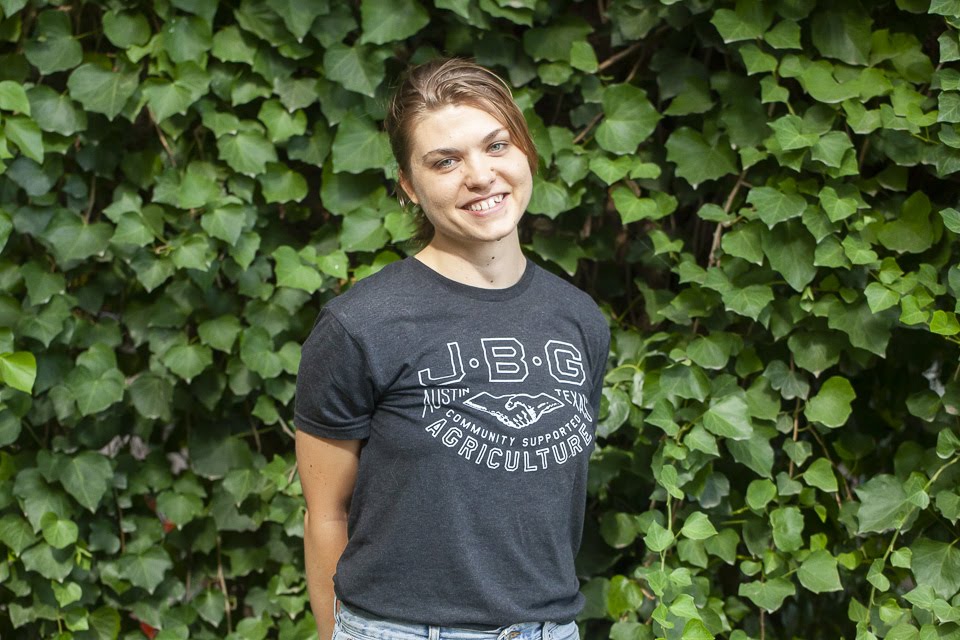
How’s it going? Did you get through those emails? How has the email been this week? It’s slowed down some, but still pretty steady. Eggs aren’t a problem any more? Well, not this week. We got a special extra 20 cases. I hope we get it again, but it’s not confirmed yet.
Obviously your job has changed since Covid. Tell me about that. [Lots of laughter. It’s changed a lot.] Well, it used to be a pretty even balance of different roles - customer service being one of those, driver staffing and logistics being another, and then getting to do things like work on special projects to help build out the CSA program itself. I was working on a few projects before this happened that just came to a dead stop. So, that’s been the major thing. My job has shifted almost entirely to customer service right now. Has Krishna been helping with driver logistics? Yeah, he and I have been doing that together. At first it was like, okay, we have all these extra routes. Let’s get people to sub in. And now the positions are semi-permanent and we’ve been able to get people on a weekly schedule to cover the new shifts. So we have almost two extra drivers every day. You’re kidding. Well, it kinda worked out, because as some of our part-time market staff were losing other jobs, we were able to give them more hours. I don’t really know what’s going to happen when that shifts back, there will be some other challenges to overcome, because we’ll still have those routes to fill, consistently.
How are you adjusting to the new workload? I remember working in the office when there were just days when there was so much going on and it felt so chaotic. Is that how everyday feels right now, or do you feel like you’ve settled into a new norm? Well not anymore, that first week.. No, the first two weeks, I felt like everything was on fire. I was working 12 hours a day every day just to keep the emails manageable for when we got back in the next morning. And you were helping with that, and Krishna was helping with that, so it was even more work than that. But that part has kinda dropped off. I feel like my work hours now have leveled out, but what I’m doing in those hours has changed.
Are you okay? I feel like I’ve followed the same trajectory. Those first two weeks were very difficult, mostly because I’m a major introvert, so to be on the phone and responding to other people, for that amount of time, that consistently, like I couldn't go home and feel like I got to a state of relaxation before I had to come back and do it again. There was never a recharge time. So, that was the most challenging part of it and that kind of bled into just some general stress. But now there is time to recover, and recharge, and put my head on straight-ish.
The CSA. What’s up? In terms of weekly boxes, it's more than doubled. And most of that was within that first five days before we decided to make a waitlist.
How are customers? I feel like we’ve had a similar journey. Those first weeks, understandably, it was really frantic and urgent calls and emails… people trying to figure out what we do, and can they sign up. All of the normal questions we get when someone signs up, but at a way more rapid pace.
Yeah, I hadn't really thought about the fact that it’s not only that we have so many new customers, but that the rate at which they’re signing up was so quick. It’s not like you’re just answering a few inquiries a day about the program, but you’re literally answering hundreds a day. Yeah, it’s a lot of orienting people and setting expectations for people. And then, in that first period, it was like - Okay, all of these pickup locations of ours have closed overnight. Okay. Where are we going to deliver the boxes now? And then communicating that to members, moving their accounts, or putting their shares on hold.. So all these little logistics for almost each customer, each member. And...what was the question? I don’t know.
Generally people are just asking the question, “How can I get produce.” And then I’m having to explain the options, and what they can and can not do, how we’re changing our operations with what was going on. And like everyone else, I was just trying to figure out what actually was going on, or what is going on, and then being able to communicate a clear answer. And still trying to be friendly when I know I have 40 voicemails to listen to.
When the whole country was shutting down and you realized you were essential and had to go to work everyday, what did that feel like? For me, it was like, I have this job to do. And I feel very grateful that I still had something where I could go in and do something that was helping everybody at a time when a lot of people were looking for anything. So, it didn’t really register that I was essential. It was like, I gotta go in at this time, do this much work, then go home, and I’m not going to do anything. I’m not going to go anywhere. I’m going to go back to the office. I’m going to do the work. I didn't really have time for the essential part to set it.
How did social distancing in the office go? Well, where my desk is, I don’t have to get close to anyone. A lot more hand sanitizer for sure... thanks to Zilker brewing.. They were cooking up batches.
How have the barn vibes been? Have they changed? Yeah, definitely. Everyone was very concerned. And everyone is taking all the precautions in their private life to keep everyone safe here. And just respecting the fact that what they do outside of work affects the whole operation. So yeah, everyone has been holding each other accountable and abiding by the rules.
I would imagine there was just a lot of general anxiety. Yeah, I mean, just because we were all working doesn’t mean we were immune to the anxiety that everyone around the country was feeling, but maybe even more because we were actually having to go to work and be around people.
Are there any new customer stories that stick out? I know we have a lot of newbies. There are so many people who have emailed or called in telling us their stories or situations, and talking about how our boxes are helping them. Especially elderly and immunocompromised folks. On the other hand, we heard from a lot of people who lost their jobs and needed to suspend their accounts.
How are all our delivery drivers? The stressful part about that is that all the routes have gotten longer and more intense. I am checking with everyone everyday about how they feel physically, and no one has expressed any concern in that regard... but I do worry about how long our drivers can keep working at this rate. But the extra drivers we have right now do help with that, and help spread the workload.
Do we have enough vehicles? We had to buy two, in addition to the ones we already had.
What did we buy? I’m just curious. Kinda just like our other vans, but they have backup cameras. Oh, wow!!! So, I think that was exciting for the drivers. Now everyone gets here early to make sure they get one of the new vans. Working radios? Oh yeah. They’re just a couple years old, 20k miles. Shiny. Those have gotta be painted some day. Some day. Oh yeah, related to painting the trucks- not having volunteers at the farm has been hard.
Anything else? The customers have been very understanding and very kind, which makes my job easier.
You have been doing such a good job at your job. It's been so amazing to see from afar to see how crazily y'all are adapting and changing and accommodating to all the new members. The new membership is hard to believe. It is.
When I was talking to Dusty, he said that mostly everyone has been nice, but then of course there are some folks frustrated with all the new processes. Yeah, it’s been interesting, I’m not sure if you want to include this, but there have been several customers who I've been talking to on the phone who just break down. And that also sorta helps me step out of the stress of all the work I have to do. Like, that is someone...not that I don’t think of them as real.. but sometimes it can become just the next call… and then it’s like I can really be patient right now, and help this person. And then they usually email or call me back and apologize for breaking down. When you say breaking down, do you mean crying or getting mad? Oh yeah, like emotional crying. Full-on. That’s so sad. I know. I know. It’s intense. And they’re really apologetic. And I’m like, “It’s okay. It’s okay. You don’t have to apologize at all.” What are they breaking down about? Just random things about their CSA subscription? Yeah, usually, and that’s why the call and apologize because really it has nothing to do with their CSA, like ,maybe something is late, or they didn't’ get the veggie they were expecting, but usually when I hear back from them they’re just like “I’m sorry, I was having an incredibly difficult day or week and I just lost it… And I’m like, “I’ve been there! I know!” Wow. Yeah, I hadn't really thought about that: you're on the phone all day with people who otherwise have been very isolated suddenly they’re like, “I’m talking to another human!” Well, yeah, I guess that’s the essential part. We’re providing this thing that people need and people have to have. It’s not like their delivery of new tennis shoes is late. They have to eat.
Well thanks Faith, geez, you’re really killin’ it. Just doing my job. Yeah, but your job is nuts right now. I used to work a bunch of film festivals, and actually, there is a part of me that kinda likes the urgency… to a point. Surprisingly everything here is running smoothly. But it’s just busy. The website is working, the vehicles are working. Knock on wood.
Andrew: CSA Packing Manager
Andrew is one of two CSA Packing Managers to ever work at JBG, and his heartfelt dedication to our Community Supported Agriculture program has never been more apparent than through this pandemic. Andrew is responsible for planning, packing, and running QC for our entire CSA Program. His physically and mentally taxing day starts before the sun rises, when he gathers the necessary harvest for the day’s CSA boxes. When hundreds of new customers came knocking on our door, our farm was only able to accept these new CSA Members because of Andrew’s “yes”. He has adapted his crew, the way they work, and his schedule to accommodate this increased demand, and we’re oh-so-thankful for it.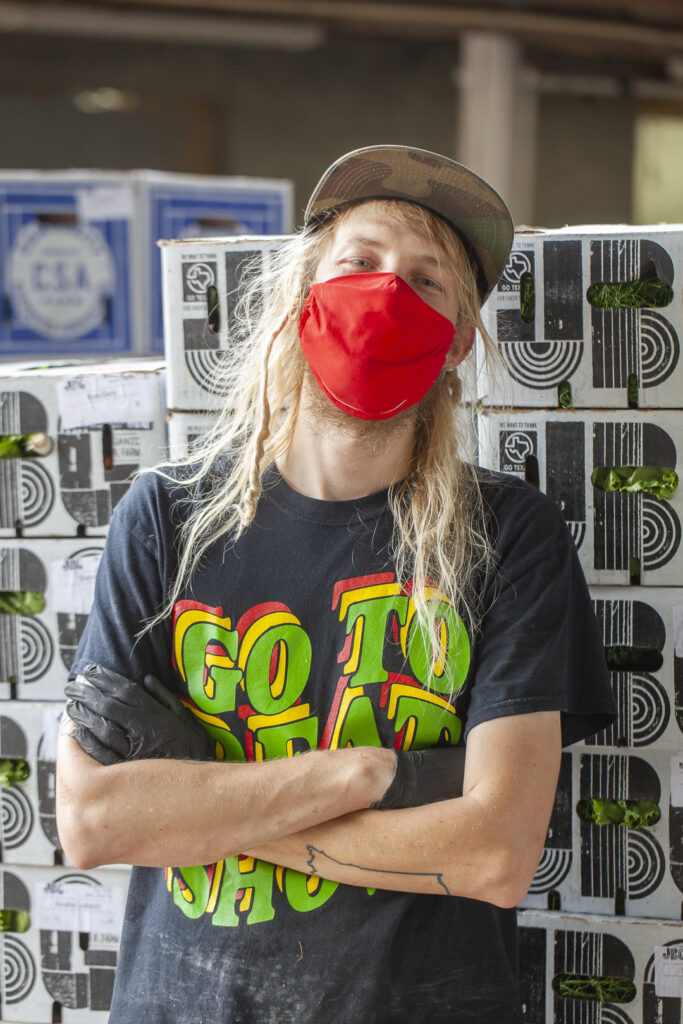
How are ya? How was your day? It was good. We’re all hanging in there. I got my stimulus check today, so that was pretty good. You know, Nikki isn’t able to do her job as a photographer right now, so it was definitely good to get that check.
I’m going to jump in. I wanted to touch base and see how your job has changed in the past couple of months. I know your job has changed a lot. Yeah, it’s been a trip. It’s been kinda a blur. One day Krishna just brought us all these letters that stated that we’re essential workers and you need to carry this in your car. But yeah, in terms of the CSA, we’ve more than doubled in size. And we had to make a lot of decisions on how we were going to accommodate that - so we had to make the decision to forego the veggie swapping feature right now just so we could provide veggies for as many people in the community as possible. We actually had to cap the signups, which will slowly open up again soon. It’s changed how we pack in the barn, obviously, It’s still a three person crew who packs all those boxes, it’s myself, Alexander, and Nick. Instead of coming in at 7, we come in at 5 in the morning now. Basically, we don’t stop packing until all the boxes are done so we can get the drivers out, because not only are our days really hectic now, but the driers all have like 10 hour routes and they need to get out as soon as possible. So, we’re coming in early.. That’s the only thing we can do.
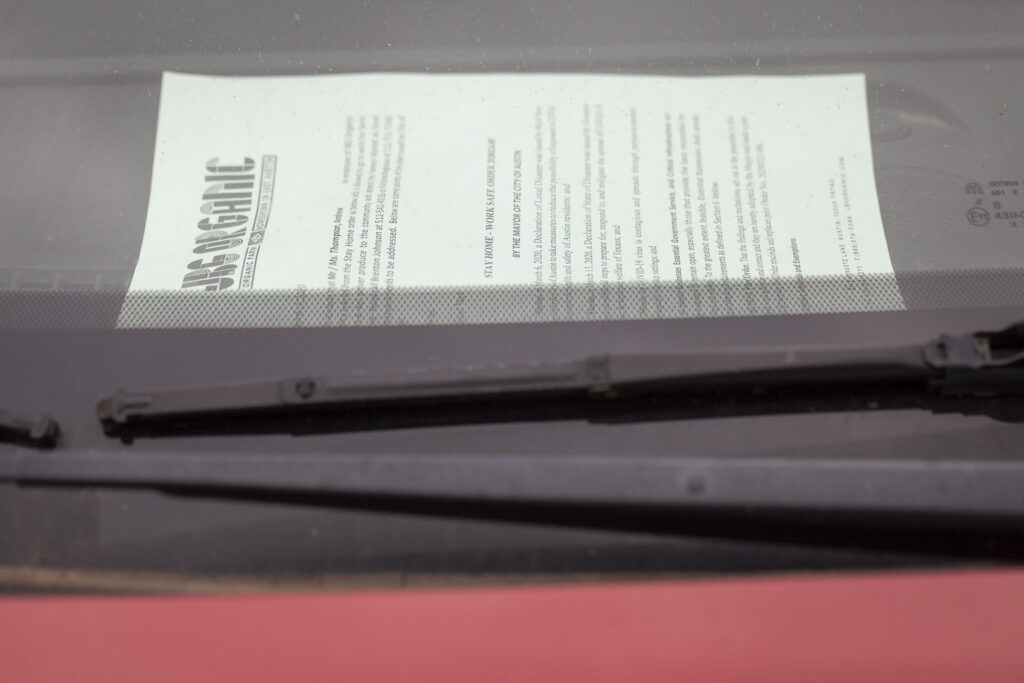
How have you been adjusting to those earlier days? Well, you know, I always came in an hour earlier than the crew, so for me it’s just an hour earlier than when I usually got there at 6. But you know, the first week was really rough. But now, it’s normal. Getting off at 1 pm having done a full 8 hours is weird. There are parts of me that like it. It’s also just good for the quality of the boxes - we’re moving so much produce right now and we’re moving into the hottest part of the year, so it does nothing but help the whole operation. Are y’all packing boxes before it’s light outside? Oh yeah. Now we fold and sanitize the boxes the day before. Yeah, now, any boxes that are returned we now have to let them sit a week, and then we sanitize them, and then they’re used again. Good and Covid free. And then, like always, we bleach and sanitize the whole (CSA) line and all the tools. We’re usually packing the first by 530.
What’s your heaviest pack day now? This Friday we’re packing 650, and Tuesday it was about the same. That is so many boxes. I remember when it was a stressful day when we would have to pack over 300 boxes. Was there ever a moment when you were just like, “I don’t think we can do this.” Um, you know, we have so many great people. Like Tracy, for example, and I know that he always has my back… and if I ever expressed to him that I needed some more bodies in at 5 tomorrow morning, I know he would be right there, along with whoever else we needed to pitch in. Right now we’re just hitting our capacity in terms of vehicles and length of driver routes, but I think we can get the packing done. Unfortunately we aren’t allowing customers to do substitutions right now, and I know that’s a draw for some people, but we had to make that decision. You know, we’re in a pandemic right now. My focus is just on getting people the best veggies we can, and hopefully we’ll get the swaps back soon. But yeah, I would love to be able to pack a box for anyone who wants one, because I know there are still a lot of people who still are unsure of going to the grocery store, and we have an option to get them food in a potentially safer way.
Your attitude is amazing, Andrew, because I know how long your days have gotten these past couple of months. Well, I like the fact that as a business, we can just be here for people and maybe take a little stress off of people’s plate. But also, we didn’t want to just open the floodgates of people signing up because we didn’t know what we were capable of. We didn’t want to accept all the new members, and then end up hurting those people by not being able to deliver the product. We wanted to make sure that 1) we were able to hit our new numbers… which were always like dream numbers for us. Numbers that we hoped to hit in a few years. And we were forced to figure it out in a matter of like, two weeks. We’re working through our waitlist now. And have even talked about building a second CSA line. We gotta get those swaps back!
Weeks ago when the country shut down and everyone was asked to stay home, what did it feel like to realize you still had to go to work? Well, when the virus was really picking up and getting serious and the first Covid cases in Austin popped, we all did a lot of talking. You know, everyone in the barn is a small crew, and the vibes were kinda weird so we all had one really big meeting about how we were going to move forward safely. We knew the community was going to lose a lot of jobs, so there was a moment when we were all asking, “We’re okay, right?” And Krishna gave us the answer to that, but it’s a trip. To like, come home from work in the middle of the day and literally see no one else.
Has the pandemic changed how you’ve thought about working at JBG? I mean, when I started 6 years ago, it’s always been a source of pride where I work. I know for everyone who has worked here for a long time, we’re all proud of JBG. I hope it changes the community's habits, overall. I try to be conscious of where I spend my money, what businesses I support, and how they support the local community. It does feel good to know that I’m able to help especially in such a time of need. There are so many uncertain things, but it’s great that a local farm in Austin can provide this many people meals throughout the week. That’s rewarding in itself. It makes it worth it.
I agree. And you know, I’ve had those moments throughout the years. Like, when we work with AISD for their Farm Fridays, or when we help pack bags of produce over the summer for kids’ who can’t get food at school, there have always been those moments that make it worth it. And this is just another one of those moments, and why I think so many communities need to get in touch with their local agricultural sector.
Anything else you wanna say about what it’s been like to be working during this pandemic? I just wanna give a nod to all the people that I work with in the barn. We’re all so close knit there, and I just appreciate how aware everyone has been to do their part. You know, when we’re not at work, we’re at home. And we’re all making sure we’re following all the new safety procedures. Everyone has been doing such a good job of keeping morale high. Tunes are still playing loud. I just wanna thank all the barn crew.. And the community, as well.
I’ve been wondering about vibes in the barn, wondering if everyone has been super stressed. In the beginning, it was really uncertain and there wasn’t that much information out there. We were all just worried. I was worried about not being able to see my family in Indiana. If I went to see my mom, would I have to lay low for three weeks? But I think that initial anxiety brought us together and made us stronger because we were all going through the same thing. And we were also able to get to work, get outside, and see each others' faces... have that community and communication with each other. And a lot of people don’t have that right now. So after the initial anxiety of what was happening simmered down, the circumstances brought us all together and we were like, “Okay, we’re in this. How can we do this? How can we make this giant shift?” And we just put our heads down and started gettin’ to it.
Mike Mo:
Mike has run the JBG Restaurant Sales department for 8 years, and throughout his tenure at the farm he’s seen a lot - massive crop failures, 1,000 pounds of rejected tomatoes, 500 cases of squash that need to be sold...yesterday… but of course, nothing could prepare him for the complete transformation of his entire customer base: Austin Restaurants.
How has your job changed since the pandemic? Well, obviously, being the person with the restaurant portion of the business.. that changed dramatically. In the matter of one press conference, which I happened to be watching live.
Did your heart drop when you saw the press conference and realized almost all of your customers were going to have to close their doors?. It did. But then I knew things were going to just change. People weren’t going to quit eating.. Just eating out. It took some days to figure out how it was going to change, exactly. But there was some initial shock with the news. Everything has worked out fine for the farm, but there was definitely some shock in those first days when we were just trying to get a grip on how things would change.
Restaurant business has obviously slowed. What about the grocery store accounts that you help with? At this point, grocery store sales have evened out a bit. At the beginning, it was pretty hectic trying to get them resupplied after everyone went panic shopping. Even though I’m the restaurant sales manager, I actually sell to other types of businesses too: catering companies, meal prep companies, and all of their business started to increase, so it has all started even out a bit.
I’ve been so inspired about how all the food businesses and restaurants are adapting. They’ve really done an incredible job. Almost immediately, or within a few days of when this all got started, I started to get emails from companies who realized “hey, people are still going to eat, how can we help with that?” And then just adapting their facilities, skill sets, and abilities to figure out how to feed people in a new way. A lot of them went to meal delivery, meal pickups. Emmer and Rye, for example, moved their businesses out of Fairgrounds to their other restaurants and started to offer lunch services from there. Places like Sifted have been doing lots of cool stuff, too. You know, Jason (of Yonder Way Farms out of Smithville) just had a crazy amount of demand. His business is outta control. I think he started a household delivery model through all of this. Our veggies are getting distributed through his meat delivery, too. So yeah, lots of places like that just upped their game to accommodate for people wanting to avoid grocery stores. Good Apple was kinda just getting started and they got a grant from the city to distribute to low income households, so they came to us to see if they could use our veggies. Catering companies, too, jumped on all this fast with meal kits and home delivery- they had a lot of infrastructure like delivery vehicles already in place.
What were things like in the office during all this? Well, I’m already pretty socially distanced in my little corner of the office. So, honestly, things didn’t change too much there. Everyone has been very conscious of their health and where they go (or don’t go) out of the office. We’re out in the open air, which is great.
How did it make you feel when you realized that your job was considered essential? For me, it reinforced something that’s always in the back of your mind. I mean, our mission is to feed people, and that didn’t change at all. The way we did it changed a bit, but the mission didn’t. To me, it was a good feeling. I don’t mean that to sound conceited, but it was nice to get some recognition of sorts that our job actually is essential. Totally, I feel the exact same way. Like, farms everywhere are finally getting a bit of recognition for the work they’re doing every day, forever. Pride is kinda a weird feeling to have when I know that people are suffering, hurting, and losing jobs, and even dying, but there has definitely been some feelings of pride in what I do mixed into all of this. I’ve always considered what we do essential, so it was just a nice reinforcement. I know. I’ve never been more proud to work for JBG. Certain parts of the food system are crumbling around us, but our model is still intact, and this all reinforces the fact that a direct farm to consumer model might be a better way to feed everyone. We’re still just chugging along. Yeah, and hats off to everyone that works here. We never really faltered too much. It was just like, “oh hey, we can’t do that” and then - boom, we solved that problem. We can’t deliver to that many houses? Okay, let’s get a new van. We just made it happen. It’s not quite business as usual in terms of distribution, but out in the fields - we’re still just focused on growing food, and we’re all just going to keep on truckin’. Yeah, crops are still in the field, people still need to eat. Let’s figure out how to do this. All in all, I’m proud of the farm. Really, really proud of the farm. And proud to be a part of the food system in Austin.
I feel the same way, Mike. It reminds me of all the feelings I had when I first started working in agriculture and was so idealistic, and all the reasons I chose to work in agriculture, and then over the years it can sometimes feel like a grind. And then, moments like this, reaffirms my initial decision to work in ag and the food system.I certainly don’t want to dismiss a global pandemic, but when you can adjust and adjust quickly and pretty much continue to do what you do in a pandemic, I find that pretty remarkable.
Any veggies you’re looking forward to? Oh we’re about to get to the time of year when you can just walk into the cooler and make a huge farm salad. It's awesome. You don’t need anything else - chop up some tomatoes, some cucumbers, some peppers, salt and pepper and olive oil. One of my favorite things to do during the summers.
I miss working in the office and having such easy access to all the veggies all the time. Yeah, I mean, that’s one personal thing that I realized during all this - with people all over the country panicking about losing their jobs, losing their insurance, and everyone is panicking about food, and I realized that I didn’t have that worry - the worry about not having food. I work at a farm, and there is so much food here. I’m grateful that it’s a worry that I didn’t have to have.
Lucas:
Lucas has been a delivery driver at JBG for over 6 years, and knows every Austin alley interstate turn-around. He wields our largest, 24 foot refrigerated truck, which he drives to the HEB Distribution Center in San Antonio. On other days, he sticks to local CSA deliveries, sometimes done in one of our hand-painted box trucks, and sometimes done in a periwinkle minivan. Like Dusty, our Farmers’ Market Manager, Lucas holds one of the few customer-facing positions at our job. He is delivering produce directly to grocery stores and homes alike, and the pandemic has definitely changed the way he operates.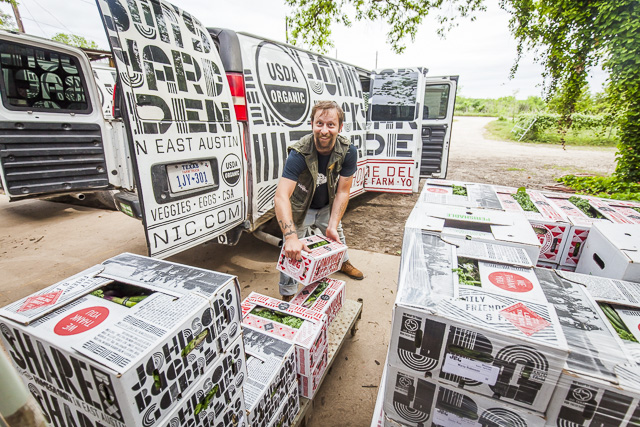
Hey Lucas! What’s up? I miss ya. What are you doing? Waiting for our slot at distribution in San Antonio.
Classic! I’ve got some questions for the blog this week if you have a moment. I’m curious how your job has since the pandemic. Has your job changed at all since COVID? Yeah, it has.
How so? Well, HEB, for example, was sorta shut down for a few weeks. And you know, we all have to wear masks, and when in the warehouses we have to practice social distancing, not going into areas of the (HEB & Whole Foods) distribution warehouse that we’re used to going in. And a lot of the restaurants that I usually deliver to are closed. Most of the restaurants that are taking deliveries have a table setup outside and I can’t just walk into the cooler to deliver the veggies like I’m used to. So, I’m not really walking into the restaurants at all any more. Everything is going to different areas, at every space.
You know, just being on the road all day, I’m wearing gloves, keeping a huge bottle of sanitizer around and am sanitizing my hands all day, because I’m going to so many places.
When this first got started, was there any part of you that was scared or anxious about having to make deliveries all over town? Well, I don’t know. Not particularly. When it escalated really quickly, I just made sure to be doing what I needed to do and the best I can to keep everything and myself clean and sanitized. When this first started, at first I wasn’t sure how serious it was, but then of course it escalated really quickly. I try to be smart about it, but not paranoid. It has been frustrating about people’s perception that it’s just the elderly that need to be concerned, because I do know someone personally who was young and healthy who actually passed away.
Lucas and I eventually got back on track….
Yeah, I guess… it’s hard to find bathrooms. That’s kinda a funny thing. You know, when I’m driving around all day and out for 8 or 10 hours and am used to relying on gas stations or fast food stations for a quick bathroom break but now everything is locked down. I mean, it’s not a big deal, but it’s just a funny thing. Now I have to plan my route around what bathrooms I know are available.
Are you seeing less people on your routes, in general? Well, at restaurants, yeah. They’re all working on skeleton crews. But at the grocery stores, it seems like they’re hiring. Central Market and Wheatsville, there are always people there.
What about Traffic? Oh, that’s been great. No traffic. That’s pretty cool.
Is it starting to pick back up? Yeah, I’ve already noticed a few more cars on the road. Restaurants starting to open up, the CSA is off the chain.
Are you working more or less than usual? It’s probably going to balance out. The CSA days are pretty huge, but my wholesale days are pretty light. I’m doing a home delivery route on Friday now that is very long. We had to split the Friday route into four routes, and they’re all pretty long.
When the country was shutting down and everyone was being asked to say home and you realized your job was essential, what did that feel like? Well, I felt pretty fortunate that I was still working. My girlfriend works at a restaurant here, and lots of people’s hours got cut… her hours stayed the same, but some of the people whose hours got cut actually ended up making more money than her overall when considering the unemployment they were getting. So, there was a period where that was kinda a frustrating feeling for my girlfriend..and for me. The idea of having a stay-cation and having a break from work seemed kinda nice for a minute. But then, of course, we thought about it, and you know, it’s not just free money and it’s so nice to have job security. Who knows if some of these places are going to be able to reopen. So, I know it’s better this way. I feel fortunate.
Seeing the farm as an essential business, has this changed how you view your job at all? Well, I’ve always felt pretty good about working for the farm. Like it means something, you know? A lot of people in my family work similar jobs - truck drivers and work on ranches, and now is no different.
It’s wild how many people want our vegetables these days. Yeah, the customers have been super supportive and appreciative. When I’m doing the home delivery route and I leave the veggies on the porch, sometimes there is a little thank you note waiting for me. It’s cool being essential. It’s good to be loved.
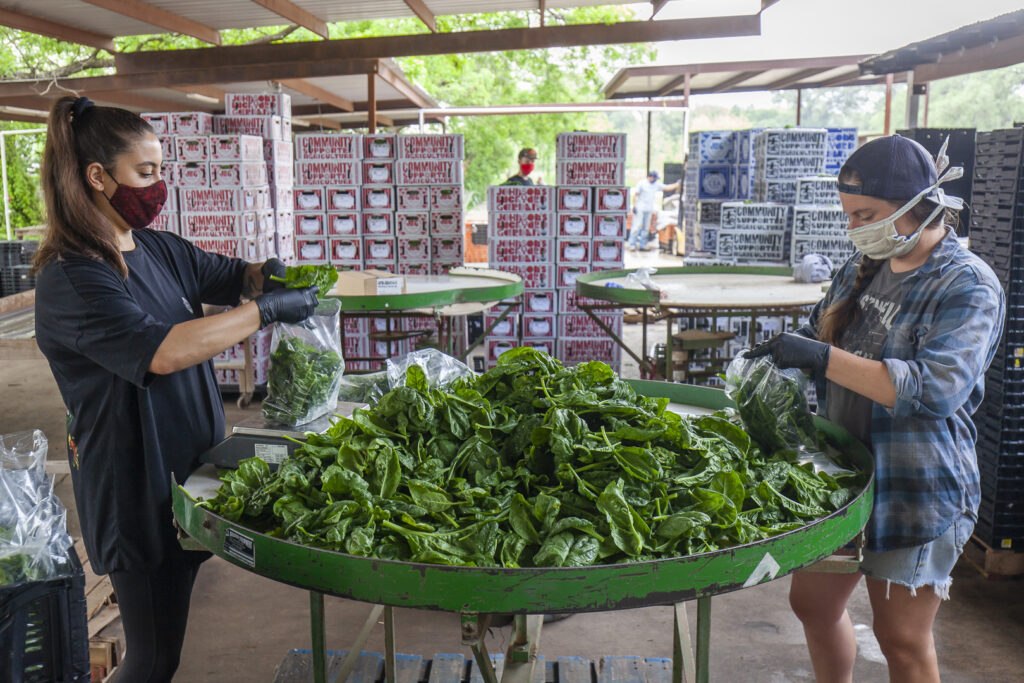
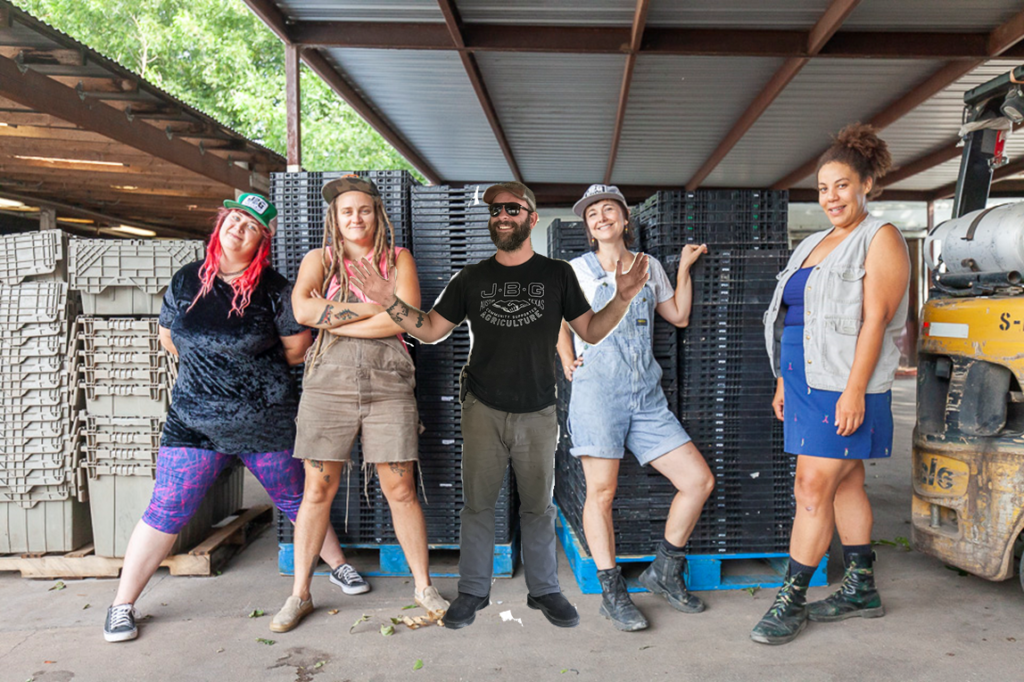
CSA BOX CONTENTS WEEK OF MAY 11TH
05/11/20 — Scott
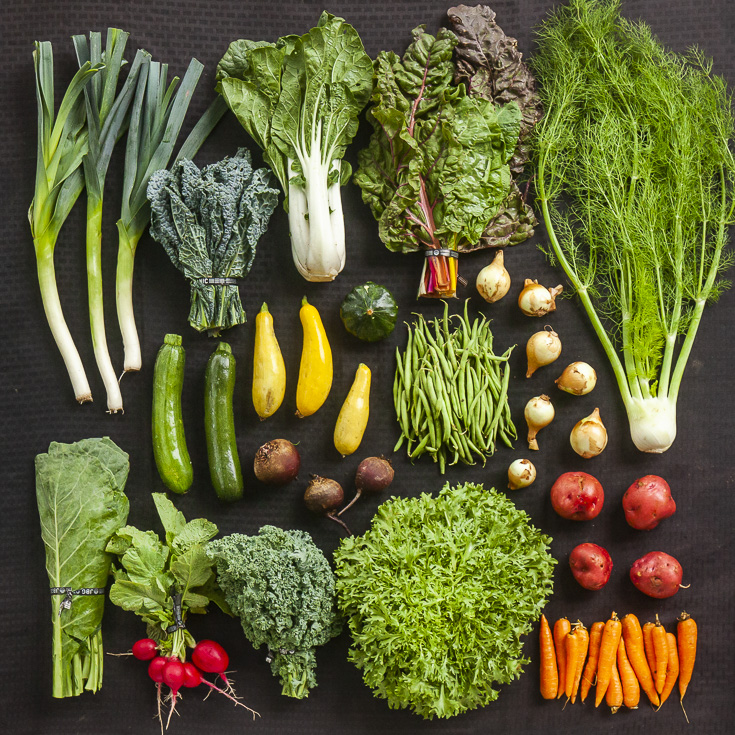 CSA Box Contents Week of May 11th
CSA Box Contents Week of May 11th
Large Box
Bok Choy, Baby
Celary
Greens, Chard, Rainbow
Herb, Farmers Choice
Herb, Fennel
Kohlrabi, Purple
Lettuce, Endive
Onions
Pepper, Sweet
Potato
Tomato, Green
Turnip, White Japanese
Bok Choy, Baby
Celary
Greens, Chard, Rainbow
Herb, Farmers Choice
Herb, Fennel
Kohlrabi, Purple
Lettuce, Endive
Onions
Pepper, Sweet
Potato
Tomato, Green
Turnip, White Japanese
Medium Box
Bok Choy, Baby
Celary
Farmers Choice
Greens, Chard, Rainbow
Herb, Farmers Choice
Herb, Fennel
Lettuce, Endive
Onions
Turnip, White Japanese
Bok Choy, Baby
Celary
Farmers Choice
Greens, Chard, Rainbow
Herb, Farmers Choice
Herb, Fennel
Lettuce, Endive
Onions
Turnip, White Japanese
Small Box
Bok Choy, Baby
Celary
Greens, Collards
Herb, Farmers Choice
Kohlrabi, Purple
Onions
Potato
Bok Choy, Baby
Celary
Greens, Collards
Herb, Farmers Choice
Kohlrabi, Purple
Onions
Potato
Individual Box
Celary
Farmers Choice
Greens, Collards
Herb, Farmers Choice
Herb, Fennel
Onions
Celary
Farmers Choice
Greens, Collards
Herb, Farmers Choice
Herb, Fennel
Onions
CSA BOX CONTENTS WEEK OF MAY 11TH
05/13/20 — Scott
 CSA Box Contents Week of May 11th
CSA Box Contents Week of May 11th
Large Box
Beets
Bok Choy
Farmers Choice
Greens, Collards
Greens, Kale, Curly
Herb, Fennel
Leek
Lettuce, Braising Mix
Lettuce, Romaine
Onion, White
Potato
Radish
Squash, Zucchini
WHAT TO DO WITH FENNEL
05/15/20 — Ada Broussard
You know what to do with carrots, and even your kids are fans of kale. But, fennel? For those of you new to this frilly frond, let us take a moment to orient you. Once you learn how versatile fennel is, you’ll be able to incorporate it into your weekly meals and consider the vegetable an ally that you’re excited about instead of a bulb that you dread.
![]() Fennily! A post all about fennel. Photo by Scott David Gordon.
Fennily! A post all about fennel. Photo by Scott David Gordon.
All parts of the fennel plant, root to stem to flower, are edible. The fennel that ends up in your CSA box or market haul has three main components, all delicious: bulb, stalks, and feathery fronds. Fennel is related to parsley (and carrot) family, and like the herb, adding fennel to any dish, raw or cooked, will help brighten up the dish and give it a fresh, herby flavor. When raw, fennel has a slightly anise flavor. And for all the licorice haters out there, you may think that your relationship with fennel stops at this sentence. But when cooked, fennel’s flavor mellows out, sweetens, and softens. Fennel is a common ingredient in Italian and French food, and when sauteed with onions, garlic, and maybe peppers or celery, fennel turns sweet and silky, adding to a flavor foundation worth building upon.
![]() Dill, parsley, and carrots are all cousins to the famed fennel. Use fennel fronds as a substitution for dill when they adorn your CSA box. Photo of dill by Scott David Gordon.
Dill, parsley, and carrots are all cousins to the famed fennel. Use fennel fronds as a substitution for dill when they adorn your CSA box. Photo of dill by Scott David Gordon.
Here at JBG, fennel makes its appearance in early fall, then takes a break during the coldest days, and makes a second and short debut in the spring, before temperature topple 100. In the cooler fall and winter months, fennel works beautifully with Texas citrus like grapefruit and blood oranges, and in the spring, fennel provides the refreshing crunch you need to brighten up a roasted beet salad, a placeholder for cucumbers and basil, both, before they make their debut.
![]() Now that's a bulb! Photo by Scott David Gordon.
Now that's a bulb! Photo by Scott David Gordon.
Raw: To enjoy fennel raw, slice the bulb very thinly using a sharp knife or mandolin. If you’re not using the sliced fennel right away, store it in the fridge in a closed container, submerged in water (with a squeeze of lemon). This will help keep the fennel crispy and crunchy. Shaved fennel is a wonderful anchor to any shaved salad or slaw. Add thinly sliced cabbage, radishes, and fresh herbs for a riff on coleslaw. Or, slice sweet bell peppers and cucumbers, and add shaved fennel and a creamy dressing for another take. Roasted beets, fennel, avocado, and sliced grapefruit is a surprisingly classic flavor combo. If you’re new to eating fennel this way, the trick really is in the slicing. It’s got to be thin. Sprinkle raw fennel fronds on top of anything as a replacement for fresh dill, parsley, or cilantro when it’s all you’ve got. If you’re lucky enough to get your hands on some fennel flowers, these too make wonderful, grassy garnishes.
![]() A simple shaved fennel salad, with root vegetables and a simple dressing. Photo and recipe by Mackenzie Smith.
A simple shaved fennel salad, with root vegetables and a simple dressing. Photo and recipe by Mackenzie Smith.
![]() The moment when fennel, zucchini, and tomatoes are available at the same time is brief. Don't dally to make this salad. Recipe and photo by Summer Migoni.
The moment when fennel, zucchini, and tomatoes are available at the same time is brief. Don't dally to make this salad. Recipe and photo by Summer Migoni.
Cooked: Cooked fennel (and cheese and good olive oil) may just be the secret ingredient that makes Italian food so addictive. Dice fennel bulbs and statue with onions and garlic the next time you’re making a soup or braise, or quarter the whole bulb and simply roast with a tray of whatever root veggies need some attention. Serve roasted fennel on its own, or while warm from the oven, toss with a simple vinaigrette to adorn a salad. Or, maybe you’ll cut the bulb into thin strings, like a half-moon onion, and add it to your next stir fry or fajita spread. We know that dicing the oddly folded bulb may not be as intuitive to an onion. Here is a pretty good youtube video explaining an easy way to do the deed. One of the best parts about slowly cooked fennel is how silky and soft the caramelized vegetable becomes. Given time, it will practically melt into whatever you're cooking, hiding its rich flavor into something that simply tastes deep, warm, and sweet. In other words, don’t worry too much about how you dice the veggie. Removing the tough core is a good idea, but even this part is technically edible.
![]()
Fancy Fronds: Fennel fronds should be treated just like any other fresh herb. Finely dice them to top cooked dishes or salads, or puree them up into your next batch of pesto or pistou. Here in the JBG office, we use our french press and make pots of fennel tea, lightly sweetened with honey (and mint, if it’s around) to add some variation to drinking plain water, all day. We even have a recipe for refreshing and iced fennel frond tea from the JBG archives.
![]() Fennel frond iced tea is a wonderful way to use the filly leaves. Photo and recipe by Mackenzie Smith.
Fennel frond iced tea is a wonderful way to use the filly leaves. Photo and recipe by Mackenzie Smith.
![]() Fennel look so stately growing out of the ground. Beneath the bulb is a large taproot, holding the stately plant upright. Photo by Scott David Gordon.
Fennel look so stately growing out of the ground. Beneath the bulb is a large taproot, holding the stately plant upright. Photo by Scott David Gordon.
A note on Fennel stems: Fennel stems may be the most overlooked portion of this plant. Use the fennel stems of very young and small fennel as a replacement for celery. Add very finely chopped fennel stalks (and bulbs, for that matter) the next time you’re prepping a mirepoix or sofrito. Once the stalks become big and thick, they are less tender and can be used simply to flavor soups, tossing the whole stem and then removing before you're ready to eat. Or, lay tough fennel stalks that have been sliced lengthwise at the bottom of any braises or pans of baked chicken. When in doubt, save fennel for your next batch of stock. But whatever you do, don’t leave fennel out of the fun. You’ll be a fennel fanatic before you know it, and you can thank us later.
![]() All lined up, ready for duty. Photo by Scott David Gordon
All lined up, ready for duty. Photo by Scott David Gordon
Fennel, Carrot, and Rutabaga Salad
Fennel and Sweet Potato Risotto
Fennel and Zucchini salad with citrus vinaigrette
Fennel Tea with Mint and Honey
Roasted fennel Toast
Curried fennel and cauliflower Soup
Sweet Potato Thyme Soup
Fennel Mac and Cheese
Fennel Saurkarut
![]() Fennel mac and cheese is never a bad idea. Photo and recipe by Megan Winfrey.
Fennel mac and cheese is never a bad idea. Photo and recipe by Megan Winfrey.
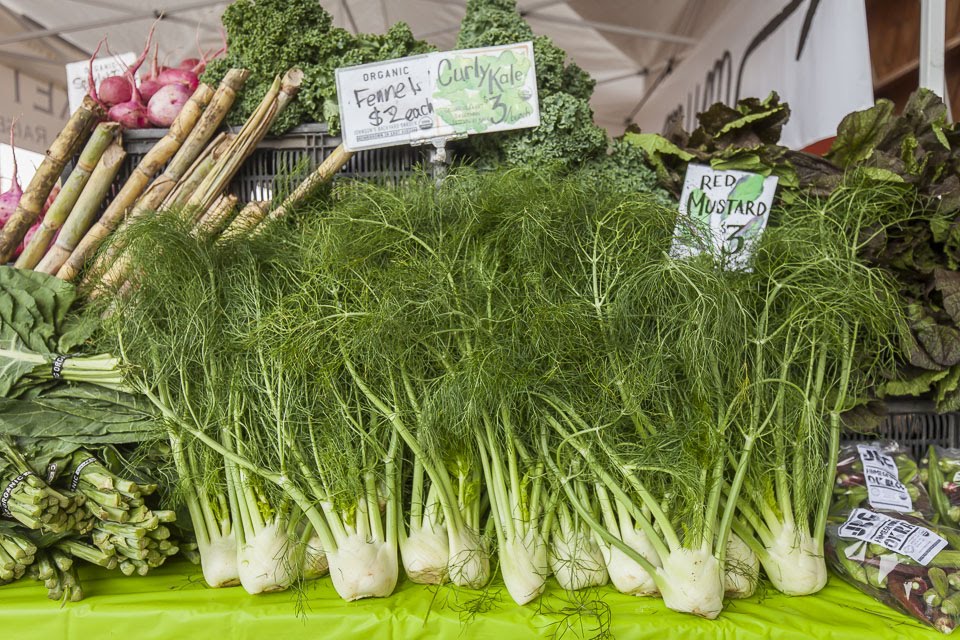 Fennily! A post all about fennel. Photo by Scott David Gordon.
Fennily! A post all about fennel. Photo by Scott David Gordon.
All parts of the fennel plant, root to stem to flower, are edible. The fennel that ends up in your CSA box or market haul has three main components, all delicious: bulb, stalks, and feathery fronds. Fennel is related to parsley (and carrot) family, and like the herb, adding fennel to any dish, raw or cooked, will help brighten up the dish and give it a fresh, herby flavor. When raw, fennel has a slightly anise flavor. And for all the licorice haters out there, you may think that your relationship with fennel stops at this sentence. But when cooked, fennel’s flavor mellows out, sweetens, and softens. Fennel is a common ingredient in Italian and French food, and when sauteed with onions, garlic, and maybe peppers or celery, fennel turns sweet and silky, adding to a flavor foundation worth building upon.
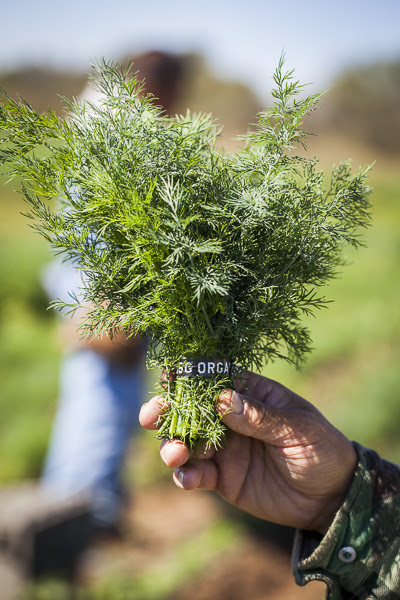 Dill, parsley, and carrots are all cousins to the famed fennel. Use fennel fronds as a substitution for dill when they adorn your CSA box. Photo of dill by Scott David Gordon.
Dill, parsley, and carrots are all cousins to the famed fennel. Use fennel fronds as a substitution for dill when they adorn your CSA box. Photo of dill by Scott David Gordon.
Here at JBG, fennel makes its appearance in early fall, then takes a break during the coldest days, and makes a second and short debut in the spring, before temperature topple 100. In the cooler fall and winter months, fennel works beautifully with Texas citrus like grapefruit and blood oranges, and in the spring, fennel provides the refreshing crunch you need to brighten up a roasted beet salad, a placeholder for cucumbers and basil, both, before they make their debut.
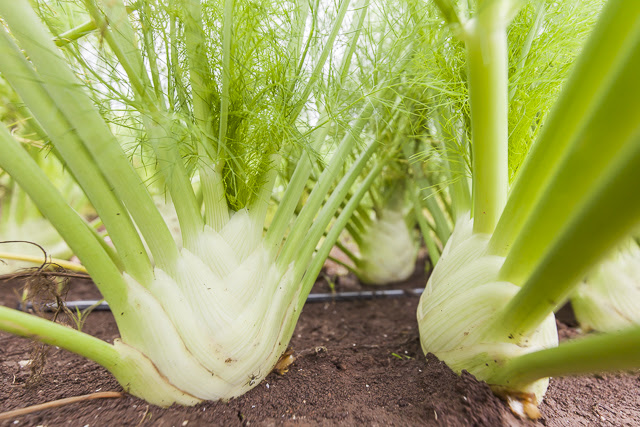 Now that's a bulb! Photo by Scott David Gordon.
Now that's a bulb! Photo by Scott David Gordon.
Raw: To enjoy fennel raw, slice the bulb very thinly using a sharp knife or mandolin. If you’re not using the sliced fennel right away, store it in the fridge in a closed container, submerged in water (with a squeeze of lemon). This will help keep the fennel crispy and crunchy. Shaved fennel is a wonderful anchor to any shaved salad or slaw. Add thinly sliced cabbage, radishes, and fresh herbs for a riff on coleslaw. Or, slice sweet bell peppers and cucumbers, and add shaved fennel and a creamy dressing for another take. Roasted beets, fennel, avocado, and sliced grapefruit is a surprisingly classic flavor combo. If you’re new to eating fennel this way, the trick really is in the slicing. It’s got to be thin. Sprinkle raw fennel fronds on top of anything as a replacement for fresh dill, parsley, or cilantro when it’s all you’ve got. If you’re lucky enough to get your hands on some fennel flowers, these too make wonderful, grassy garnishes.
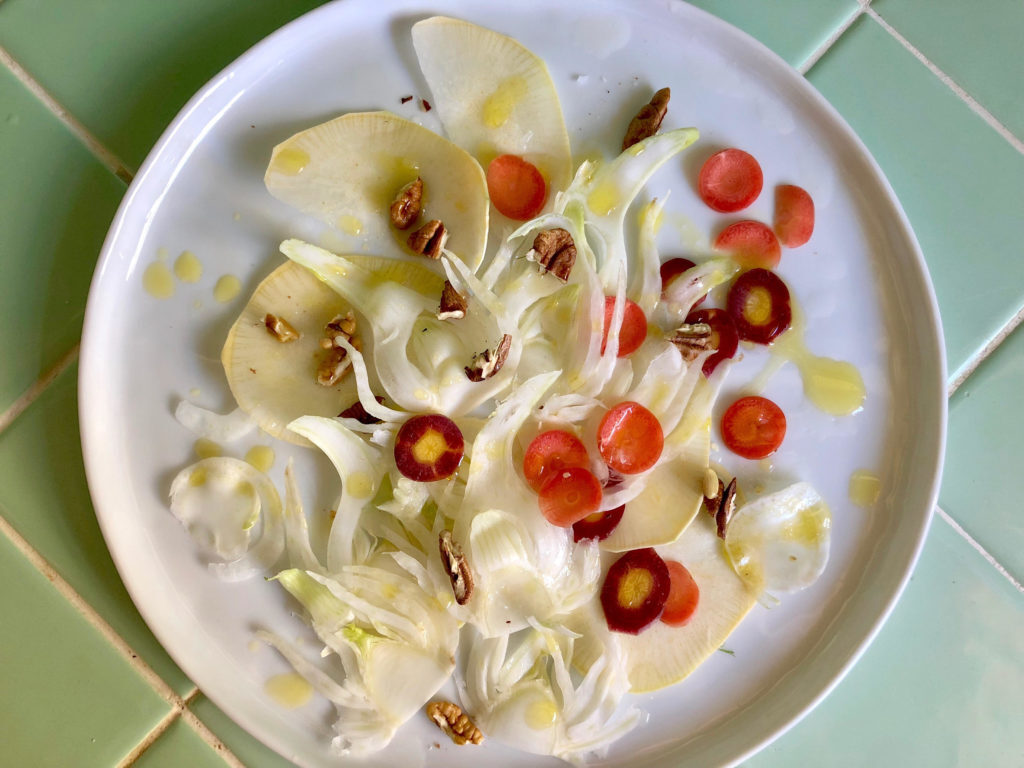 A simple shaved fennel salad, with root vegetables and a simple dressing. Photo and recipe by Mackenzie Smith.
A simple shaved fennel salad, with root vegetables and a simple dressing. Photo and recipe by Mackenzie Smith.
 The moment when fennel, zucchini, and tomatoes are available at the same time is brief. Don't dally to make this salad. Recipe and photo by Summer Migoni.
The moment when fennel, zucchini, and tomatoes are available at the same time is brief. Don't dally to make this salad. Recipe and photo by Summer Migoni.
Cooked: Cooked fennel (and cheese and good olive oil) may just be the secret ingredient that makes Italian food so addictive. Dice fennel bulbs and statue with onions and garlic the next time you’re making a soup or braise, or quarter the whole bulb and simply roast with a tray of whatever root veggies need some attention. Serve roasted fennel on its own, or while warm from the oven, toss with a simple vinaigrette to adorn a salad. Or, maybe you’ll cut the bulb into thin strings, like a half-moon onion, and add it to your next stir fry or fajita spread. We know that dicing the oddly folded bulb may not be as intuitive to an onion. Here is a pretty good youtube video explaining an easy way to do the deed. One of the best parts about slowly cooked fennel is how silky and soft the caramelized vegetable becomes. Given time, it will practically melt into whatever you're cooking, hiding its rich flavor into something that simply tastes deep, warm, and sweet. In other words, don’t worry too much about how you dice the veggie. Removing the tough core is a good idea, but even this part is technically edible.
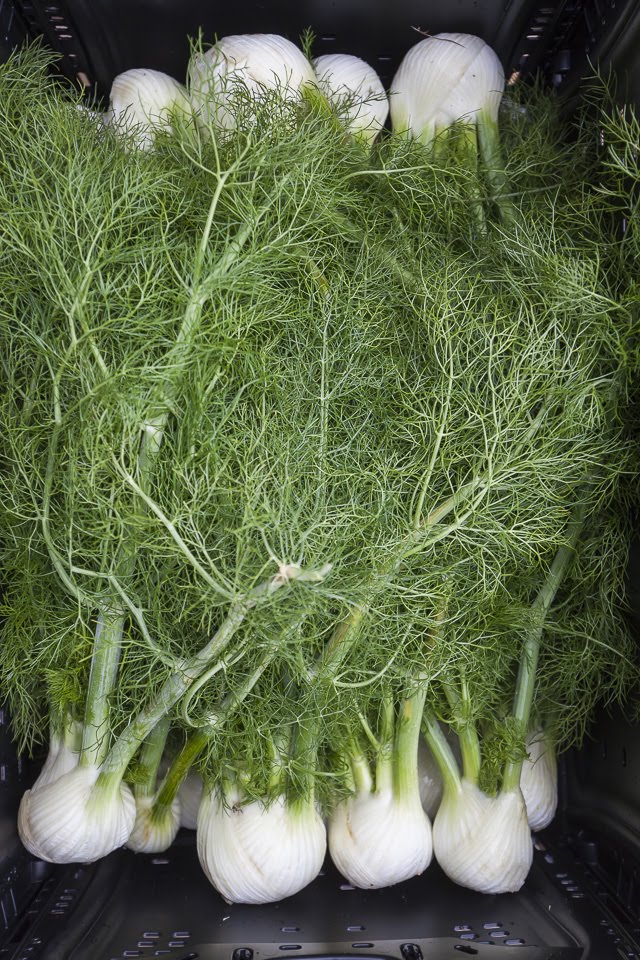
Fancy Fronds: Fennel fronds should be treated just like any other fresh herb. Finely dice them to top cooked dishes or salads, or puree them up into your next batch of pesto or pistou. Here in the JBG office, we use our french press and make pots of fennel tea, lightly sweetened with honey (and mint, if it’s around) to add some variation to drinking plain water, all day. We even have a recipe for refreshing and iced fennel frond tea from the JBG archives.
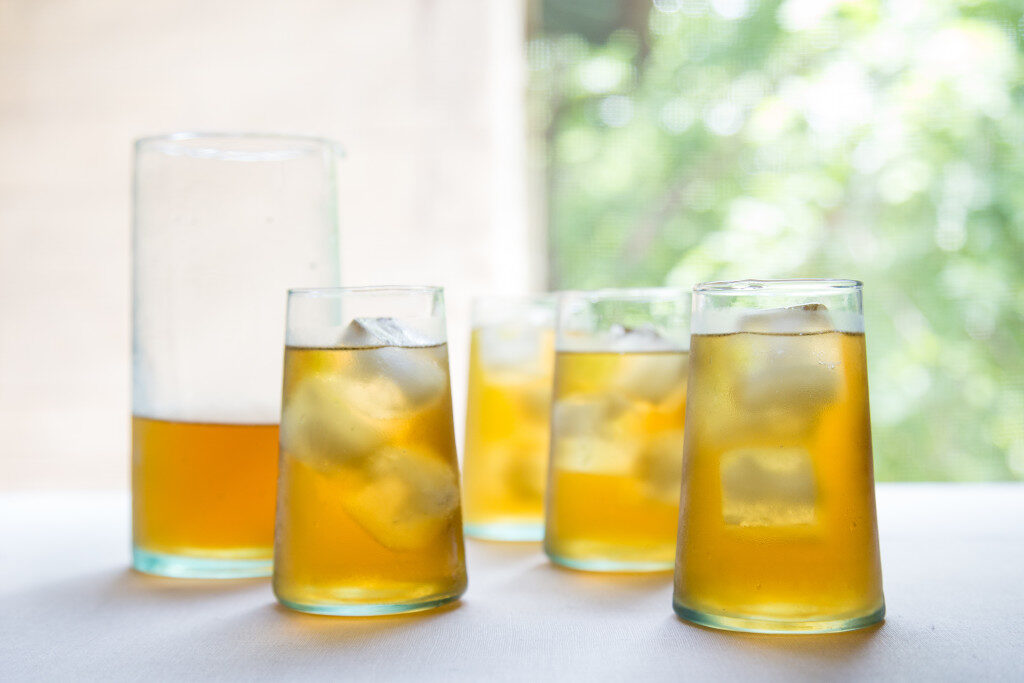 Fennel frond iced tea is a wonderful way to use the filly leaves. Photo and recipe by Mackenzie Smith.
Fennel frond iced tea is a wonderful way to use the filly leaves. Photo and recipe by Mackenzie Smith.
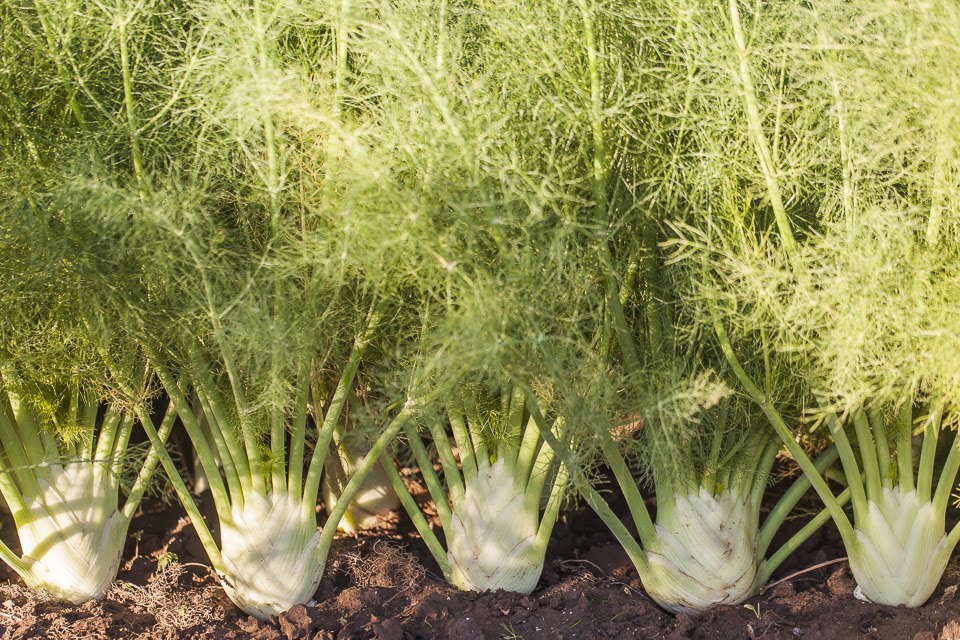 Fennel look so stately growing out of the ground. Beneath the bulb is a large taproot, holding the stately plant upright. Photo by Scott David Gordon.
Fennel look so stately growing out of the ground. Beneath the bulb is a large taproot, holding the stately plant upright. Photo by Scott David Gordon.
A note on Fennel stems: Fennel stems may be the most overlooked portion of this plant. Use the fennel stems of very young and small fennel as a replacement for celery. Add very finely chopped fennel stalks (and bulbs, for that matter) the next time you’re prepping a mirepoix or sofrito. Once the stalks become big and thick, they are less tender and can be used simply to flavor soups, tossing the whole stem and then removing before you're ready to eat. Or, lay tough fennel stalks that have been sliced lengthwise at the bottom of any braises or pans of baked chicken. When in doubt, save fennel for your next batch of stock. But whatever you do, don’t leave fennel out of the fun. You’ll be a fennel fanatic before you know it, and you can thank us later.
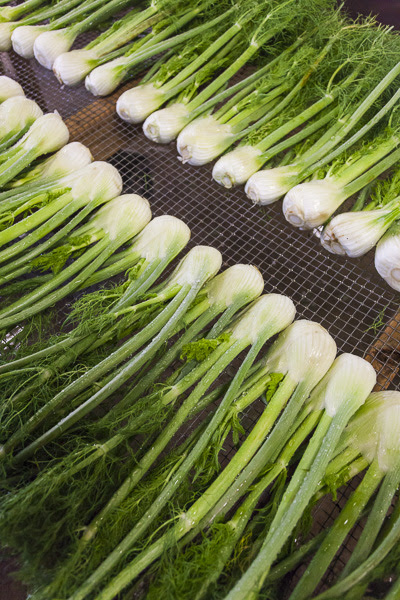 All lined up, ready for duty. Photo by Scott David Gordon
All lined up, ready for duty. Photo by Scott David Gordon
Fennel Recipes from the JBG Archive:
Wilted Kale, Bacon, and Fennel SaladFennel, Carrot, and Rutabaga Salad
Fennel and Sweet Potato Risotto
Fennel and Zucchini salad with citrus vinaigrette
Fennel Tea with Mint and Honey
Roasted fennel Toast
Curried fennel and cauliflower Soup
Sweet Potato Thyme Soup
Fennel Mac and Cheese
Fennel Saurkarut
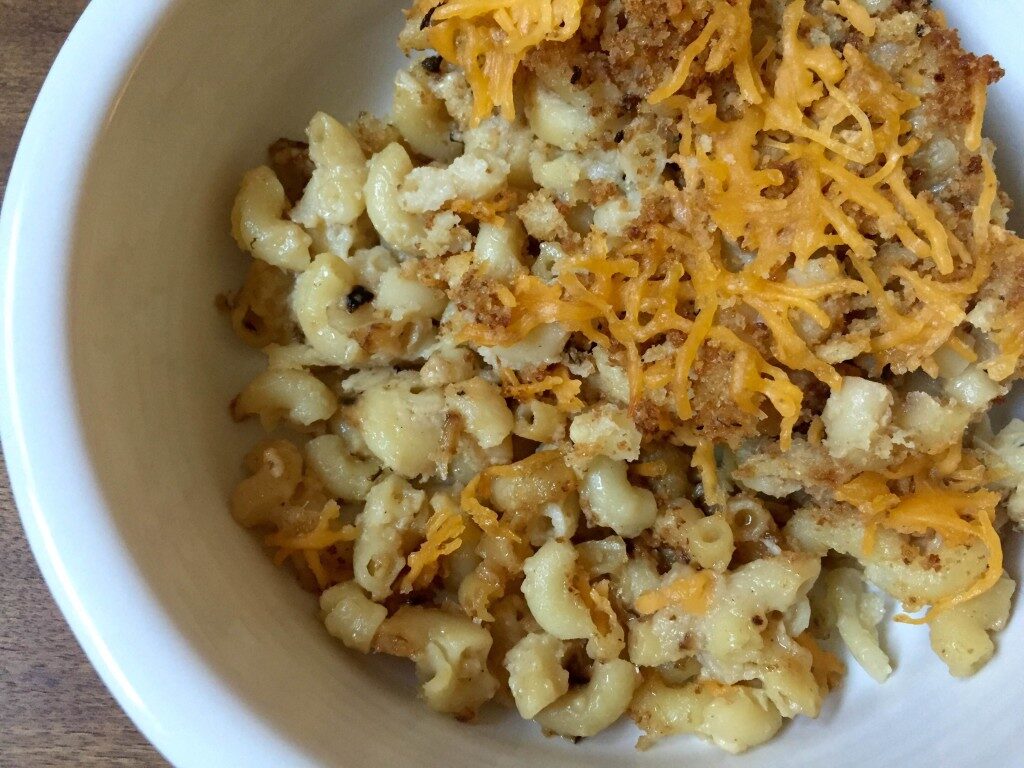 Fennel mac and cheese is never a bad idea. Photo and recipe by Megan Winfrey.
Fennel mac and cheese is never a bad idea. Photo and recipe by Megan Winfrey.
CSA BOX CONTENTS WEEK OF MAY 18TH
05/18/20 — Scott
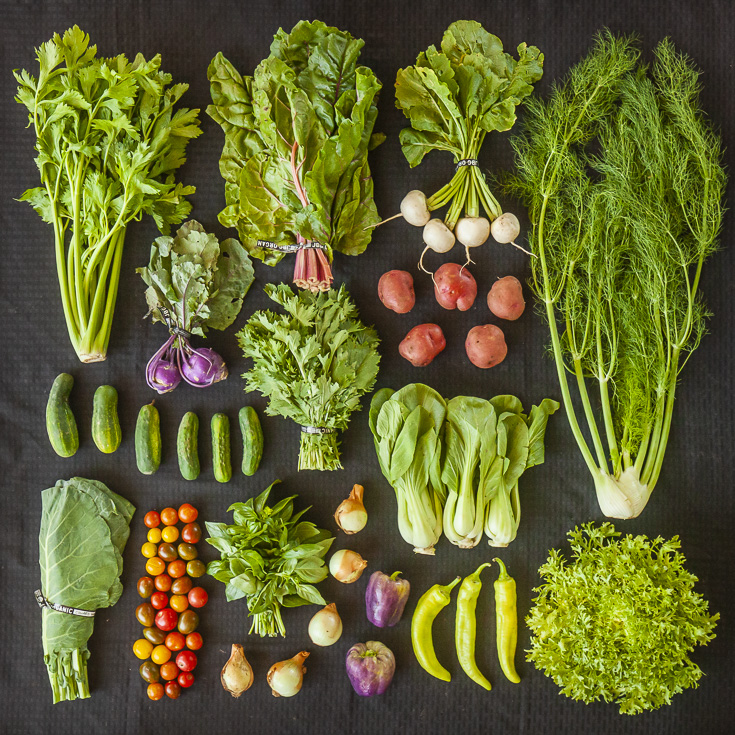 CSA Box Contents Week of May 18th
CSA Box Contents Week of May 18th
Large Box
Bean, Green
Carrots
Celery
Farmers Choice
Greens, Amaranth
Greens, Chard, Rainbow
Herb, Farmers Choice
Pepper, Sweet
Potato
Radish
Squash / Cucumber
Turnip, White Japanese
Bean, Green
Carrots
Celery
Farmers Choice
Greens, Amaranth
Greens, Chard, Rainbow
Herb, Farmers Choice
Pepper, Sweet
Potato
Radish
Squash / Cucumber
Turnip, White Japanese
Medium Box
Bean, Green
Carrots
Celery
Farmers Choice
Herb, Farmers Choice
Pepper, Sweet
Potato
Squash / Cucumber
Turnip, White Japanese
Bean, Green
Carrots
Celery
Farmers Choice
Herb, Farmers Choice
Pepper, Sweet
Potato
Squash / Cucumber
Turnip, White Japanese
Small Box
Beets
Cabbage
Herb, Farmers Choice
Herb, Farmers Choice
Pepper, Sweet
Potato
Radish
Squash / Cucumber
Beets
Cabbage
Herb, Farmers Choice
Herb, Farmers Choice
Pepper, Sweet
Potato
Radish
Squash / Cucumber
Individual Box
Beets
Cabbage
Greens, Chard, Rainbow
Herb, Farmers Choice
Potato
Beets
Cabbage
Greens, Chard, Rainbow
Herb, Farmers Choice
Potato
CSA BOX CONTENTS WEEK OF MAY 18TH
05/19/20 — Scott
 CSA Box Contents Week of May 18th
CSA Box Contents Week of May 18th
Large Box
Bok Choy, Baby
Celery
Greens, Chard, Rainbow
Herb, Farmers Choice
Herb, Farmers Choice
Herb, Fennel
Kohlrabi, Purple
Lettuce, Endive
Onions
Pepper, Sweet
Potato
Tomato, Green
Turnip, White Japanese
BALSAMIC ONION JAM
05/21/20 — Ada Broussard
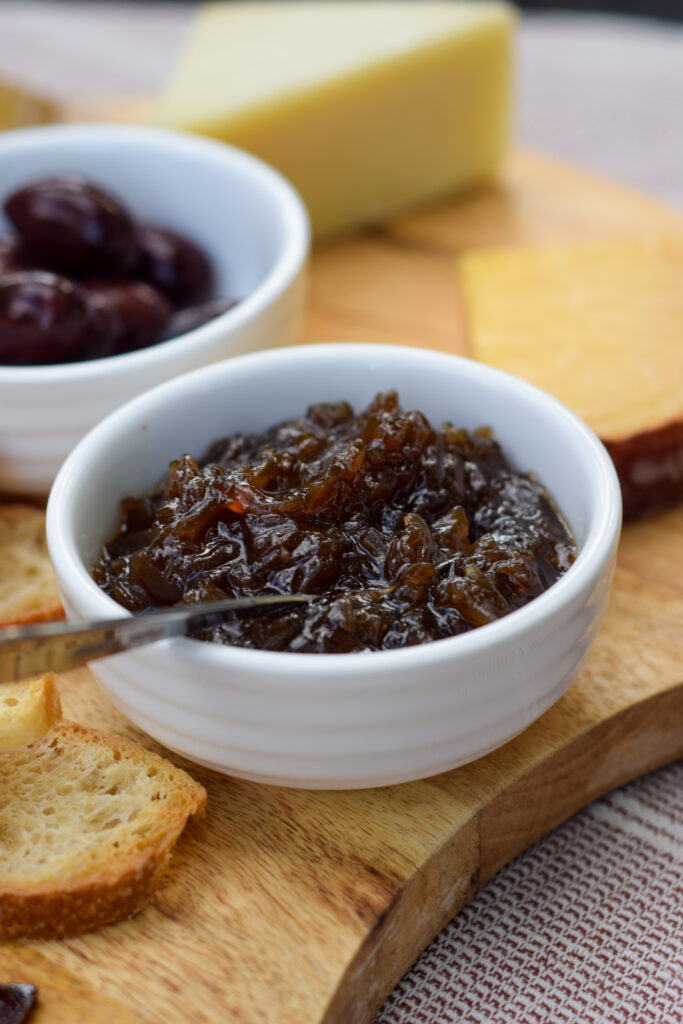
Balsamic Onion Jam Makes 2 cups Author: The Migoni Kitchen Total Time: 1 hour 45 minutes
We were so excited to get some beautiful spring onions in our box this week so we opted to make a delicious onion jam with them! It’s a great way to use up a lot of onions all at once and preserve them for later use. Plus, this is such a delicious condiment to pair with a cheeseboard, use on sandwiches, or top off burgers. With Memorial Day this weekend - this would be an excellent topping for backyard burgers!
You can also create many different variations. We’ve added bacon before - especially delicious on burgers! You can also add rosemary and thyme for an herbed onion jam. You can add some pepperoncini peppers (or the gorgeous cherry bomb peppers we sometimes get in our box!) for a spicy version. You get the point!
The jam does require a bit of time to cook, but is super easy! We used a bit of fruit pectin in ours to create a more jammy consistency, but you can sub with lemon juice as an alternative.
Ingredients: 2 Lbs Spring Onions, diced 1 Cup Granulated Sugar 4 Tbsp Balsamic Vinegar 4 Tbsp Olive Oil 2 Tsps Fruit Pectin OR 2 Tbsp Lemon Juice ½ Cup Water
Instructions:
Add the diced onions and olive oil to a large pot with a lid (we used a Dutch Oven). Place over medium heat and cover with lid. Cook for about 15 minutes. Remove the lid and stir the onions. There will likely be a lot of liquid in the pot, which is normal. Next, add the balsamic vinegar, sugar, and fruit pectin. Stir to combine and reduce heat to low-medium heat. Allow to simmer without a lid for about 90 minutes, stirring once every 10-15 minutes to ensure the onions are not sticking. Add small amounts of water a time to help prevent sticking. We used about ½ a cup of water total, adding in 2-3 tablespoons at a time. Remove from heat once the jam has reached a dark brown color and the onions have a soft texture. Allow to cool before jarring.
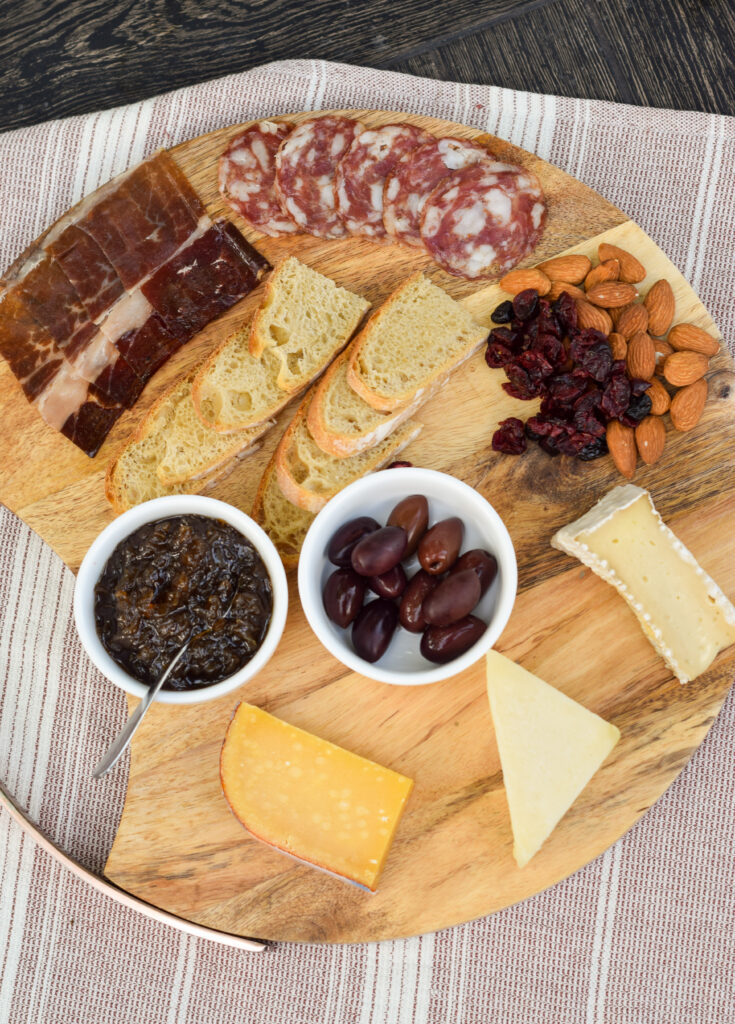
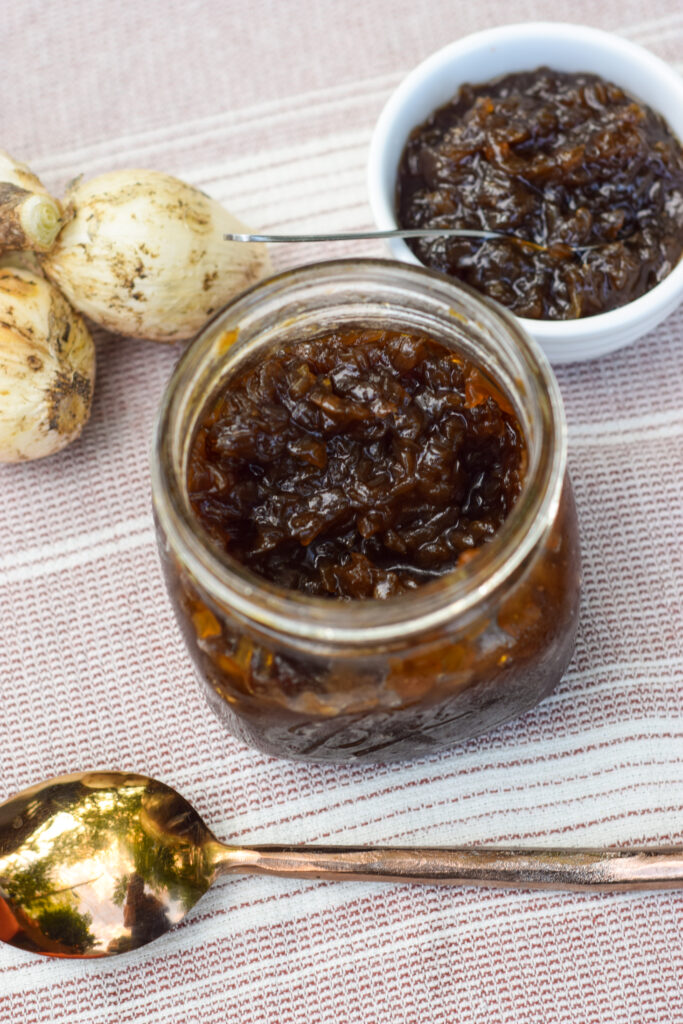
FARM UPDATE
05/22/20 — Ada Broussard
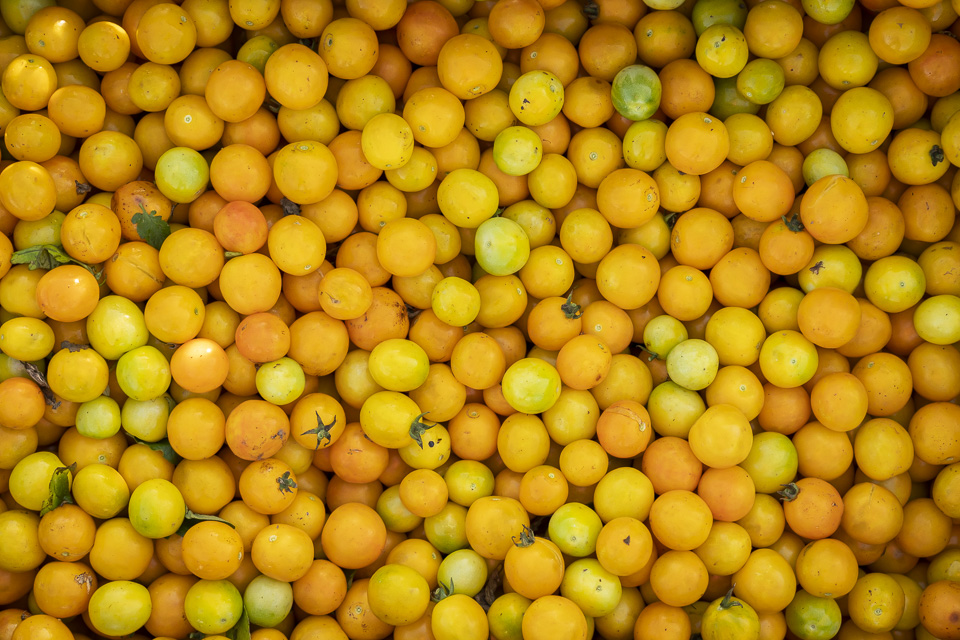
Things were busy this week at the farm (see the photos here)- the Tomato Presale is under way (order here), CSA boxes are flying off the line, and our squash plants are really starting to put on fruit. The first of the tomatoes have even begun to roll in, inducing an all-farm feeling of giddy excitement and exhausted dread... all at once. If this warm weather keeps up, the 15,000 tomato plants that we put into the ground this year will soon be dripping with ripe fruit before we know it.
There were several mechanical obstacles to overcome this week, including a forklift that finally was tired beyond repair. Our potato harvester also needed some sudden attention, which meant long calls to parts dealers and some serious bartering with local welders and machine shops .
Last October, our friend Bud Force shot parts of a commercial for Cavender's at the farm. We all-but forgot about this fun day, until this week when we caught a glimpse of the final product. Watch the short docu-style commercial here, and see if you can't spot a familiar farmer! Unlike most commercials, the men and women featured here are real ranchers, farmers, and cowboys.. not actors.
Last, East Side Magazine recently published this story about the farm, and we thought we'd include it here for you to see! Thank you East Side Magazine and Jessi for shining a spotlight on the farm, we appreciate it!
Thanks for reading, and stay well!
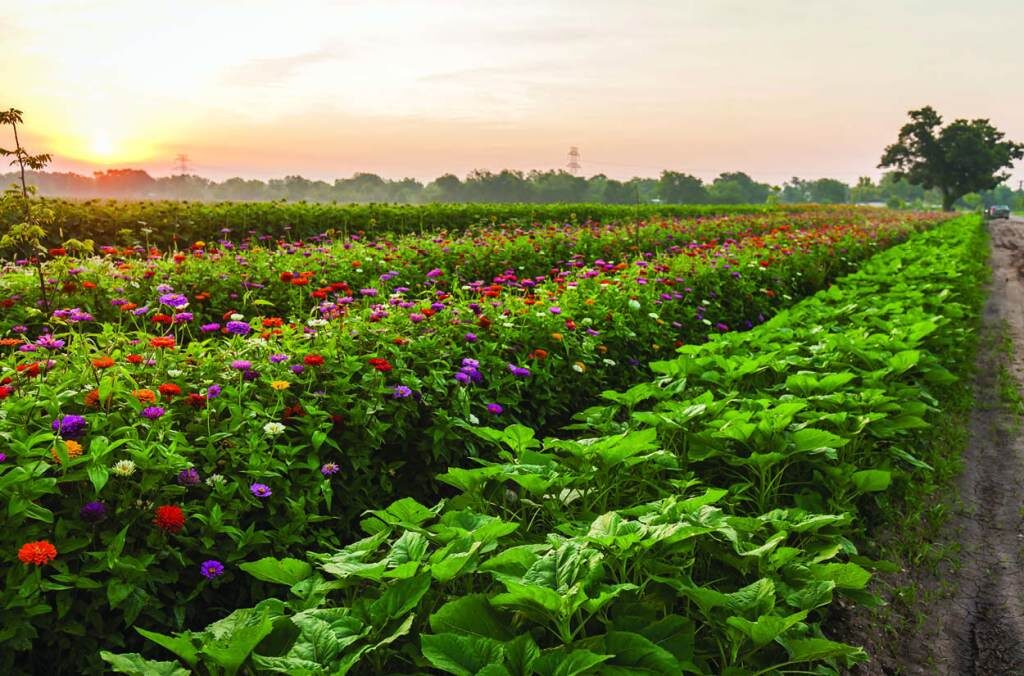
Get Out in the Backyard Johnson’s Backyard Garden offers space to grow in community.
Words by Jessi Devenyns Photos by Scott David Gordon\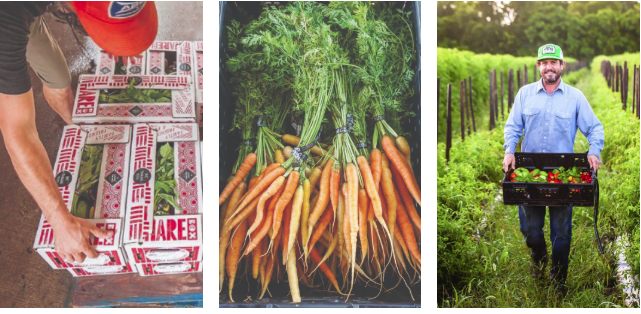
Brenton Johnson, East Austin resident behind Johnson’s Backyard Garden (JBG), has always enjoyed plants, but he didn’t always know how to grow them. It was in college that the future farm owner discovered his knack for cultivating houseplants, which set a domino effect into motion that led to him abruptly switch majors from mechanical engineering to agricultural engineering in the hopes of working one day on an organic farm on the West Coast. Instead of leading him immediately to life on the farm though, Brenton got a 9-5.
Working a desk job never stopped Brenton from getting his hands dirty. While working for the government in early 2000, Brenton began transforming his yard into a vegetable garden, which, in addition to growing produce, sprouted a community of neighbors and volunteers. “When I first started, I put an ad on Craigslist, and I ended up getting two volunteers,” Brenton recalls. “And those two volunteers ended up having a really long relationship with JBG.”
The farm today That relationship flourished as Brenton’s farm grew from an overflowing backyard full of chickens and vegetables in the Holly neighborhood to a 20-acre site in East Austin to now a commercial enterprise that is located outside the city limits, but still east.
Nearly 20 years later, JBG is a far cry from the neighborhood Community Supported Agriculture (CSA) program that it started as. Today, Brenton’s vegetable patch is a sprawling 186 acres in Garfield, Texas, with 100 employees who range from greenhouse managers and farmhands to operations directors and delivery drivers. One thing that has not changed, however, is Brenton’s dedication to teaching agriculture to Austinites and developing gardeners out of volunteers.
Despite operating at a scale that allows for the provision of fresh produce to local restaurants and markets, volunteers are still a core force of the operations at JBG. Dozens of local residents trek to the organic farm on any given day to exercise their skills in gardening, preparing CSA boxes, or working at the markets.
Connection to nature and neighbor Besides the satisfaction of absorbing fresh air and sunshine alongside the plants, each volunteer has the option to indulge in the fruits of their labor with some veggies. Not only that, but the 20-minute drive to Garfield has the ability to transport Austin-dwellers into another realm: one that provides a purposeful connection to nature and neighbors.
Brenton says that’s exactly what makes time spent on the farm so idyllic. Vegetables require long hours of tending, but that careful attention allows for a thriving business and community to be built from the seeds of crisp rainbow chard and sun-ripened tomatoes.
Support a Farm & Eat Fresh Austinites looking for fresh produce can join the farm’s Community Supported Agriculture (CSA) program where they can select from a variety of box sizes and delivery schedules to suit their culinary needs. Summer produce shares include crowd favorites like homegrown tomatoes, watermelon, and squash. Be sure to check their website for updates and availability.
PHOTOS FROM THE FARM: 5.22.20
05/22/20 — Ada Broussard
One post, two weeks at the farm. Below you'll see Scott's photos from the past two weeks at JBG. He visited the fields and the barn, and experienced days of downpour as well as days of extreme heat. In just a mere week, a lot can happen at a farm: new crops are ready, old ones retire, machines break and then are fixed, and all the while the crops rolls in so we can roll them out. Have you been enjoying the vegetables? Scroll to see where and how they're grown!
![]() Before there are tomatoes, there are green leafy plants. These nightshades take nutrients from the soil and energy from the sun and leaf out. Only then, will they set fruit. Right now, the farm is full of tomato plants, heavy with fruit. Next up: Ripening! Photo by Scott David Gordon.
Before there are tomatoes, there are green leafy plants. These nightshades take nutrients from the soil and energy from the sun and leaf out. Only then, will they set fruit. Right now, the farm is full of tomato plants, heavy with fruit. Next up: Ripening! Photo by Scott David Gordon.
![]() Some tomatoes we cage, some we stake. These tomatoes are planted between wooden stakes, and will be propped up by a trellis system called the Florida Weave. Photo by Scott David Gordon.
Some tomatoes we cage, some we stake. These tomatoes are planted between wooden stakes, and will be propped up by a trellis system called the Florida Weave. Photo by Scott David Gordon.
![]() How well do you know your tomatoes? Can you identify these oblong, paste tomatoes? Photo by Scott David Gordon.
How well do you know your tomatoes? Can you identify these oblong, paste tomatoes? Photo by Scott David Gordon.
![]() Where would basil be without tomatoes, and vice-a-versa? Photo by Scott David Gordon.
Where would basil be without tomatoes, and vice-a-versa? Photo by Scott David Gordon.
![]() And just like that, there were peppers. Photo by Scott David Gordon.
And just like that, there were peppers. Photo by Scott David Gordon.
![]() Plenty of peppers. Photo by Scott David Gordon.
Plenty of peppers. Photo by Scott David Gordon.
![]() Leeks, the more temporal allium of the season, showing off their pale hues and long curves. Photo by Scott David Gordon.
Leeks, the more temporal allium of the season, showing off their pale hues and long curves. Photo by Scott David Gordon.
![]() New sign at the Garfield Farm so the volunteers don't head to the stage the mechanic doesn't report to the greenhouse. Photo by Scott David Gordon, sign by Adam (we think).
New sign at the Garfield Farm so the volunteers don't head to the stage the mechanic doesn't report to the greenhouse. Photo by Scott David Gordon, sign by Adam (we think).
![]() It's straw hat season, y'all! Perhaps it's a surprise to you, but it remains jean and long-sleeve shirt season year round. There is no better way to protect from the sun, bugs, and weeds than coverage! Photo by Scott David Gordon.
It's straw hat season, y'all! Perhaps it's a surprise to you, but it remains jean and long-sleeve shirt season year round. There is no better way to protect from the sun, bugs, and weeds than coverage! Photo by Scott David Gordon.
![]() Scarlet turnips, by the bin. Photo by Scott David Gordon.
Scarlet turnips, by the bin. Photo by Scott David Gordon.
![]() Alternative collard banding, right around the middle. Photo by Scott David Gordon.
Alternative collard banding, right around the middle. Photo by Scott David Gordon.
![]() One long row, so many collards. Photo by Scott David Gordon.
One long row, so many collards. Photo by Scott David Gordon.
![]() Vicente gets busy cultivating! As temperatures heat up, so does the weed pressure. Photo by Scott David Gordon.
Vicente gets busy cultivating! As temperatures heat up, so does the weed pressure. Photo by Scott David Gordon.
![]() Our very first squash made their debut last week. How beautiful are they!? Photo by Scott David Gordon.
Our very first squash made their debut last week. How beautiful are they!? Photo by Scott David Gordon.
![]() Fun fact? When this logo was designed years ago, the lines in the block letters were inspired by the line of our crop beds. Now that you know, bet you won't forget! Photo by Scott David Gordon.
Fun fact? When this logo was designed years ago, the lines in the block letters were inspired by the line of our crop beds. Now that you know, bet you won't forget! Photo by Scott David Gordon.
![]() Welcome to the team! New (to us) fork lift for the farm! This is a BIG deal! Photo by Scott David Gordon.
Welcome to the team! New (to us) fork lift for the farm! This is a BIG deal! Photo by Scott David Gordon.
![]() A smattering of orange and green and one of our most popular crops. Photo by Scott David Gordon.
A smattering of orange and green and one of our most popular crops. Photo by Scott David Gordon.
![]() Rainy days, endless carrots. Photo by Scott David Gordon.
Rainy days, endless carrots. Photo by Scott David Gordon.
![]() Andrew organizing the city of CSA. Photo by Scott David Gordon.
Andrew organizing the city of CSA. Photo by Scott David Gordon.
![]() Temo, in the middle of the Hergotz pack shed, addressing a spot in the concrete that was known for spilling multiple carts of beets and towers of turnips. Photo by Scott David Gordon.
Temo, in the middle of the Hergotz pack shed, addressing a spot in the concrete that was known for spilling multiple carts of beets and towers of turnips. Photo by Scott David Gordon.
![]() The pink and the green are complementary colors, but we swear we didn't plan it. Photo by Scott David Gordon.
The pink and the green are complementary colors, but we swear we didn't plan it. Photo by Scott David Gordon.
![]() Bulk beets get harvested into these big bins, and then washed in our nifty-difty barrel washer. Photo by Scott David Gordon.
Bulk beets get harvested into these big bins, and then washed in our nifty-difty barrel washer. Photo by Scott David Gordon.
![]() Here the come, out the other side! Photo by Scott David Gordon.
Here the come, out the other side! Photo by Scott David Gordon.
![]() Veggies sorted, washed, packed, and ready for their final home. Hopefully it's your dinner plate! Photo by Scott David Gordon.
Veggies sorted, washed, packed, and ready for their final home. Hopefully it's your dinner plate! Photo by Scott David Gordon.
Week of 5.22.20 Photos
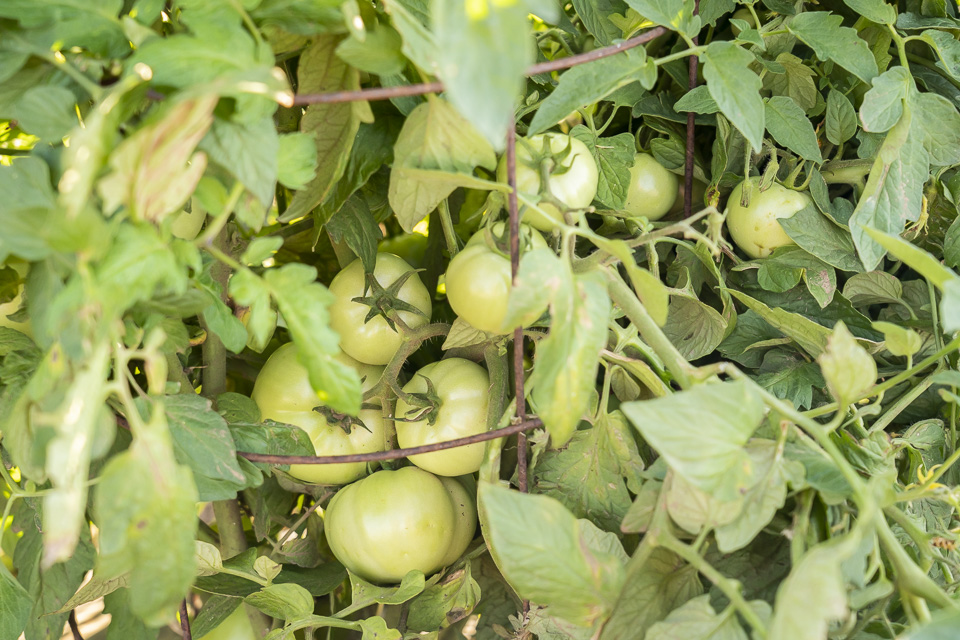 Before there are tomatoes, there are green leafy plants. These nightshades take nutrients from the soil and energy from the sun and leaf out. Only then, will they set fruit. Right now, the farm is full of tomato plants, heavy with fruit. Next up: Ripening! Photo by Scott David Gordon.
Before there are tomatoes, there are green leafy plants. These nightshades take nutrients from the soil and energy from the sun and leaf out. Only then, will they set fruit. Right now, the farm is full of tomato plants, heavy with fruit. Next up: Ripening! Photo by Scott David Gordon.
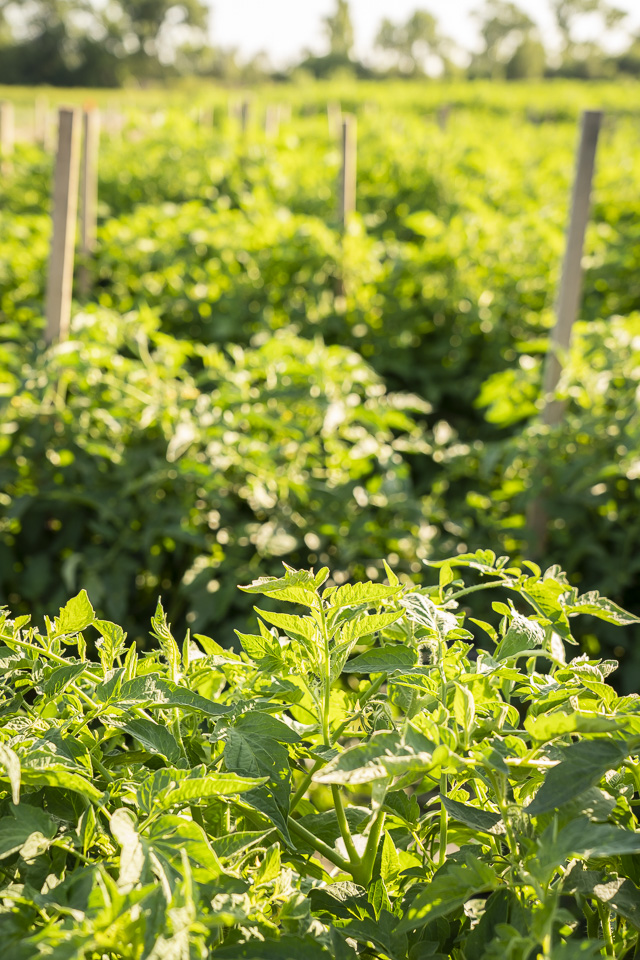 Some tomatoes we cage, some we stake. These tomatoes are planted between wooden stakes, and will be propped up by a trellis system called the Florida Weave. Photo by Scott David Gordon.
Some tomatoes we cage, some we stake. These tomatoes are planted between wooden stakes, and will be propped up by a trellis system called the Florida Weave. Photo by Scott David Gordon.
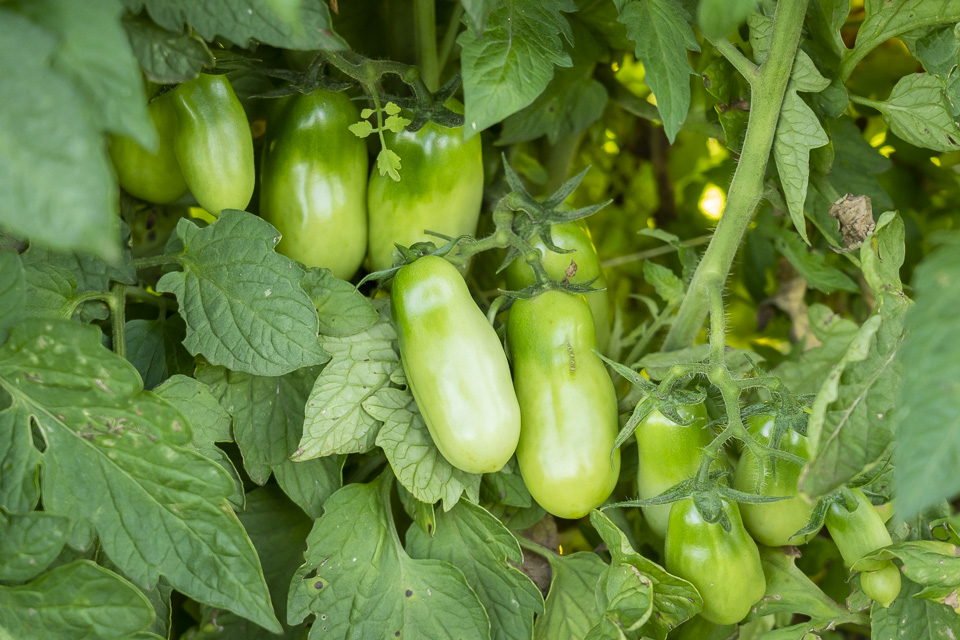 How well do you know your tomatoes? Can you identify these oblong, paste tomatoes? Photo by Scott David Gordon.
How well do you know your tomatoes? Can you identify these oblong, paste tomatoes? Photo by Scott David Gordon.
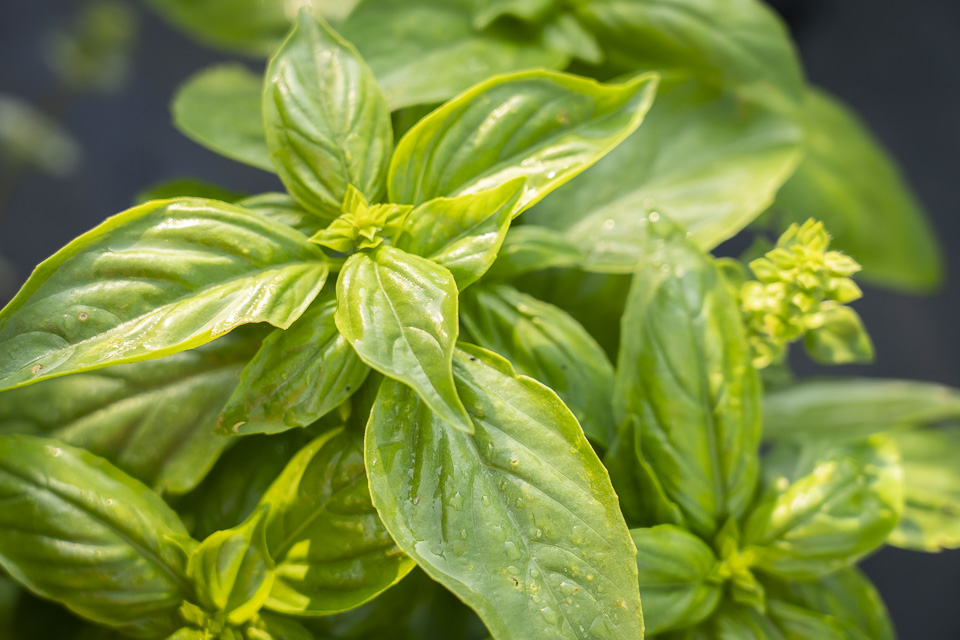 Where would basil be without tomatoes, and vice-a-versa? Photo by Scott David Gordon.
Where would basil be without tomatoes, and vice-a-versa? Photo by Scott David Gordon.
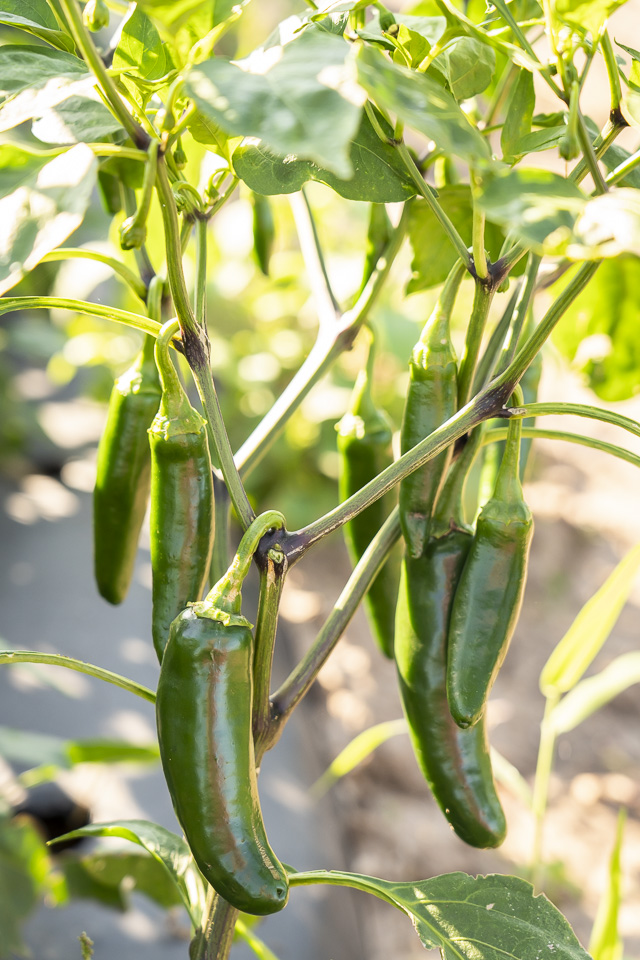 And just like that, there were peppers. Photo by Scott David Gordon.
And just like that, there were peppers. Photo by Scott David Gordon.
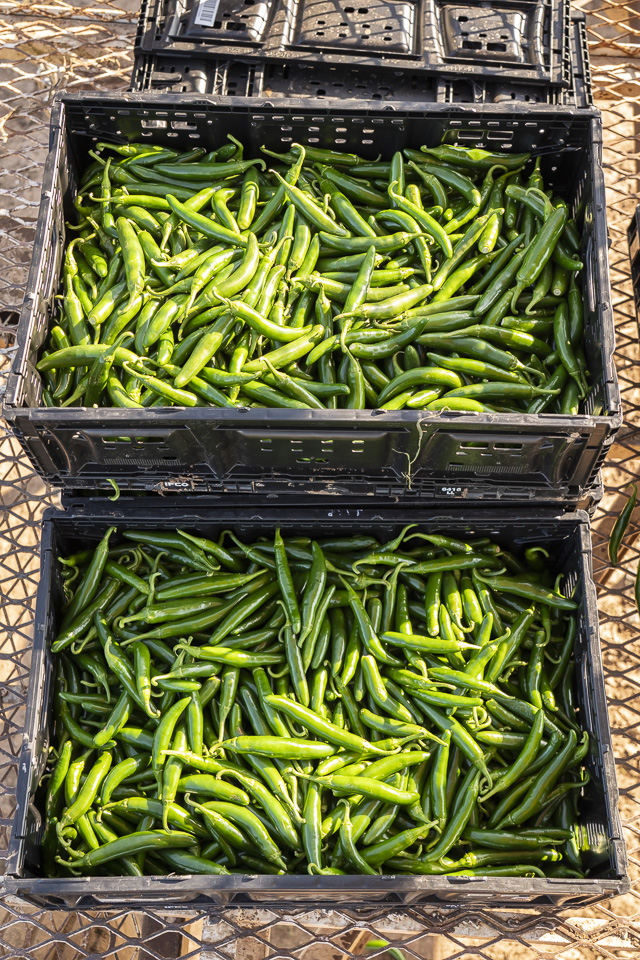 Plenty of peppers. Photo by Scott David Gordon.
Plenty of peppers. Photo by Scott David Gordon.
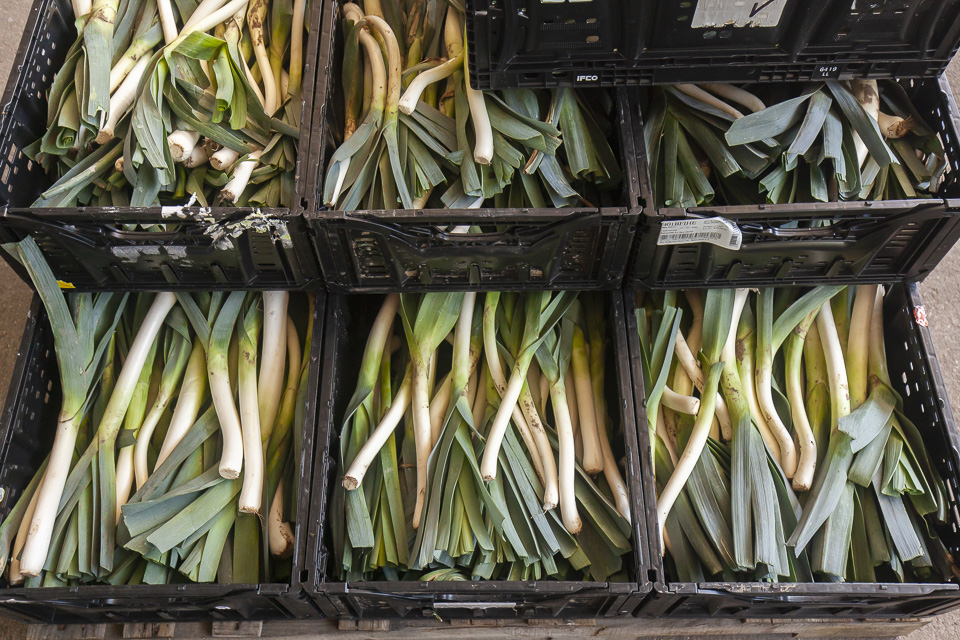 Leeks, the more temporal allium of the season, showing off their pale hues and long curves. Photo by Scott David Gordon.
Leeks, the more temporal allium of the season, showing off their pale hues and long curves. Photo by Scott David Gordon.
Week of 5.15.20 Photos
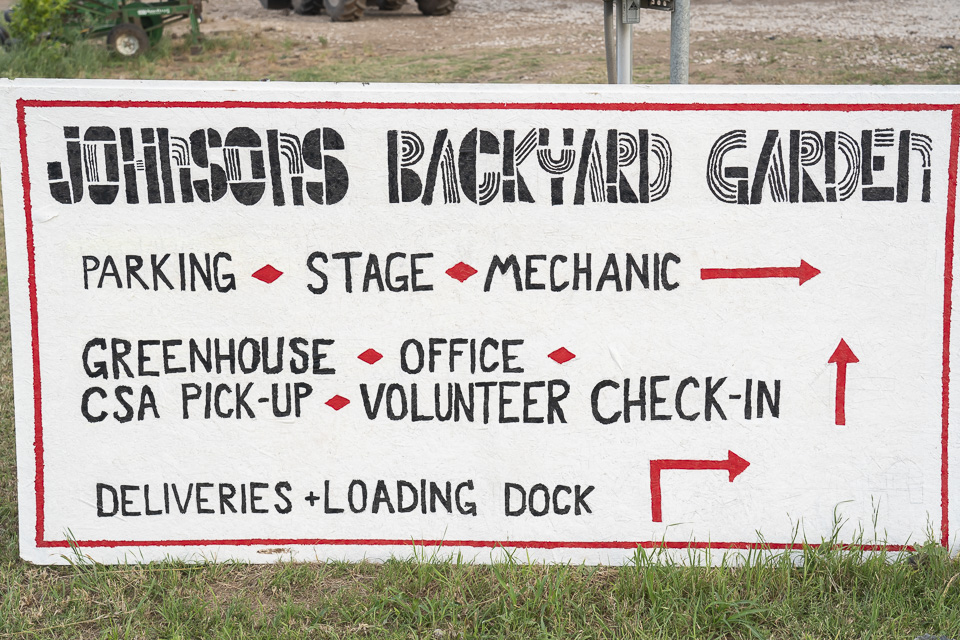 New sign at the Garfield Farm so the volunteers don't head to the stage the mechanic doesn't report to the greenhouse. Photo by Scott David Gordon, sign by Adam (we think).
New sign at the Garfield Farm so the volunteers don't head to the stage the mechanic doesn't report to the greenhouse. Photo by Scott David Gordon, sign by Adam (we think).
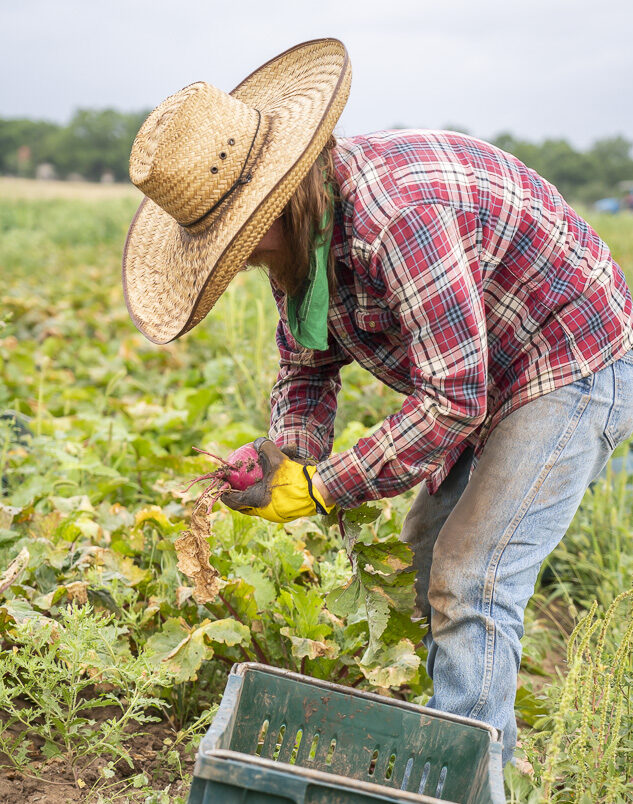 It's straw hat season, y'all! Perhaps it's a surprise to you, but it remains jean and long-sleeve shirt season year round. There is no better way to protect from the sun, bugs, and weeds than coverage! Photo by Scott David Gordon.
It's straw hat season, y'all! Perhaps it's a surprise to you, but it remains jean and long-sleeve shirt season year round. There is no better way to protect from the sun, bugs, and weeds than coverage! Photo by Scott David Gordon.
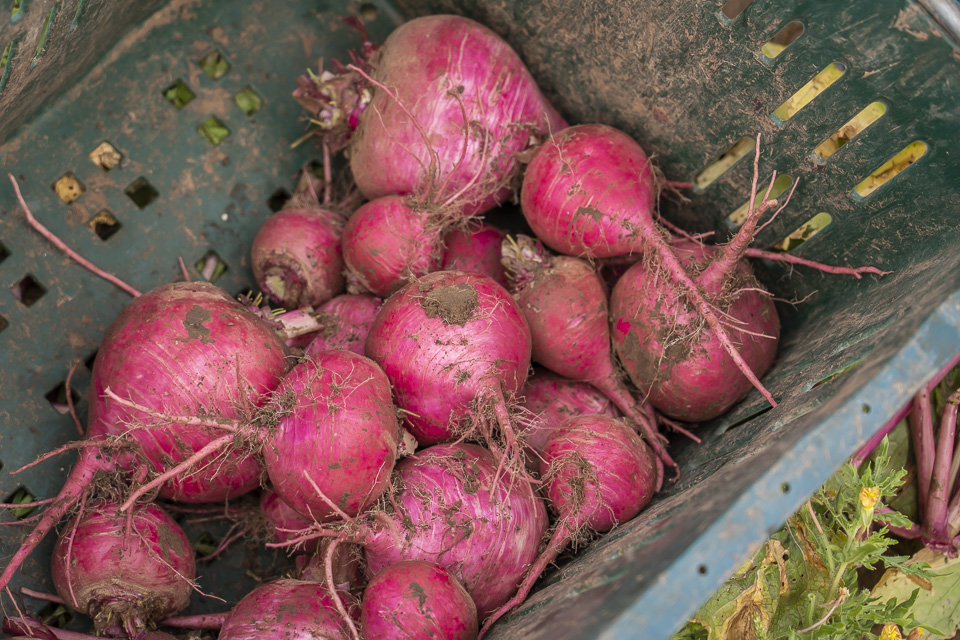 Scarlet turnips, by the bin. Photo by Scott David Gordon.
Scarlet turnips, by the bin. Photo by Scott David Gordon.
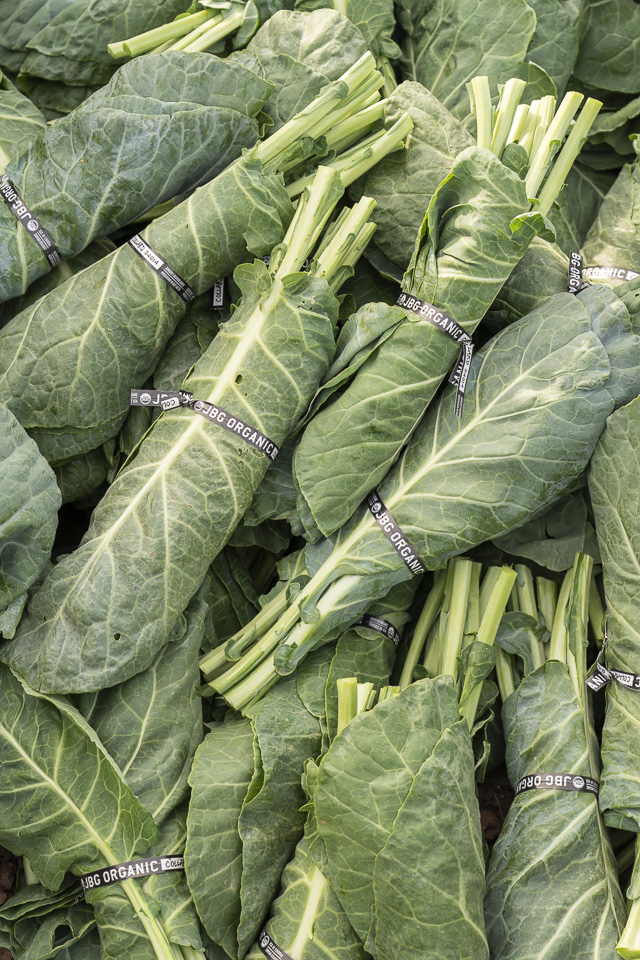 Alternative collard banding, right around the middle. Photo by Scott David Gordon.
Alternative collard banding, right around the middle. Photo by Scott David Gordon.
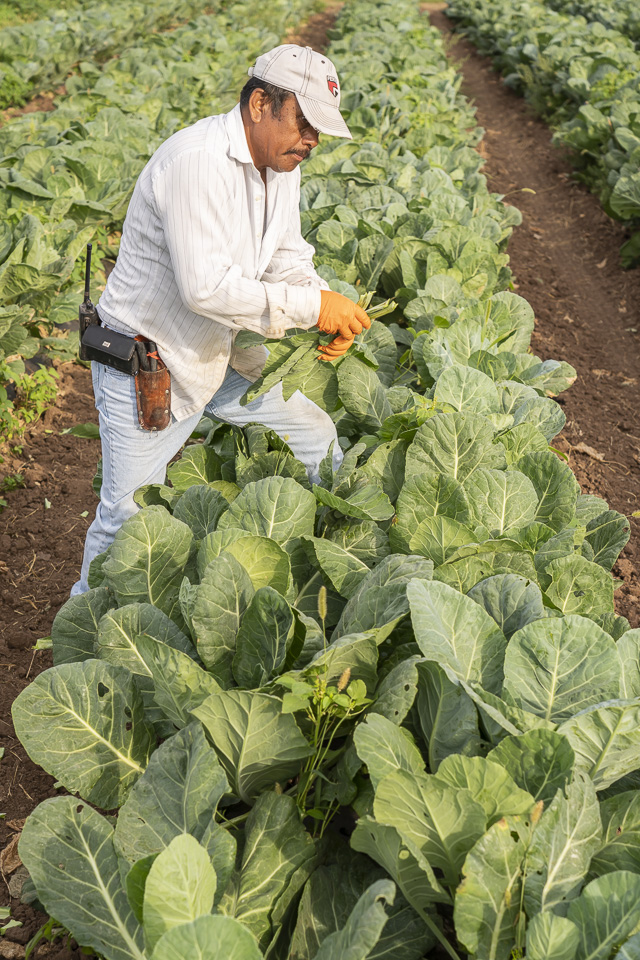 One long row, so many collards. Photo by Scott David Gordon.
One long row, so many collards. Photo by Scott David Gordon.
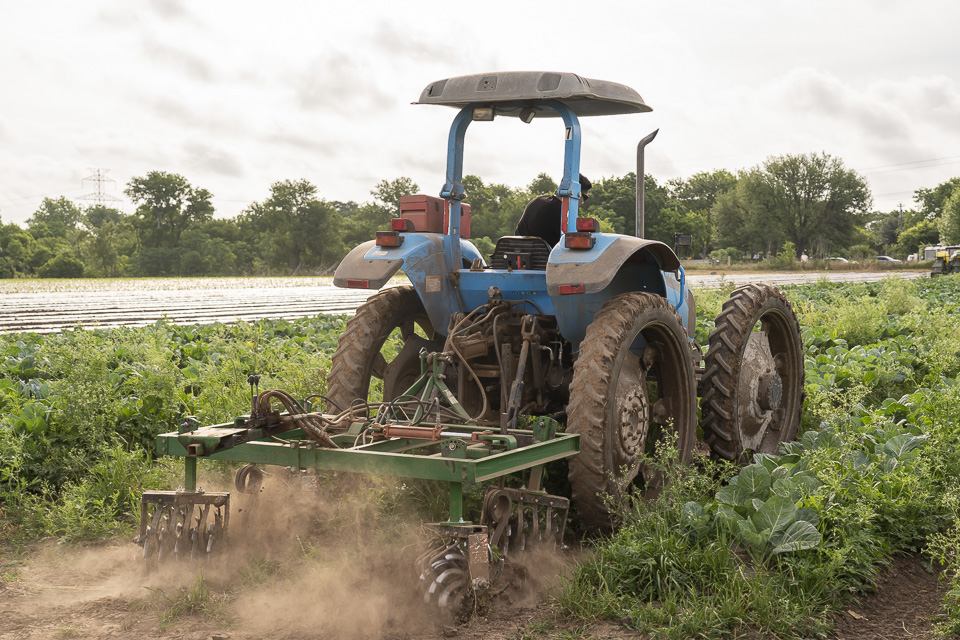 Vicente gets busy cultivating! As temperatures heat up, so does the weed pressure. Photo by Scott David Gordon.
Vicente gets busy cultivating! As temperatures heat up, so does the weed pressure. Photo by Scott David Gordon.
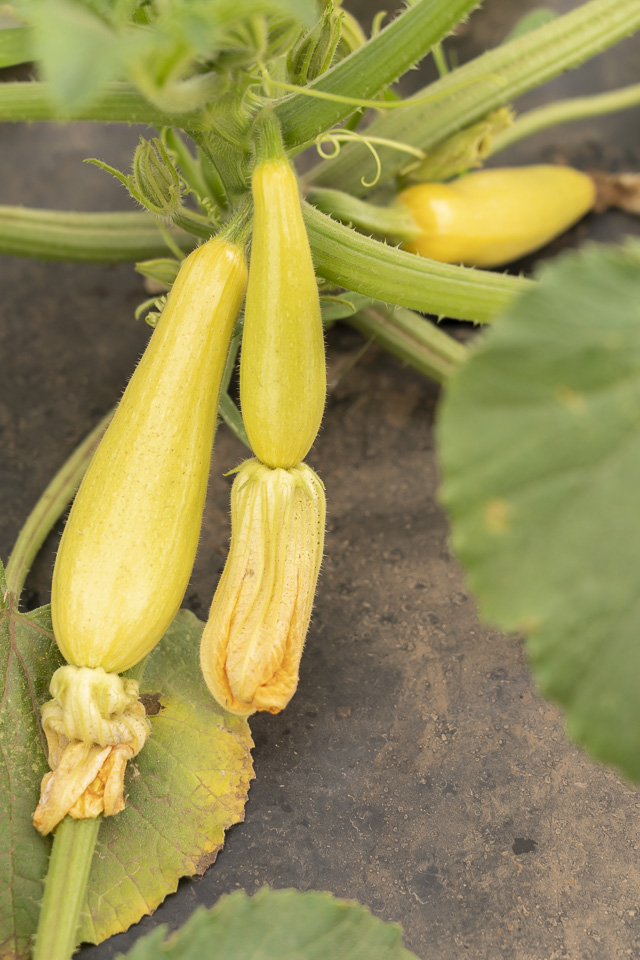 Our very first squash made their debut last week. How beautiful are they!? Photo by Scott David Gordon.
Our very first squash made their debut last week. How beautiful are they!? Photo by Scott David Gordon.
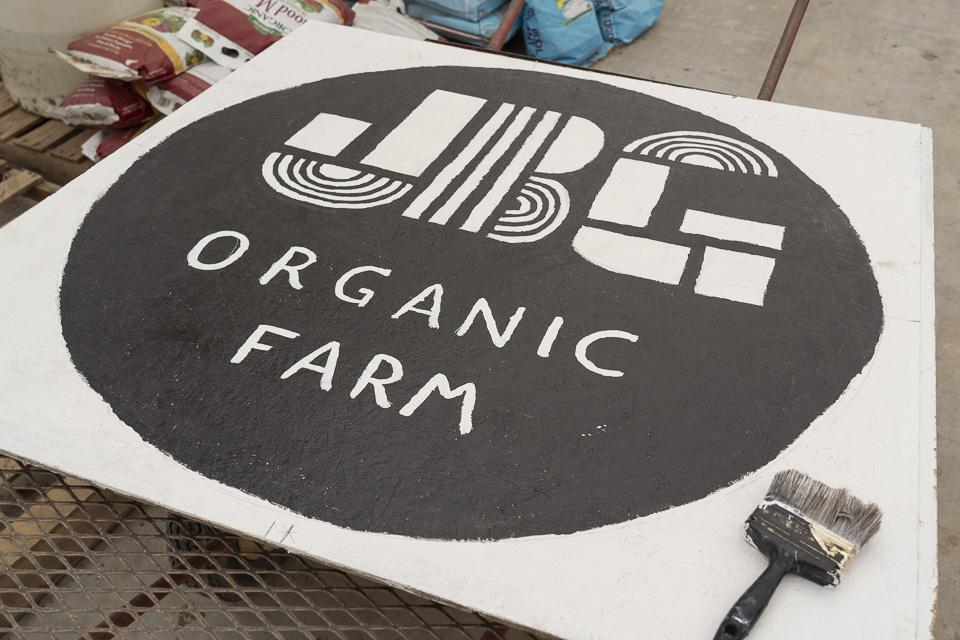 Fun fact? When this logo was designed years ago, the lines in the block letters were inspired by the line of our crop beds. Now that you know, bet you won't forget! Photo by Scott David Gordon.
Fun fact? When this logo was designed years ago, the lines in the block letters were inspired by the line of our crop beds. Now that you know, bet you won't forget! Photo by Scott David Gordon.
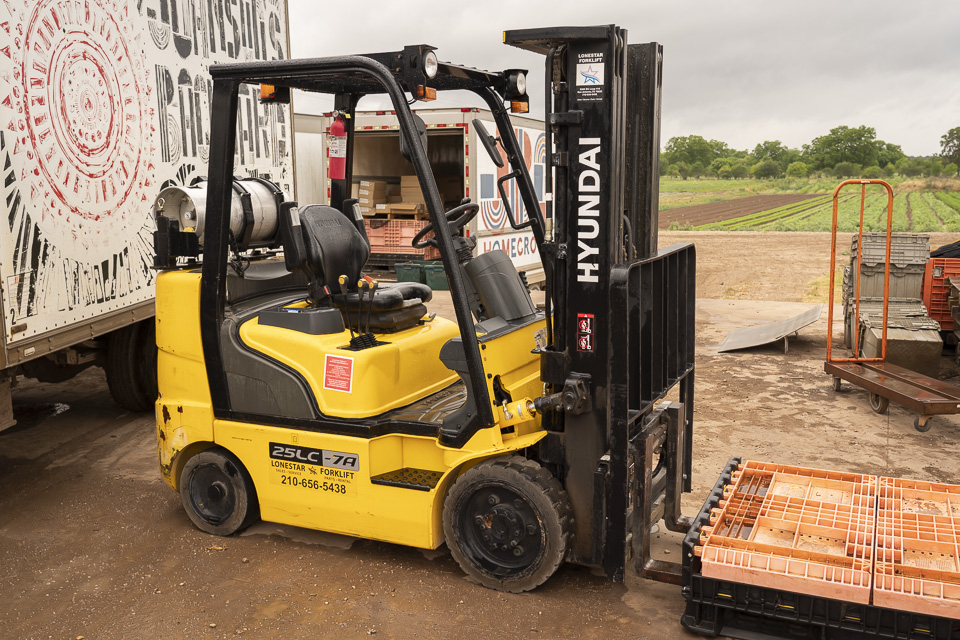 Welcome to the team! New (to us) fork lift for the farm! This is a BIG deal! Photo by Scott David Gordon.
Welcome to the team! New (to us) fork lift for the farm! This is a BIG deal! Photo by Scott David Gordon.
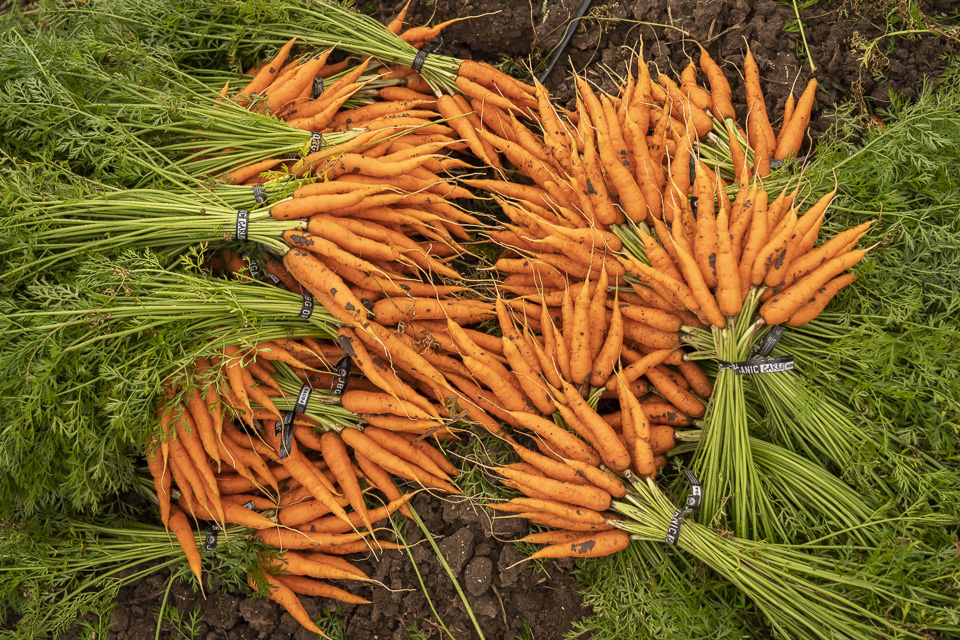 A smattering of orange and green and one of our most popular crops. Photo by Scott David Gordon.
A smattering of orange and green and one of our most popular crops. Photo by Scott David Gordon.
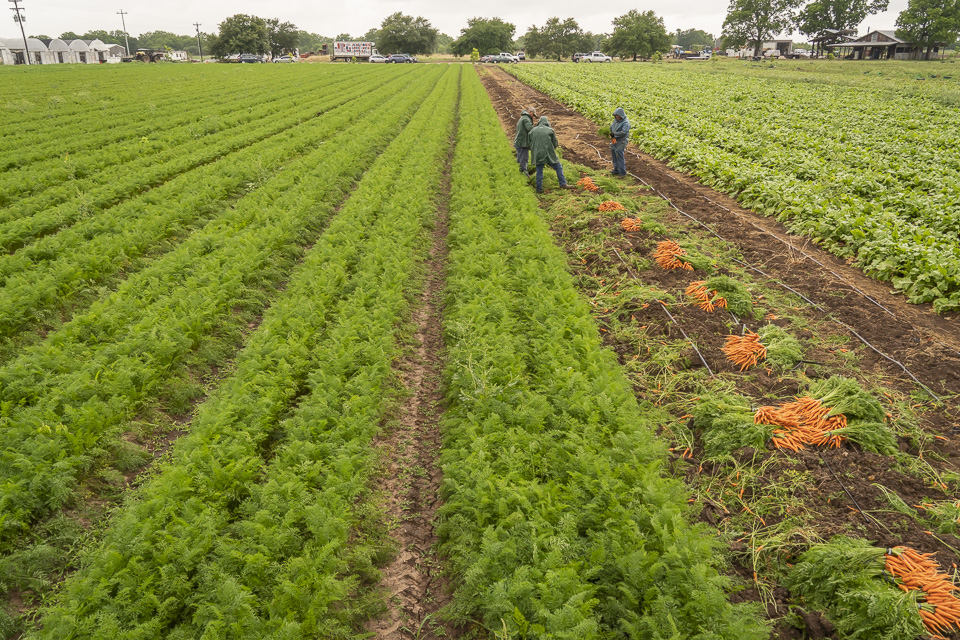 Rainy days, endless carrots. Photo by Scott David Gordon.
Rainy days, endless carrots. Photo by Scott David Gordon.
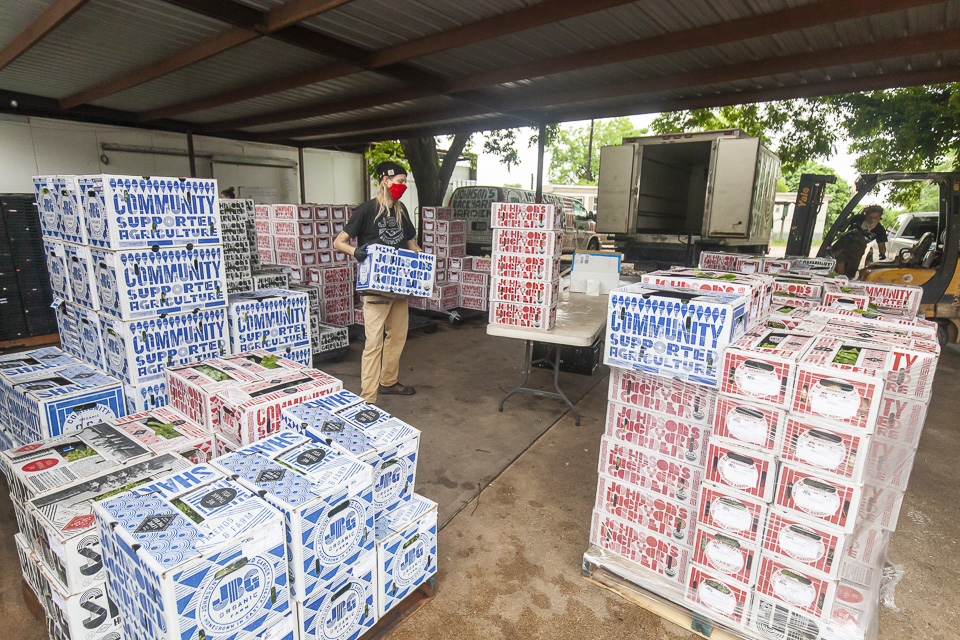 Andrew organizing the city of CSA. Photo by Scott David Gordon.
Andrew organizing the city of CSA. Photo by Scott David Gordon.
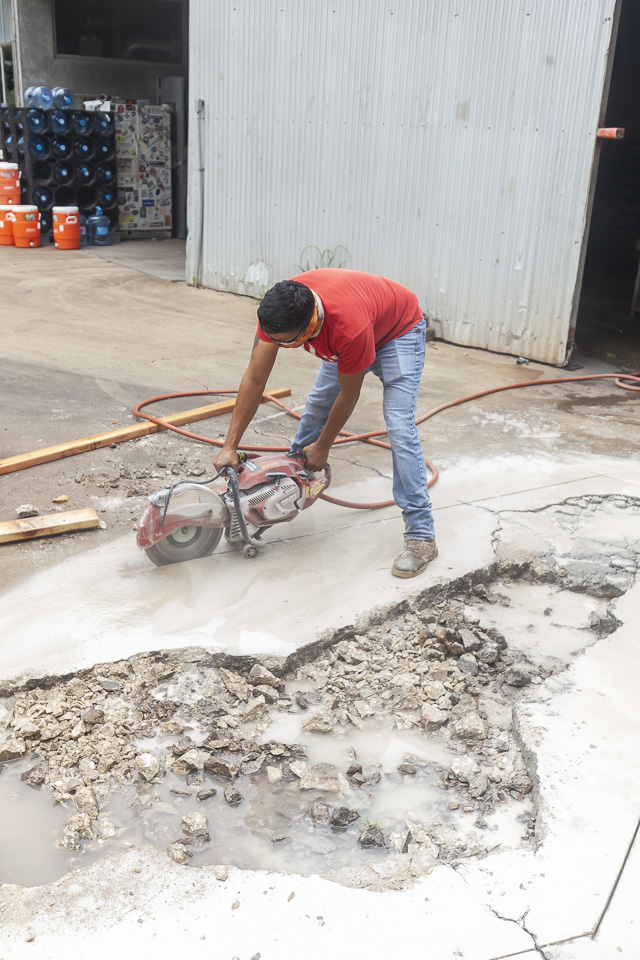 Temo, in the middle of the Hergotz pack shed, addressing a spot in the concrete that was known for spilling multiple carts of beets and towers of turnips. Photo by Scott David Gordon.
Temo, in the middle of the Hergotz pack shed, addressing a spot in the concrete that was known for spilling multiple carts of beets and towers of turnips. Photo by Scott David Gordon.
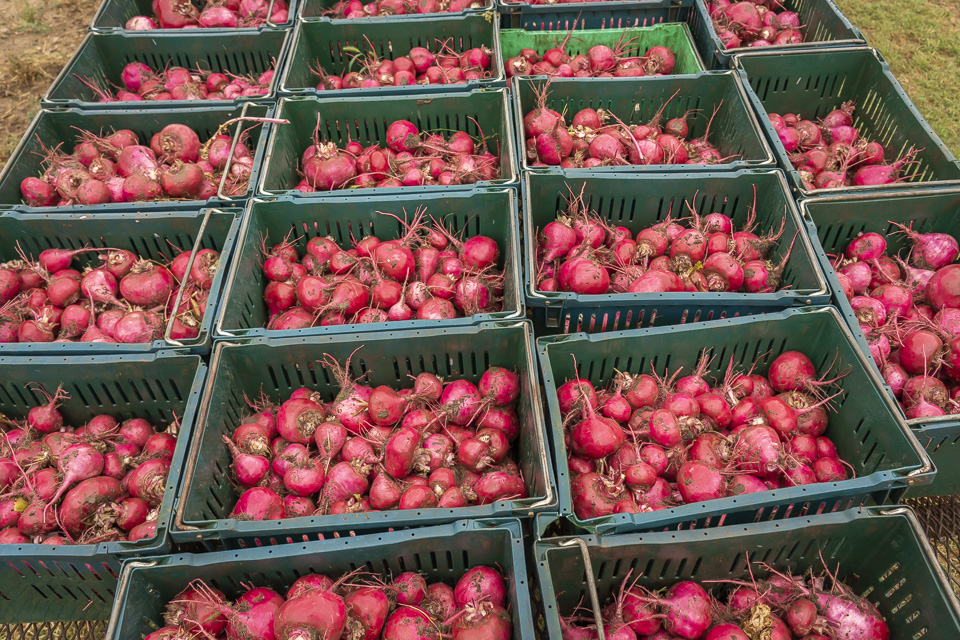 The pink and the green are complementary colors, but we swear we didn't plan it. Photo by Scott David Gordon.
The pink and the green are complementary colors, but we swear we didn't plan it. Photo by Scott David Gordon.
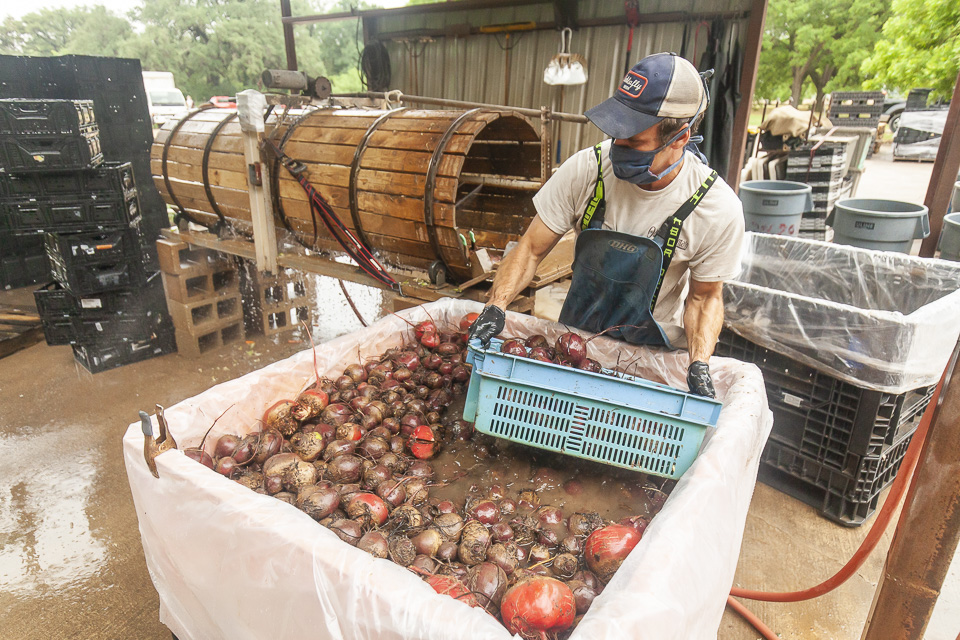 Bulk beets get harvested into these big bins, and then washed in our nifty-difty barrel washer. Photo by Scott David Gordon.
Bulk beets get harvested into these big bins, and then washed in our nifty-difty barrel washer. Photo by Scott David Gordon.
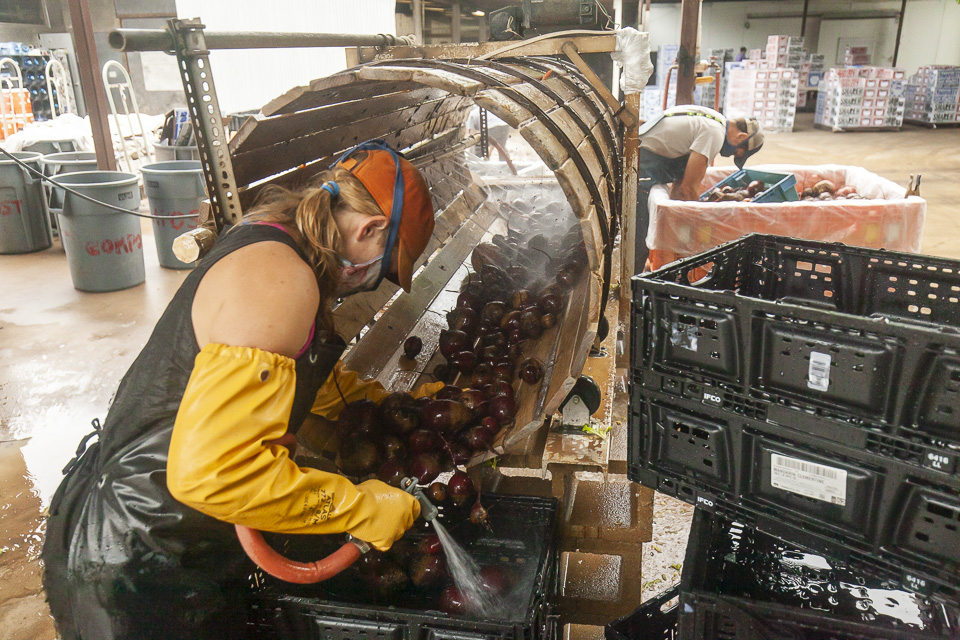 Here the come, out the other side! Photo by Scott David Gordon.
Here the come, out the other side! Photo by Scott David Gordon.
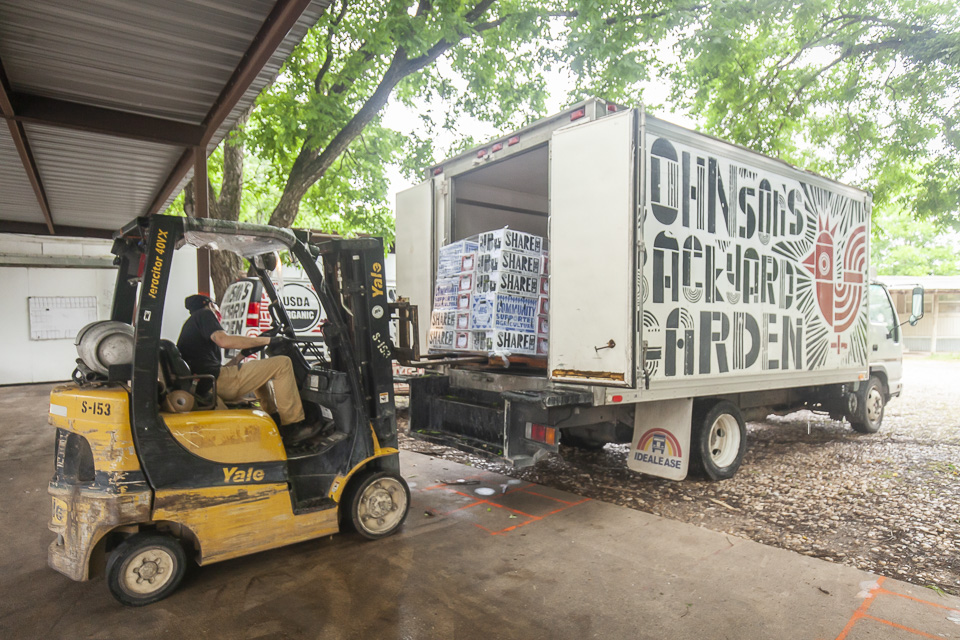 Veggies sorted, washed, packed, and ready for their final home. Hopefully it's your dinner plate! Photo by Scott David Gordon.
Veggies sorted, washed, packed, and ready for their final home. Hopefully it's your dinner plate! Photo by Scott David Gordon.CSA BOX CONTENTS WEEK OF MAY 25TH
05/25/20 — Scott
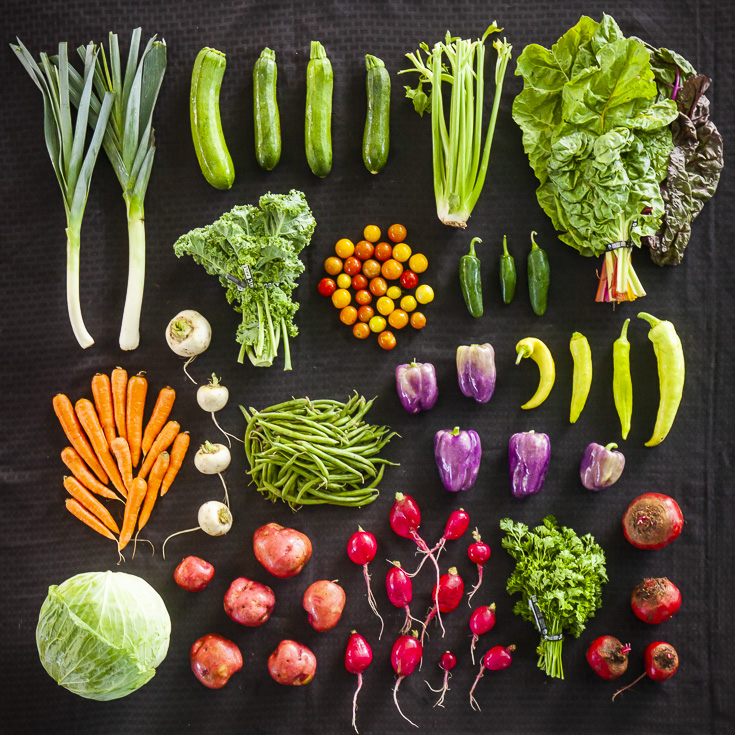 CSA Box Contents Week of May 25th
CSA Box Contents Week of May 25th
Large Box
Bean, Green
Beets
Cabbage
Carrots
Celery
Cucumber
Herb, Farmers Choice
Leek
Okra
Pepper, Hot Medley
Radish, Watermelon
Squash, Farmer's Choice
Tomato
Bean, Green
Beets
Cabbage
Carrots
Celery
Cucumber
Herb, Farmers Choice
Leek
Okra
Pepper, Hot Medley
Radish, Watermelon
Squash, Farmer's Choice
Tomato
Medium Box
Bean, Green
Beets
Cabbage
Cucumber
Greens, Chard, Rainbow
Greens, Collards
Herb, Farmers Choice
Leek
Radish, Watermelon
Tomato
Bean, Green
Beets
Cabbage
Cucumber
Greens, Chard, Rainbow
Greens, Collards
Herb, Farmers Choice
Leek
Radish, Watermelon
Tomato
Small Box
Beets
Carrots
Herb, Farmers Choice
Leek
Pepper, Sweet
Squash, Farmer's Choice
Tomato
Beets
Carrots
Herb, Farmers Choice
Leek
Pepper, Sweet
Squash, Farmer's Choice
Tomato
Individual Box
Carrots
Celery
Cucumber
Pepper, Sweet
Tomato
Carrots
Celery
Cucumber
Pepper, Sweet
Tomato
CSA BOX CONTENTS WEEK OF MAY 25TH
05/26/20 — Scott
 CSA Box Contents Week of May 25th
CSA Box Contents Week of May 25th
Large Box
Bean, Green
Carrots
Celery
Farmers Choice
Greens, Amaranth
Greens, Chard, Rainbow
Herb, Farmers Choice
Pepper, Sweet
Potato
Radish
Squash / Cucumber
Turnip, White Japanese
LEMONY KOHLRABI FENNEL SLAW WITH HONEY & HERBS
05/28/20 — Ada Broussard
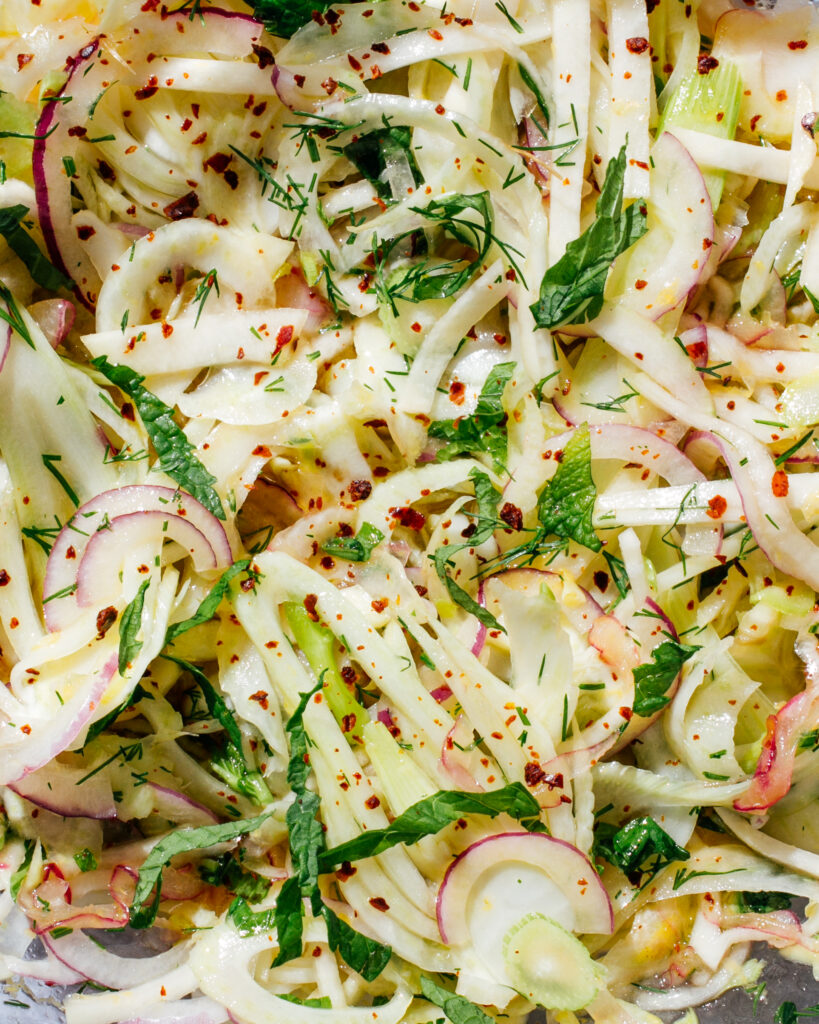
Photo and recipe by Mackenzie Smith
According to the internet, cabbage is expected to be the main ingredient in slaw, but I couldn’t think of a better way to describe this tangy, crunchy kohlrabi & fennel situation with a hit of red onion, sweetened with a little raw honey, flecked with fresh herbs and chili flakes.
Any combination of crunchy fruit and veggies: apple, rutabaga, Asian pear, jicama, and yes, cabbage, work well with this dressing, which can also be endlessly adapted based on what you have on hand. Substitute lime or grapefruit for lemon-- or vinegar for citrus, jam or maple syrup for honey -- use what you have and tweak it till it tastes just right. Keep it crisp, and LMK if you think of a better name than slaw :)
Dressing: 4 tablespoons olive oil Juice and zest from one lemon ½ tablespoon honey 1 teaspoon vinegar ½ teaspoon fine sea salt 1 tablespoon fresh chopped dill
2 kohlrabi, peeled and julienned or grated 2 small fennel bulbs, thinly sliced ½ a small red onion, thinly sliced Chopped mint & dill (or any fresh soft herb) Red pepper flakes
In a large mixing bowl, whisk together the wet ingredients with salt and chopped dill. Add kohlrabi to dressing and stir, then mix in fennel and onions. Top with a handful of fresh chopped herbs. Taste, and add salt if you think you should.
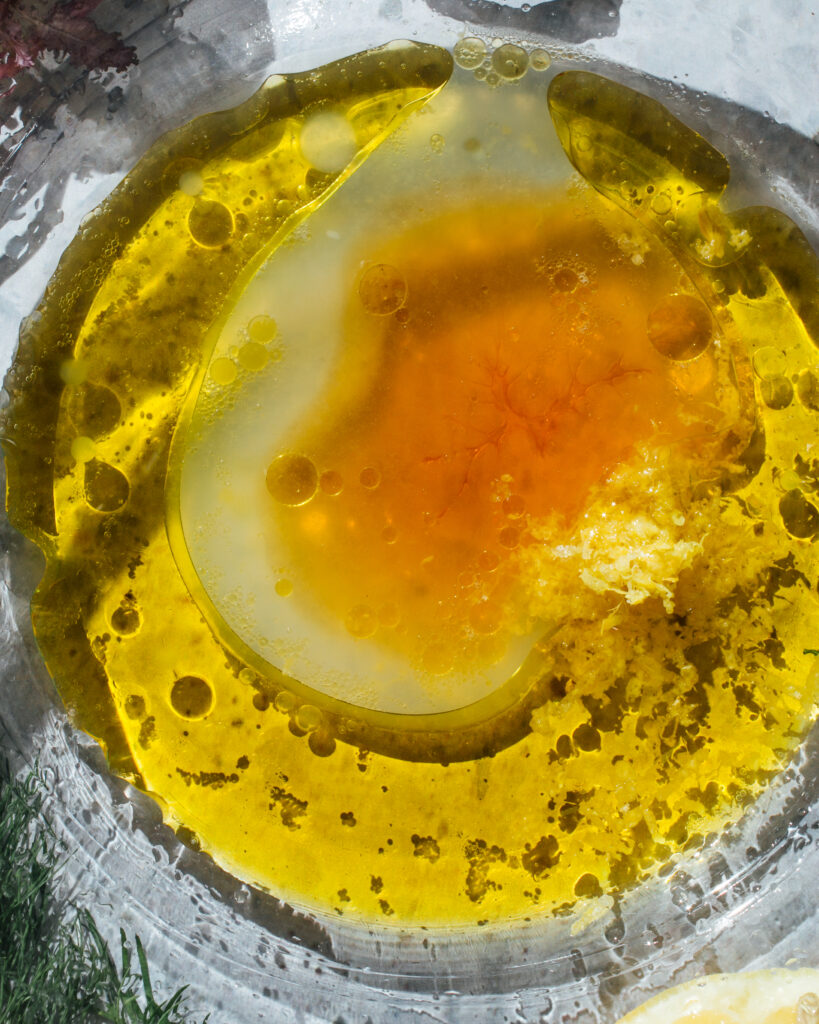
TEXAS FARMERS' MARKETS: A CLOSER LOOK
05/29/20 — Ada Broussard
This week we're giving the mic to our friends at Texas Farmers' Markets. Before we do, a friendly reminder that the 2020 Tomato Presale is still under way! Order your 'maters here, and pick them up at your favorite market! Also! If you're interested in seeing a virtual tour of JBG, be sure to tune in on Monday, June 1st at 10am! We're teaming up with the markets and Farmer Brenton and showing you what we're growing! Without further adieu, a word from Texas Farmers' Markets:
Johnson’s Backyard Garden has been a keystone farm at Texas Farmers’ Markets at Lakeline and Mueller for 10 years. If you are a JBG devotee you may have visited our markets over the years to pick up your CSA box, or to shop from JBG’s beautiful display of seasonal organic produce. We hope that when you stopped by their booth, you also spent some time perusing the market — maybe you picked up a basket of startlingly sweet Fredericksburg peaches, enjoyed a piping hot cup of locally roasted coffee, bit into a crunchy baguette still warm from the oven, chatted with a cheesemaker over a sample of chevre, or listened to some tunes by the local musicians that performed on our center stage. We pride ourselves on being a pillar of the local sustainable agriculture community and that is reflected in our nonprofit’s policies as a year-round, producer-only market with strict rules around sustainability and the humane treatment of animals.
![]() Photo of our market staff adapting to COVID-19 by Annie Ray. Checkout her Instagram to see beautiful portrait shots of food industry workers, all around town.
Photo of our market staff adapting to COVID-19 by Annie Ray. Checkout her Instagram to see beautiful portrait shots of food industry workers, all around town.
As is true for so many these days, our operations have been turned on their head by COVID-19 and our markets look rather different than the festive gathering spot you know and love. From the very beginning of the pandemic, our city government recognized what an important role farmers’ markets play in feeding Austinies and supporting the local economy and we have remained open. But in order for our farmers’ markets to continue to serve our community, we had to enact many changes to keep our staff, market vendors and shoppers safe.
Prior to the COVID-19 pandemic, during an average week our two markets hosted over 130 unique local farmers, ranchers, and small business owners, and welcomed over 10,000 shoppers. Since the pandemic hit, we are seeing 70-80 vendors continuing to sell at our markets and around 4,000 customers per weekend. Needless to say, we are open but operating at a much reduced capacity. But we are so thankful for our amazing vendors that are continuing to sell at our markets and provide shoppers with a safe, fresh and healthy supply of local food. And we are so lucky to have so many devoted shoppers who recognize how critical sustainable food is for keeping a population healthy. Now more than ever we are witnessing how vital the ties across the local food movement are for ensuring a resilient community.
![]()
But while our vendor and shopper counts are low, our staffing and supply costs have gone up. Our markets employ 4 full time staff members that work throughout the week to ensure that our markets run smoothly every weekend, that vendors get the information they need to set up safely, and that shoppers know what to expect when they arrive at our markets. Our core team does everything: from checking health department permits, to crafting market layouts, to running farm inspections, to working with the Sustainable Food Center on food access, to answering social media questions, to running crisis management, and so much more. Prior to the pandemic our core team members already worked from home outside of their time at the market, but the day to day tasks of our team have shifted in many different ways in order to keep things running smoothly during this difficult time.
In addition to our core team, our markets employ 15 part time crew who do jobs like set up tents, distribute food stamps, sanitize work stations, haul trash and manage a totally new market setup now that COVID-19 has impacted our community. Our markets would not be running if it were not for their flexibility and bravery to still be working customer-facing positions each and every week. Truly, their jobs have changed in almost every way since the start of the pandemic, and they amazingly rolled with the punches. For example, while our markets used to be a place of free-flowing entry, we now must put caution tape around the perimeter and have very specific designated entrances and exits in order to manage the number of people inside the market, sanitize every person’s hands and check for the required face mask of every person. Just monitoring customer entry takes a lot of market staff!
![]()
Our team feels incredibly lucky to have been able to retain all of our staff (and have actually increased our at-market team member presence) and keep going, but staying open also means our supply costs for running the markets have increased. We now need items we never had to account for in the past — for example every month we use four gallons of hand sanitizer ($240), four boxes of gloves ($70) and six rolls of caution tape ($50). But while staff and supply costs have gone up, our market’s revenue has gone down. Many people don’t know that the farmers’ market is a nonprofit organization and our operating budget is generated through weekly booth fees, local business sponsorships and government grants. Our vendors pay on a graduated fee scale, where farmers and ranchers pay the least amount, and as we have seen our weekly vendor numbers cut in half, as well as our sponsorships dry up, our financial picture is less than rosey. That is why, for the first time in our organization’s ten year history, we are asking the public for donations.
We are asking that if you love the farmers’ market, send us a few dollars and help us fill up our lemonade jug. Whether you have $5 or $500, every amount counts. Have you enjoyed live music at the market? Dropped off compost in our community compost station? Learned how to make sourdough bread or kimchi in a workshop at the Austin Fermentation Festival? Tasted a delicious sample of something seasonal our market chef has cooked up in the demo tent? Made a birdseed ball in the kids area for Earth Day? These are all activities our farmers’ market has provided to the public free of charge over the years, and we hope to be able to run all of these activities again soon. But unless we are able to raise $30,000 by July 30, we may never be able to reinstate some of these programs ever again. Simply put, our organization is struggling to keep our markets open to put food on your plates and we are asking for community support.
![]()
While we can’t offer physical donation thank you gifts, we want to offer something in return for supporting our markets. That is why this month we are running behind the scenes Instagram Live tours on the farmers’ market Instagram page (@TexasFarmersMarket) with some of your favorite market farmers. Join us for 30-minute tours where we talk shop, play with goats, give home gardening tips and even take audience questions. On June 1 at 10am we will be doing a tour with JBG! Other dates include June 4th at 10am with Belle Vie Farm, June 17th at 10am with Shirttail Creek Farm and June 25th at 10am with B5 Farm. If you can’t catch the live videos, not to worry, they will be posted on the market’s Instagram TV channel. If you don’t have the means to donate but want to support the market, why not share info about the tours and invite others to join us?
During this crisis we have been continuously bowled over by the support our community has shown our markets. Y’all have kept us going through an incredibly difficult time. Thank you for being market shoppers and helping Texas Farmers’ Market continue to run safely!
![]() Photo of Nora by Riley Blanks via Austion Women. Thank you, Nora, for sharing an insiders look into what it takes to keep our markets running!
Photo of Nora by Riley Blanks via Austion Women. Thank you, Nora, for sharing an insiders look into what it takes to keep our markets running!
Johnson’s Backyard Garden has been a keystone farm at Texas Farmers’ Markets at Lakeline and Mueller for 10 years. If you are a JBG devotee you may have visited our markets over the years to pick up your CSA box, or to shop from JBG’s beautiful display of seasonal organic produce. We hope that when you stopped by their booth, you also spent some time perusing the market — maybe you picked up a basket of startlingly sweet Fredericksburg peaches, enjoyed a piping hot cup of locally roasted coffee, bit into a crunchy baguette still warm from the oven, chatted with a cheesemaker over a sample of chevre, or listened to some tunes by the local musicians that performed on our center stage. We pride ourselves on being a pillar of the local sustainable agriculture community and that is reflected in our nonprofit’s policies as a year-round, producer-only market with strict rules around sustainability and the humane treatment of animals.
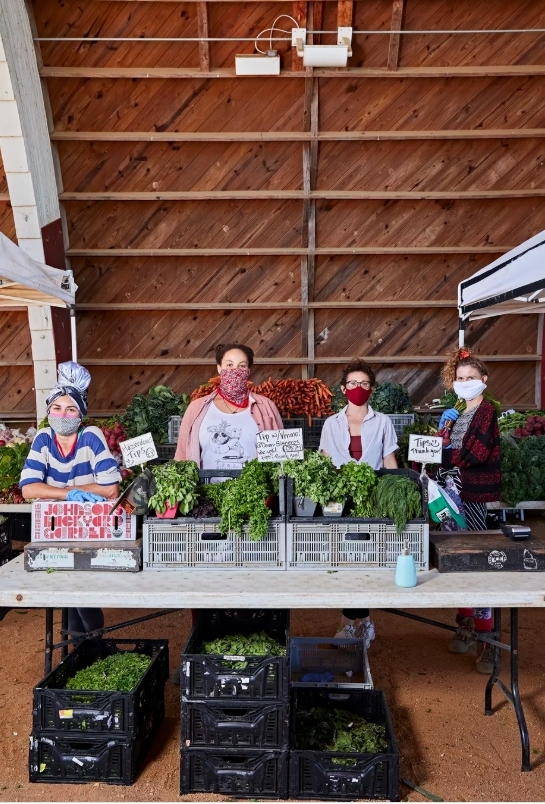 Photo of our market staff adapting to COVID-19 by Annie Ray. Checkout her Instagram to see beautiful portrait shots of food industry workers, all around town.
Photo of our market staff adapting to COVID-19 by Annie Ray. Checkout her Instagram to see beautiful portrait shots of food industry workers, all around town.
As is true for so many these days, our operations have been turned on their head by COVID-19 and our markets look rather different than the festive gathering spot you know and love. From the very beginning of the pandemic, our city government recognized what an important role farmers’ markets play in feeding Austinies and supporting the local economy and we have remained open. But in order for our farmers’ markets to continue to serve our community, we had to enact many changes to keep our staff, market vendors and shoppers safe.
Prior to the COVID-19 pandemic, during an average week our two markets hosted over 130 unique local farmers, ranchers, and small business owners, and welcomed over 10,000 shoppers. Since the pandemic hit, we are seeing 70-80 vendors continuing to sell at our markets and around 4,000 customers per weekend. Needless to say, we are open but operating at a much reduced capacity. But we are so thankful for our amazing vendors that are continuing to sell at our markets and provide shoppers with a safe, fresh and healthy supply of local food. And we are so lucky to have so many devoted shoppers who recognize how critical sustainable food is for keeping a population healthy. Now more than ever we are witnessing how vital the ties across the local food movement are for ensuring a resilient community.
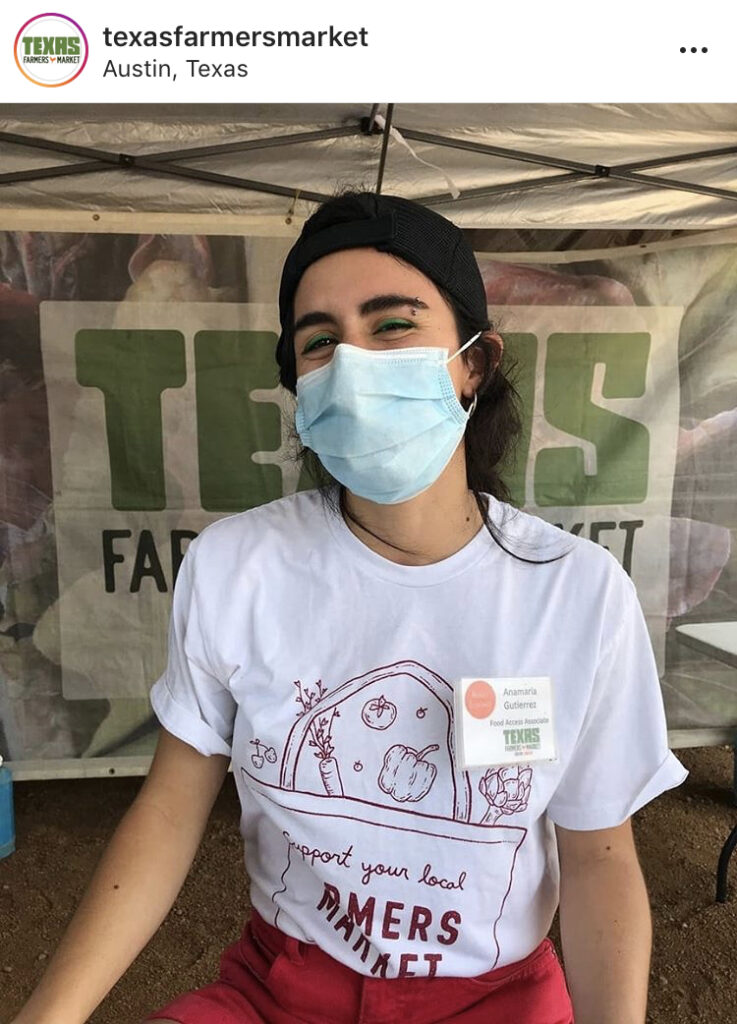
But while our vendor and shopper counts are low, our staffing and supply costs have gone up. Our markets employ 4 full time staff members that work throughout the week to ensure that our markets run smoothly every weekend, that vendors get the information they need to set up safely, and that shoppers know what to expect when they arrive at our markets. Our core team does everything: from checking health department permits, to crafting market layouts, to running farm inspections, to working with the Sustainable Food Center on food access, to answering social media questions, to running crisis management, and so much more. Prior to the pandemic our core team members already worked from home outside of their time at the market, but the day to day tasks of our team have shifted in many different ways in order to keep things running smoothly during this difficult time.
In addition to our core team, our markets employ 15 part time crew who do jobs like set up tents, distribute food stamps, sanitize work stations, haul trash and manage a totally new market setup now that COVID-19 has impacted our community. Our markets would not be running if it were not for their flexibility and bravery to still be working customer-facing positions each and every week. Truly, their jobs have changed in almost every way since the start of the pandemic, and they amazingly rolled with the punches. For example, while our markets used to be a place of free-flowing entry, we now must put caution tape around the perimeter and have very specific designated entrances and exits in order to manage the number of people inside the market, sanitize every person’s hands and check for the required face mask of every person. Just monitoring customer entry takes a lot of market staff!
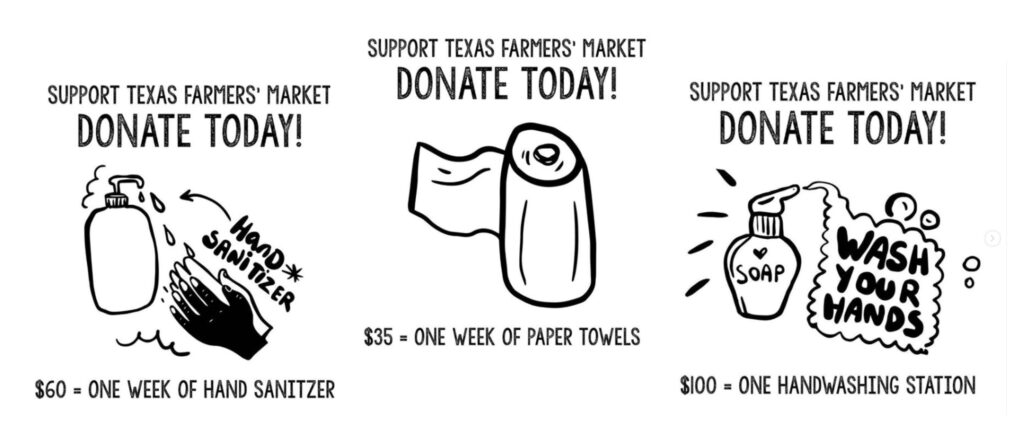
Our team feels incredibly lucky to have been able to retain all of our staff (and have actually increased our at-market team member presence) and keep going, but staying open also means our supply costs for running the markets have increased. We now need items we never had to account for in the past — for example every month we use four gallons of hand sanitizer ($240), four boxes of gloves ($70) and six rolls of caution tape ($50). But while staff and supply costs have gone up, our market’s revenue has gone down. Many people don’t know that the farmers’ market is a nonprofit organization and our operating budget is generated through weekly booth fees, local business sponsorships and government grants. Our vendors pay on a graduated fee scale, where farmers and ranchers pay the least amount, and as we have seen our weekly vendor numbers cut in half, as well as our sponsorships dry up, our financial picture is less than rosey. That is why, for the first time in our organization’s ten year history, we are asking the public for donations.
We are asking that if you love the farmers’ market, send us a few dollars and help us fill up our lemonade jug. Whether you have $5 or $500, every amount counts. Have you enjoyed live music at the market? Dropped off compost in our community compost station? Learned how to make sourdough bread or kimchi in a workshop at the Austin Fermentation Festival? Tasted a delicious sample of something seasonal our market chef has cooked up in the demo tent? Made a birdseed ball in the kids area for Earth Day? These are all activities our farmers’ market has provided to the public free of charge over the years, and we hope to be able to run all of these activities again soon. But unless we are able to raise $30,000 by July 30, we may never be able to reinstate some of these programs ever again. Simply put, our organization is struggling to keep our markets open to put food on your plates and we are asking for community support.
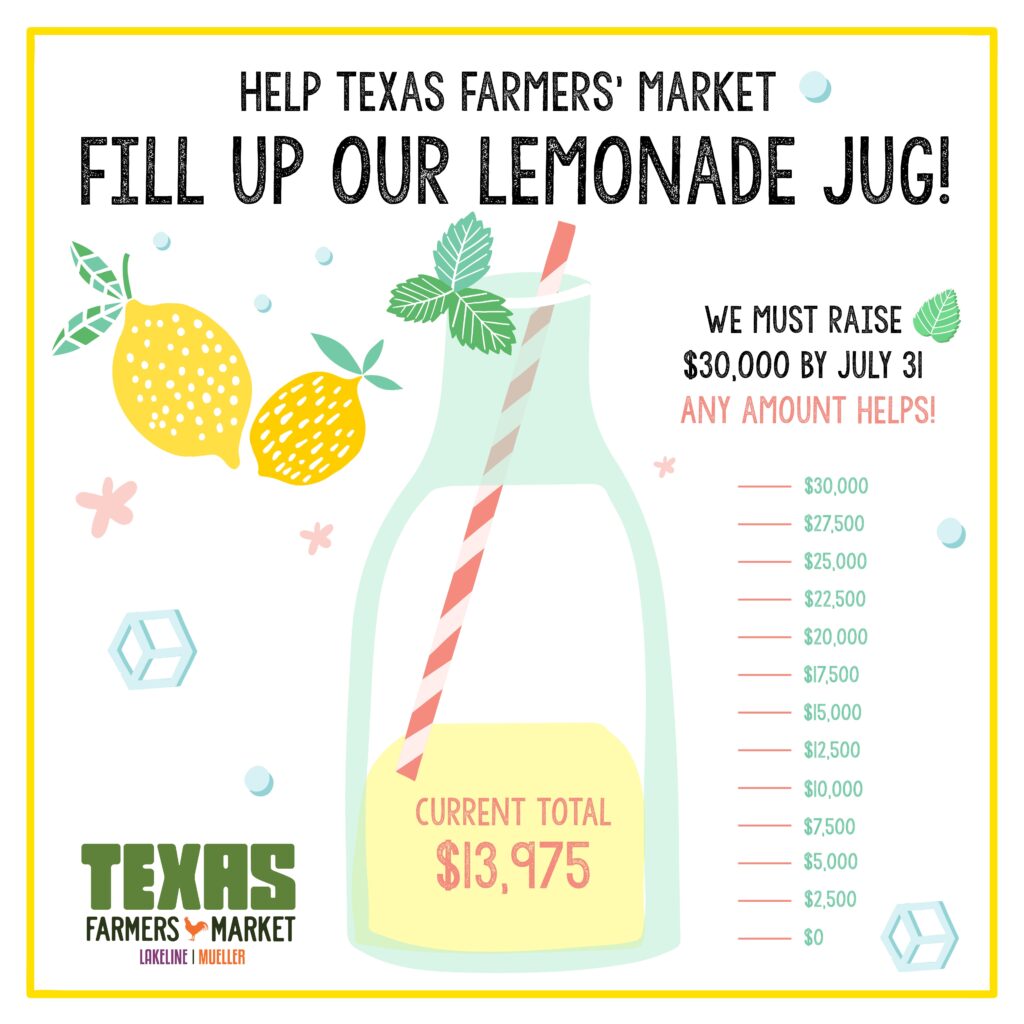
While we can’t offer physical donation thank you gifts, we want to offer something in return for supporting our markets. That is why this month we are running behind the scenes Instagram Live tours on the farmers’ market Instagram page (@TexasFarmersMarket) with some of your favorite market farmers. Join us for 30-minute tours where we talk shop, play with goats, give home gardening tips and even take audience questions. On June 1 at 10am we will be doing a tour with JBG! Other dates include June 4th at 10am with Belle Vie Farm, June 17th at 10am with Shirttail Creek Farm and June 25th at 10am with B5 Farm. If you can’t catch the live videos, not to worry, they will be posted on the market’s Instagram TV channel. If you don’t have the means to donate but want to support the market, why not share info about the tours and invite others to join us?
During this crisis we have been continuously bowled over by the support our community has shown our markets. Y’all have kept us going through an incredibly difficult time. Thank you for being market shoppers and helping Texas Farmers’ Market continue to run safely!
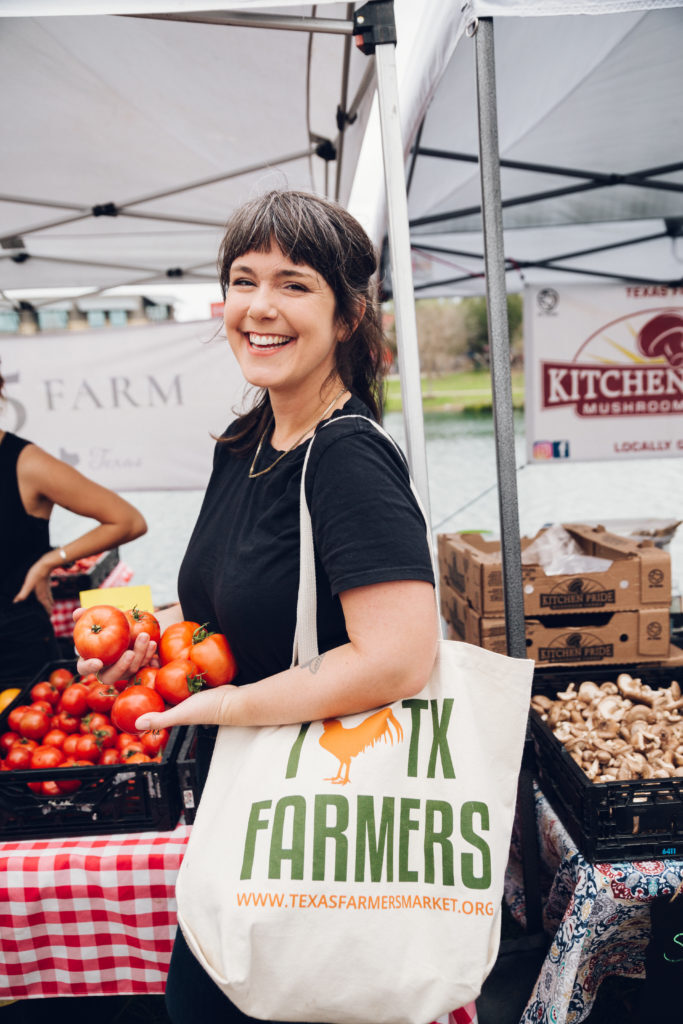 Photo of Nora by Riley Blanks via Austion Women. Thank you, Nora, for sharing an insiders look into what it takes to keep our markets running!
Photo of Nora by Riley Blanks via Austion Women. Thank you, Nora, for sharing an insiders look into what it takes to keep our markets running!





 0 ITEMS IN CART
0 ITEMS IN CART 

